D Link SL2640BB3 WIRELESS ADSL2+ User Manual DSL 2640B UserMan
D Link Corporation WIRELESS ADSL2+ DSL 2640B UserMan
D Link >
Users Manual
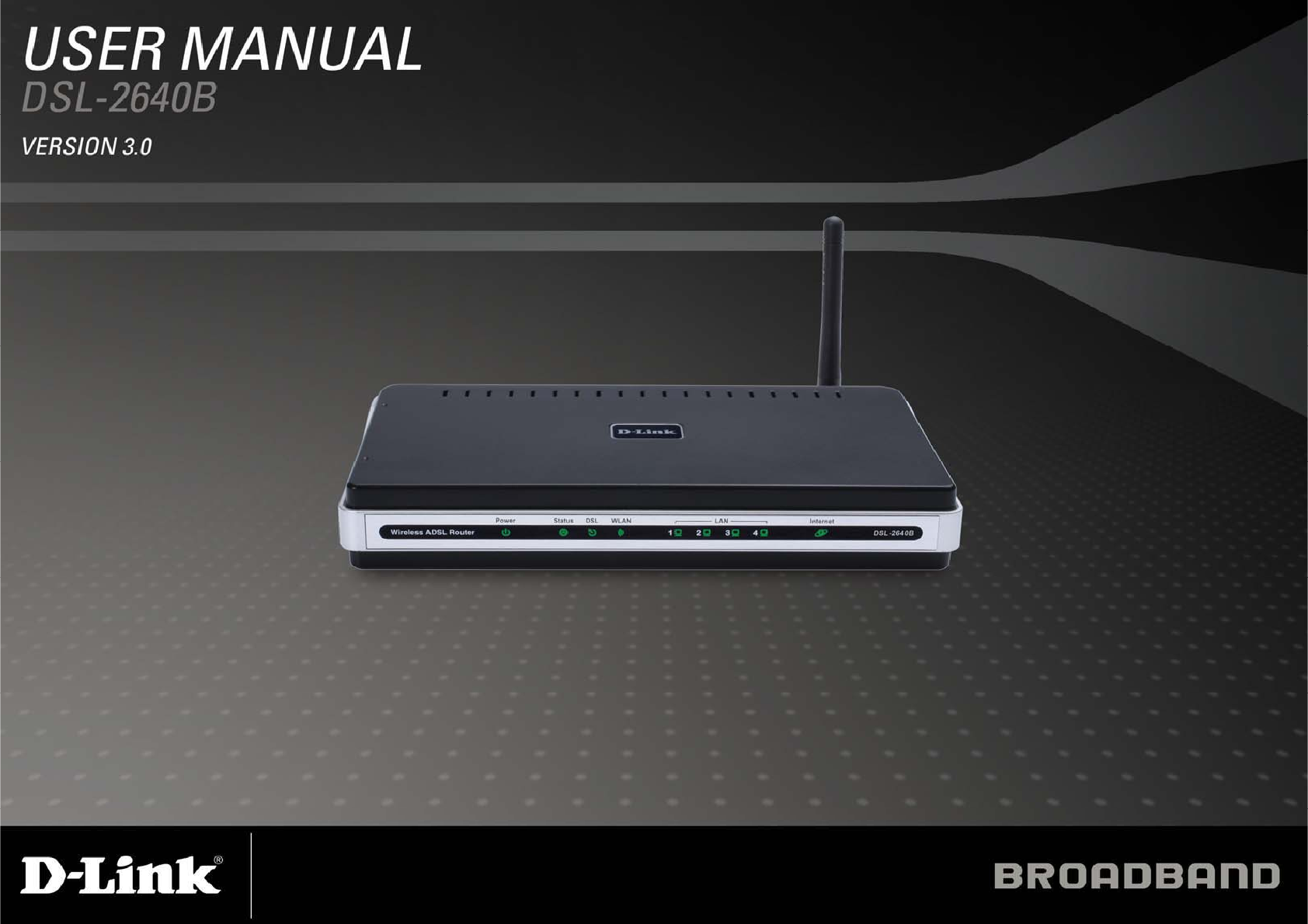
Table of Content
D-Link DSL-2640B User Manual 1

Table of Content
er 2
D-Link DSL-2640B Us Manual
Table of Contents
PRODUCT OVERVIEW ................................................................................................3
PACKAGE CONTENTS .....................................................................................................3
SYSTEM REQUIREMENTS ................................................................................................3
INTRODUCTION ..............................................................................................................4
FEATURES ......................................................................................................................5
HARDWARE OVERVIEW .................................................................................................6
CONNECTIONS...............................................................................................................6
LEDS.............................................................................................................................7
INSTALLATION .............................................................................................................8
BEFORE YOU BEGIN .......................................................................................................8
INSTALLATION NOTES....................................................................................................9
INFORMATION YOU WILL NEED FROM YOUR ADSL SERVICE PROVIDER ....................... 11
INFORMATION YOU WILL NEED ABOUT DSL-2640B ....................................................13
WIRELESS INSTALLATION CONSIDERATIONS ...............................................................15
DEVICE INSTALLATION ................................................................................................16
POWER ON ROUTER......................................................................................................16
NETWORK CONNECTIONS ............................................................................................17
CONFIGURATION.......................................................................................................19
WEB-BASED CONFIGURATION UTILITY........................................................................19
SETUP ........................................................................................................................20
WIZARD................................................................................................................20
ADSL SETUP.........................................................................................................25
WIRELESS ............................................................................................................27
LAN SETUP...........................................................................................................32
TIME ......................................................................................................................34
PARENTAL CONTROL ........................................................................................35
LOGOUT ...............................................................................................................36
ADVANCED ..............................................................................................................37
PORT FORWARDING...........................................................................................37
APPLICATION RULES.........................................................................................39
QOS SETUP............................................................................................................41
OUTBOUND IP FILTER .......................................................................................45
INBOUND IP FILTER ...........................................................................................46
DNS SETUP........................................................................................................... 47
FIREWALL & DMZ............................................................................................... 49
ADVANCED ADSL............................................................................................... 52
ADVANCED WIRELESS ..................................................................................... 53
ADVANCED LAN ................................................................................................ 54
SNMP SETUP ........................................................................................................ 54
TR-069 ................................................................................................................... 54
REMOTE MANAGEMENT .................................................................................. 54
MAINTENANCE ....................................................................................................... 64
PASSWORD ..........................................................................................................64
SAVE/RESTORE SETTINGS................................................................................65
FIRMWARE UPDATE...........................................................................................66
DIAGNOSTICS .....................................................................................................67
SYSTEM LOG ....................................................................................................... 68
STATUS ...................................................................................................................... 70
DEVICE INFO .......................................................................................................70
CONNECTED CLIENTS.......................................................................................72
STATISTICS .......................................................................................................... 73
ROUTING INFO......................................…………………………………………75
TROUBLESHOOTING ................................................................................................ 75
WIRELESS BASICS ..................................................................................................... 78
NETWORKING BASICS ............................................................................................. 81
CHECK YOUR IP ADDRESS............................................................................................ 81
STATICALLY ASSIGN AN IP ADDRESS........................................................................... 82
TECHNICAL SPECIFICATIONS .............................................................................. 83
CONTACTING TECHNICAL SUPPORT ................................................................. 84
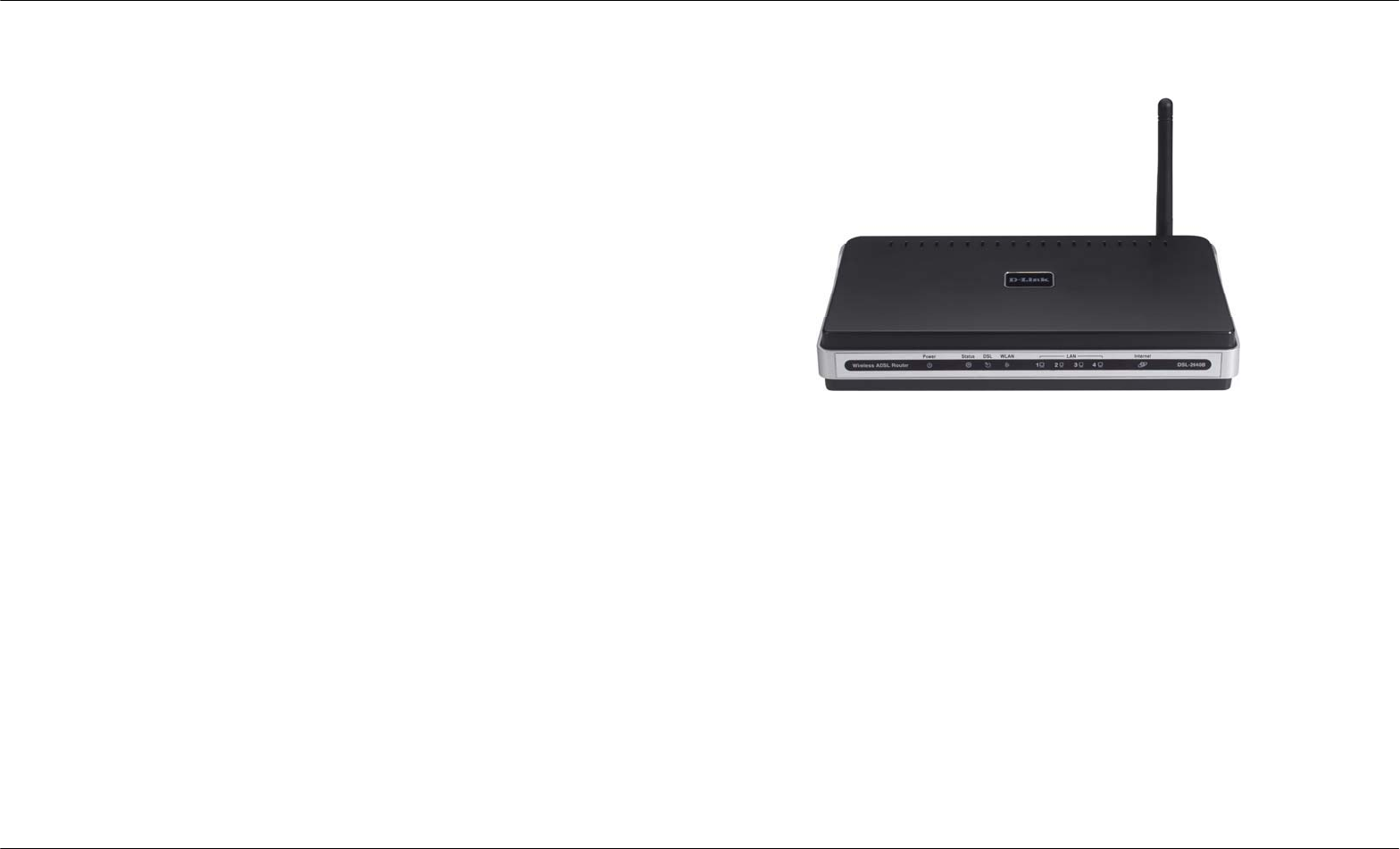
Section 1 - Product Overview
D-Link DSL-2640B User Manual 3
Product Overview
Package Contents
x DSL-2640B Wireless ADSL Router
x 1 Detachable Antenna
x Power Adapter
x CD-ROM with Installation Wizard, User Manual, and Special Offers
x One twisted-pair telephone cable used for ADSL connection
x One straight-through Ethernet cable
x One Quick Installation Guide
Note: Using a power supply with a different voltage rating than the one included
with the DSL-2640B will cause damage and void the warranty for this product.
System Requirements
x ADSL Internet service
x Computer with:
x 200MHz Processor
x 64MB Memory
x CD-ROM Drive
x Ethernet Adapter with TCP/IP Protocol Installed
x Windows XP/2000/98 SE/ME
x Internet Explorer v6 or later, FireFox v1.5
x D-Link Click'n Connect Utility
Computer with Windows 2000/XP x

Section 1 - Product Overview
D-Link DSL-2640B User Manual 4
11
Introduction
HIGH-SPEED ADSL2/2+ INTERNET CONNECTION
Latest ADSL2/2+ standards provide Internet transmission of up to 24Mbps downstream, 1Mbps upstream.
HIGH-PERFORMANCE WIRELESS
Embedded latest 802.11 technology for high-speed wireless connection, complete compatibility with 802.11b wireless devices
TOTAL SECURITY & QoS
Firewall protection from Internet attacks, user access control, WPA/WPA2 wireless security and priority queues for smooth VoIP traffic/streaming multimedia
ULTIMATE INTERNET CONNECTION
The DSL-2640B ADSL2+ router is a versatile, high-performance remote router for home and the small office. With integrated ADSL2/2+ supporting up to 24Mbps
download speed, firewall protection, Quality of Service (QoS), 802.11g wireless LAN and 4 Ethernet switch ports, this router provides all the functions that a
home or small office needs to establish a secure and high-speed remote link to the outside world.
FIREWALL PROTECTION & QoS
Security features prevents unauthorized access to the home and office network, be it from the wireless devices or from the Internet. The router provides firewall
security using Stateful Packet Inspection (SPI) and hacker attack logging for Denial of Service (DoS) attack protection. SPI inspects the contents of all incoming
packet headers before deciding what packets are allowed to pass through. Router access control is provided with packet filtering based on port and
source/destination MAC/IP addresses. For Quality of Service (QoS), the router supports multiple priority queues to enable a group of home or office users to
experience the benefit of smooth network connection of inbound and outbound data without concern of traffic congestion. This QoS support allows users to enjoy
high ADSL transmission for applications such as VoIP and streaming multimedia over the Internet.
*Maximum wireless signal rate derived from IEEE standard 802.11g. Actual data throughput will vary. Network conditions and environmental factors, including volume of network traffic, building
materials and construction, and network overhead, lower actual data throughput rate. Environmental factors will adversely affect wireless signal range.

Section 1 - Product Overview
D-Link DSL-2640B User Manual 5
Features
xFaster Wireless Networking - The DSL-2640B provides up to 270Mbps* wireless connection with other 802.11g wireless clients. This
capability allows users to participate in real-time activities online, such as video streaming, online gaming, and real-time audio.
xCompatible with 802.11b Devices - The DSL-2640B is still fully compatible with the IEEE 802.11b and g standards, so it can connect with
existing 802.11b and g PCI, USB and Cardbus adapters.
xDHCP Support - Dynamic Host Configuration Protocol automatically and dynamically assigns all LAN IP settings to each host on your
network. This eliminates the need to reconfigure every host whenever changes in network topology occur.
xNetwork Address Translation (NAT) - For small office environments, the DSL-2640B allows multiple users on the LAN to access the
Internet concurrently through a single Internet account. This provides Internet access to everyone in the office for the price of a single user.
NAT improves network security in effect by hiding the private network behind one global and visible IP address. NAT address mapping can
also be used to link two IP domains via a LAN-to-LAN connection.
xHigh Performance - Very high rates of data transfer are possible with the Router. Up to 24Mbps downstream bit rate using the G.dmt
standard. (For ADSL2+)
xEasy Installation - The DSL-2640B uses a web-based graphical user interface program for convenient management access and easy set
up. Any common web browser software can be used to manage the Router.
*Maximum wireless signal rate derived from IEEE standard 802.11g. Actual data throughput will vary. Network conditions and environmental factors, including volume of network traffic, building
materials and construction, and network overhead, lower actual data throughput rate. Environmental factors will adversely affect wireless signal range.
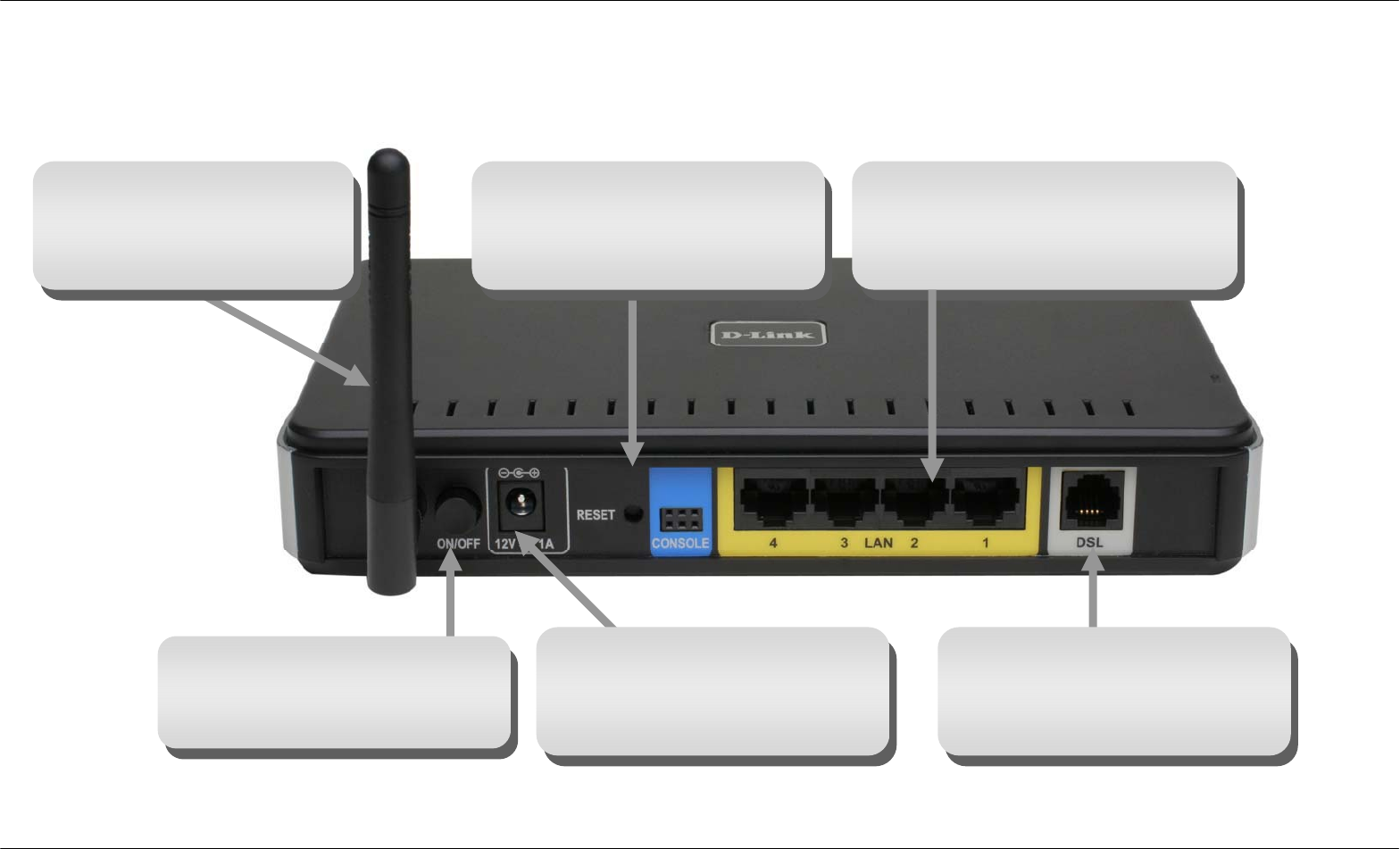
Section 1 - Product Overview
D-Link DSL-2640B User Manual 6
Hardware Overview
Connections
Power button
Push in to power-on the Router.
Push again to power-off the
Router
Ethernet ports
Use the Ethernet ports to connect
the Router to your Ethernet LAN or
Ethernet devices
Reset button
To manually reset, depress
button with the power on for five
to seven seconds
Antenna
For wireless operation, mount
the antenna on the threaded
antenna post.
Power insert
Use the adapter shipped with the
Router to connect to power
source
ADSL port
Use the ADSL cable to connect
to the your telephone line (RJ-11
port)

Section 1 - Product Overview
D-Link DSL-2640B User Manual 7
Hardware Overview
LEDs
Power
Steady green light indicates the
unit is powered on. When the
device is powered off this
remains dark.
DSL
Steady green light indicates a valid ADSL
connection. This will light after the ADSL negotiation
process has been settled. A blinking green light
indicates activity on the WAN (ADSL) interface.
LAN
A solid green light indicates a valid link
on startup. These lights blink when
there is activity currently passing
through the Ethernet port.
Internet
Steady green light indicates a successful Internet
connection. Steady red light indicates failed
Internet connection. Dark if no WAN protocol is
configured or ADSL is offline.
Status
Blinking green light indicates
traffic is passing through the
device.
WLAN
Steady green light indicates a
wireless connection. A blinking green
light indicates activity on the WLAN
interface

Section 2 - Installation
D-Link DSL-2640B User Manual 8
Installation
This section will walk you through the installation process. Placement of the router is very important. Do not place the router in an enclosed area
such as a closet, cabinet, or in the attic or garage.
Before you Begin
Please read and make sure you understand all the prerequisites for proper installation of your new Router. Have all the necessary information and
equipment on hand before beginning the installation.

Section 2 - Installation
D-Link DSL-2640B User Manual 9
Installation Notes
In order to establish a connection to the Internet it will be necessary to provide information to the Router that will be stored in its memory. For some
users, only their account information (Username and Password) is required. For others, various parameters that control and define the Internet
connection will be required. You can print out the two pages below and use the tables to list this information. This way you have a hard copy of all
the information needed to setup the Router. If it is necessary to reconfigure the device, all the necessary information can be easily accessed. Be
sure to keep this information safe and private.
Low Pass Filters
Since ADSL and telephone services share the same copper wiring to carry their respective signals, a filtering mechanism may be necessary to
avoid mutual interference. A low pass filter device can be installed for each telephone that shares the line with the ADSL line. These filters are easy
to install passive devices that connect to the ADSL device and/or telephone using standard telephone cable. Ask your service provider for more
information about the use of low pass filters with your installation.
Operating Systems
The DSL-2640B uses an HTML-based web interface for setup and management. The web configuration manager may be accessed using any
operating system capable of running web browser software, including Windows 98 SE, Windows ME, Windows 2000, and Windows XP.
Web Browser
Any common web browser can be used to configure the Router using the web configuration management software. The program is designed to
work best with more recently released browsers such as Opera, Microsoft Internet Explorer® version 6.0, Netscape Navigator® version 6.2.3, or
later versions. The web browser must have JavaScript enabled. JavaScript is enabled by default on many browsers. Make sure JavaScript has not
been disabled by other software (such as virus protection or web user security packages) that may be running on your computer.
Ethernet Port (NIC Adapter)
Any computer that uses the Router must be able to connect to it through the Ethernet port on the Router. This connection is an Ethernet connection
and therefore requires that your computer be equipped with an Ethernet port as well. Most notebook computers are now sold with an Ethernet port
already installed. Likewise, most fully assembled desktop computers come with an Ethernet NIC adapter as standard equipment. If your computer
does not have an Ethernet port, you must install an Ethernet NIC adapter before you can use the Router. If you must install an adapter, follow the
installation instructions that come with the Ethernet NIC adapter.

Section 2 - Installation
D-Link DSL-2640B User Manual 10
802.11 Wireless LAN Configuration
All the 802.11 wireless LAN settings may be configured on a single page using the web-based manager. For basic wireless communication you
need to decide what channel to use and what SSID to assign. These two settings must be the same for any wireless workstations or other wireless
access point that communicate with the DSL-2640B through the wireless interface.
Security for wireless communication can be accomplished in a number of ways. The DSL-2640B supports WPA (Wi-Fi Protected Access), WPA2,
and mixed WPA/WPA2. Wireless access can also be controlled by selecting MAC addresses that are allowed to associate with the device. Please
read the section on Wireless Configuration.

Section 2 - Installation
D-Link DSL-2640B User Manual 11
Information you will need from your ADSL service
provider
Username
This is the Username used to log on to your ADSL service provider’s network. It is commonly in the form ҟ user@isp.co.uk. Your ADSL service
provider uses this to identify your account.
Password
This is the Password used, in conjunction with the Username above, to log on to your ADSL service provider’s network. This is used to verify the
identity of your account.
WAN Setting / Connection Type
These settings describe the method your ADSL service provider uses to transport data between the Internet and your computer. Most users will use
the default settings. You may need to specify one of the following WAN Setting and Connection Type configurations (Connection Type settings listed
in parenthesis):
o PPPoE/PPoA (PPPoE LLC, PPPoA LLC or PPPoA VC-Mux)
o IPoA/MER (Static IP Address) (Bridged IP LLC, 1483 Bridged IP VC Mux, 1483 Routed IP LLC, 1483 Routed IP VC-Mux or IPoA)
o MER (Dynamic IP Address) (1483 Bridged IP LLC or 1483 Bridged IP VC-Mux)
Modulation Type
ADSL uses various standardized modulation techniques to transmit data over the allotted signal frequencies. Some users may need to change the
type of modulation used for their service. The default DSL modulation (ADSL2+ Multi-Mode) used for the Router automatically detects all types of
ADSL, ADSL2, and ADSL2+ modulation. However, if you are instructed to specify the modulation type used for the Router, you may choose among
the numerous options available on the Modulation Type drop-down menu on the ADSL Configuration window (Advanced > ADSL)

Section 2 - Installation
D-Link DSL-2640B User Manual 12
VPI
Most users will not be required to change this setting. The Virtual Path Identifier (VPI) is used in conjunction with the Virtual Channel Identifier (VCI)
to identify the data path between your ADSL service provider’s network and your computer. If you are setting up the Router for multiple virtual
connections, you will need to configure the VPI and VCI as instructed by your ADSL service provider for the additional connections. This setting can
be changed in the WAN Settings window of the web management interface.
VCI
Most users will not be required to change this setting. The Virtual Channel Identifier (VCI) used in conjunction with the VPI to identify the data path
between your ADSL service provider’s network and your computer. If you are setting up the Router for multiple virtual connections, you will need to
configure the VPI and VCI as instructed by your ADSL service provider for the additional connections. This setting can be changed in the WAN
Settings window of the web management interface.

Section 2 - Installation
D-Link DSL-2640B User Manual 13
Information you will need about DSL-2640B
Username
This is the Username needed access the Router’s management interface. When you attempt to connect to the device through a web browser you
will be prompted to enter this Username. The default Username for the Router is “admin.” The user cannot change this.
Password
This is the Password you will be prompted to enter when you access the Router’s management interface. The default Password is “admin.” The
user may change this.
LAN IP addresses for the DSL-2640B
This is the IP address you will enter into the Address field of your web browser to access the Router’s configuration graphical user interface (GUI)
using a web browser. The default IP address is 192.168.1.1. This may be changed to suit any IP address scheme the user desires. This address will
be the base IP address used for DHCP service on the LAN when DHCP is enabled.
LAN Subnet Mask for the DSL-2640B
This is the subnet mask used by the DSL-2640B, and will be used throughout your LAN. The default subnet mask is 255.255.255.0. This can be
changed later.

Section 2 - Installation
D-Link DSL-2640B User Manual 14
Information you will need about your LAN or computer:
Ethernet NIC
If your computer has an Ethernet NIC, you can connect the DSL-2640B to this Ethernet port using an Ethernet cable. You can also use the Ethernet
ports on the DSL-2640B to connect to other computer or Ethernet devices.
DHCP Client status
Your DSL-2640B ADSL Router is configured, by default, to be a DHCP server. This means that it can assign an IP address, subnet mask, and a
default gateway address to computers on your LAN. The default range of IP addresses the DSL-2640B will assign are from 192.168.1.2 to
192.168.1.254. Your computer (or computers) needs to be configured to obtain an IP address automatically (that is, they need to be configured as
DHCP clients.)
It is recommended that your collect and record this information here, or in some other secure place, in case you have to re-configure your ADSL
connection in the future.
Once you have the above information, you are ready to setup and configure your DSL-2640B Wireless ADSL Router.

Section 2 - Installation
D-Link DSL-2640B User Manual 15
Wireless Installation Considerations
DSL-2640B lets you access your network using a wireless connection from virtually anywhere within the operating range of your wireless network.
Keep in mind, however, that the number, thickness and location of walls, ceilings, or other objects that the wireless signals must pass through, may
limit the range. Typical ranges vary depending on the types of materials and background RF (radio frequency) noise in your home or business. The
key to maximizing wireless range is to follow these basic guidelines:
2/ Keep the number of walls and ceilings between the D-Link router and other network devices to a minimum - each wall or ceiling can reduce your
adapter’s range from 3-90 feet (1-30 meters.) Position your devices so that the number of walls or ceilings is minimized.
3/ Be aware of the direct line between network devices. A wall that is 1.5 feet thick (.5 meters), at a 45-degree angle appears to be almost 3 feet (1
meter) thick. At a 2-degree angle it looks over 42 feet (14 meters) thick! Position devices so that the signal will travel straight through a wall or
ceiling (instead of at an angle) for better reception.
4/ Building Materials make a difference. A solid metal door or aluminum studs may have a negative effect on range. Try to position access points,
wireless routers, and computers so that the signal passes through drywall or open doorways. Materials and objects such as glass, steel, metal,
walls with insulation, water (fish tanks), mirrors, file cabinets, brick, and concrete will degrade your wireless signal.
5/ Keep your product away (at least 3-6 feet or 1-2 meters) from electrical devices or appliances that generate RF noise.
6/ If you are using 2.4GHz cordless phones or X-10 (wireless products such as ceiling fans, lights, and home security systems), your wireless
connection may degrade dramatically or drop completely. Make sure your 2.4GHz phone base is as far away from your wireless devices as
possible. The base transmits a signal even if the phone in not in use.

Section 2 - Installation
D-Link DSL-2640B User Manual 16
Device Installation
The DSL-2640B Wireless ADSL Router maintains three separate interfaces, an Ethernet LAN, a wireless LAN and an ADSL Internet (WAN)
connection. Carefully consider the Router’s location suitable for connectivity for your Ethernet and wireless devices. You must have a functioning
broadband connection in order to use the Router’s WAN function.
Place the Router in a location where it can be connected to the various devices as well as to a power source. The Router should not be located
where it will be exposed to moisture, direct sunlight or excessive heat. Make sure the cables and power cord are placed safely out of the way so
they do not create a tripping hazard. As with any electrical appliance, observe common sense safety procedures.
The Router can be placed on a shelf, desktop, or other stable platform. If possible, you should be able to see the LED indicators on the front if you
need to view them for troubleshooting.
Power on Router
The Router must be used with the power adapter included with the device.
2/ Insert the AC Power Adapter cord into the power receptacle located on the rear panel of the Router and plug the adapter into a suitable nearby
power source.
3/ Push down the Power button, and you should see the Power LED indicator light up and remain lit.
4/ If the Ethernet port is connected to a working device, check the Ethernet Link/Act LED indicators to make sure the connection is valid. The
Router will attempt to establish the ADSL connection, if the ADSL line is connected and the Router is properly configured this should light up
after several seconds. If this is the first time installing the device, some settings may need to be changed before the Router can establish a
connection.

Section 2 - Installation
D-Link DSL-2640B User Manual 17
Factory Reset Button
The Router may be reset to the original factory default settings by using a ballpoint or paperclip to gently push down the reset button in the following
sequence:
2/ Press and hold the reset button while the device is powered off.
3/ Turn on the power.
4/ Wait for 5~7 seconds and then release the reset button.
Remember that this will wipe out any settings stored in flash memory including user account information and LAN IP settings. The device settings
will be restored to the factory default IP address 192.168.1.1 and the subnet mask is 255.255.255.0, the default management Username is “admin”
and the default Password is “admin.”
Network Connections
Connect ADSL Line
Use the ADSL cable included with the Router to connect it to a telephone wall socket or receptacle. Plug one end of the cable into the ADSL port
(RJ-11 receptacle) on the rear panel of the Router and insert the other end into the RJ-11 wall socket. If you are using a low pass filter device, follow
the instructions included with the device or given to you by your service provider. The ADSL connection represents the WAN interface, the
connection to the Internet. It is the physical link to the service provider’s network backbone and ultimately to the Internet.
Connect Router to Ethernet
The Router may be connected to a single computer or Ethernet device through the 10BASE-TX Ethernet port on the rear panel. Any connection to
an Ethernet concentrating device such as a switch or hub must operate at a speed of 10/100 Mbps only. When connecting the Router to any
Ethernet device that is capable of operating at speeds higher than 10Mbps, be sure that the device has auto-negotiation (NWay) enabled for the
connecting port. Use standard twisted-pair cable with RJ-45 connectors. The RJ-45 port on the Router is a crossed port (MDI-X). Follow standard
Ethernet guidelines when deciding what type of cable to use to make this connection. When connecting the Router directly to a PC or server use a
normal straight-through cable. You should use a crossed cable when connecting the Router to a normal (MDI-X) port on a switch or hub. Use a
normal straight-through cable when connecting it to an uplink (MDI-II) port on a hub or switch. The rules governing Ethernet cable lengths apply to
the LAN to Router connection. Be sure that the cable connecting the LAN to the Router does not exceed 100 meters.
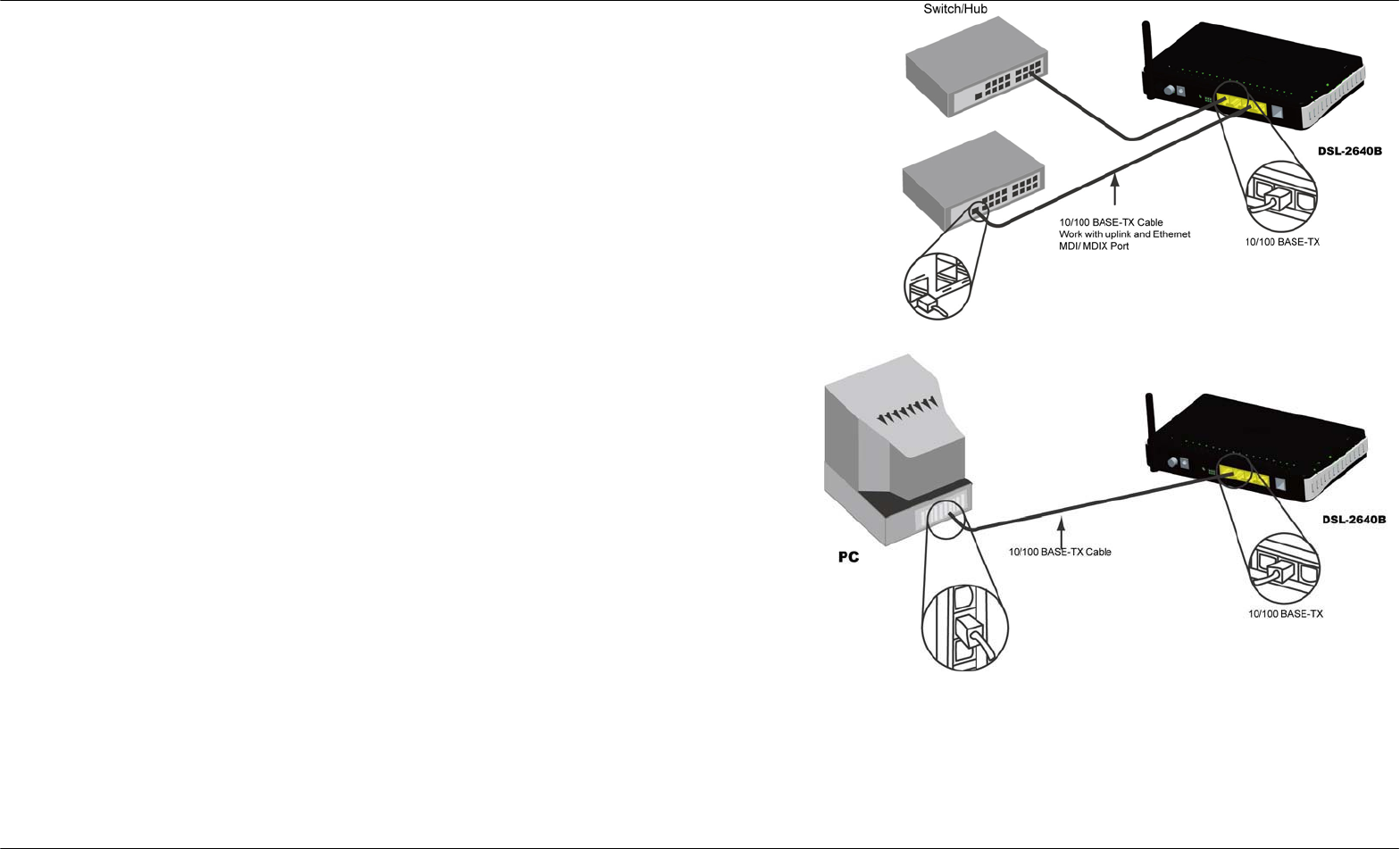
Section 2 - Installation
D-Link DSL-2640B User Manual 18
Hub or Switch to Router Connection
Connect the Router to an uplink port (MDI-II) on an Ethernet hub or switch with
a straight-through cable as shown in this diagram. If you wish to reserve the
uplink port on the switch or hub for another device, connect to any on the other
MDI-X ports (1x, 2x, etc.) with a crossed cable.
Computer to Router Connection
You can connect the Router directly to a 10/100BASE-TX Ethernet adapter
card (NIC) installed on a PC using the Ethernet cable provided as shown in this
diagram.

Section 4 - Troubleshooting
D-Link DSL-2640B User Manual 19
Configuration
This section will show you how to configure your new D-Link wireless router using the web-based configuration utility.
Web-based Configuration Utility
Connect to the Router
To configure the WAN connection used by the Router it is first necessary to communicate with the Router through its management interface, which
is HTML-based and can be accessed using a web browser. The easiest way to make sure your computer has the correct IP settings is to configure
it to use the DHCP server in the Router. The next section describes how to change the IP configuration for a computer running a Windows operating
system to be a DHCP client.
To access the configuration utility, open a web-browser such as Internet Explorer
and enter the IP address of the router (192.168.1.1).
Type “admin” for the User Name and “admin” in the Password field. If you get a
Page Cannot be Displayed error, please refer to the Troubleshooting section
for assistance.
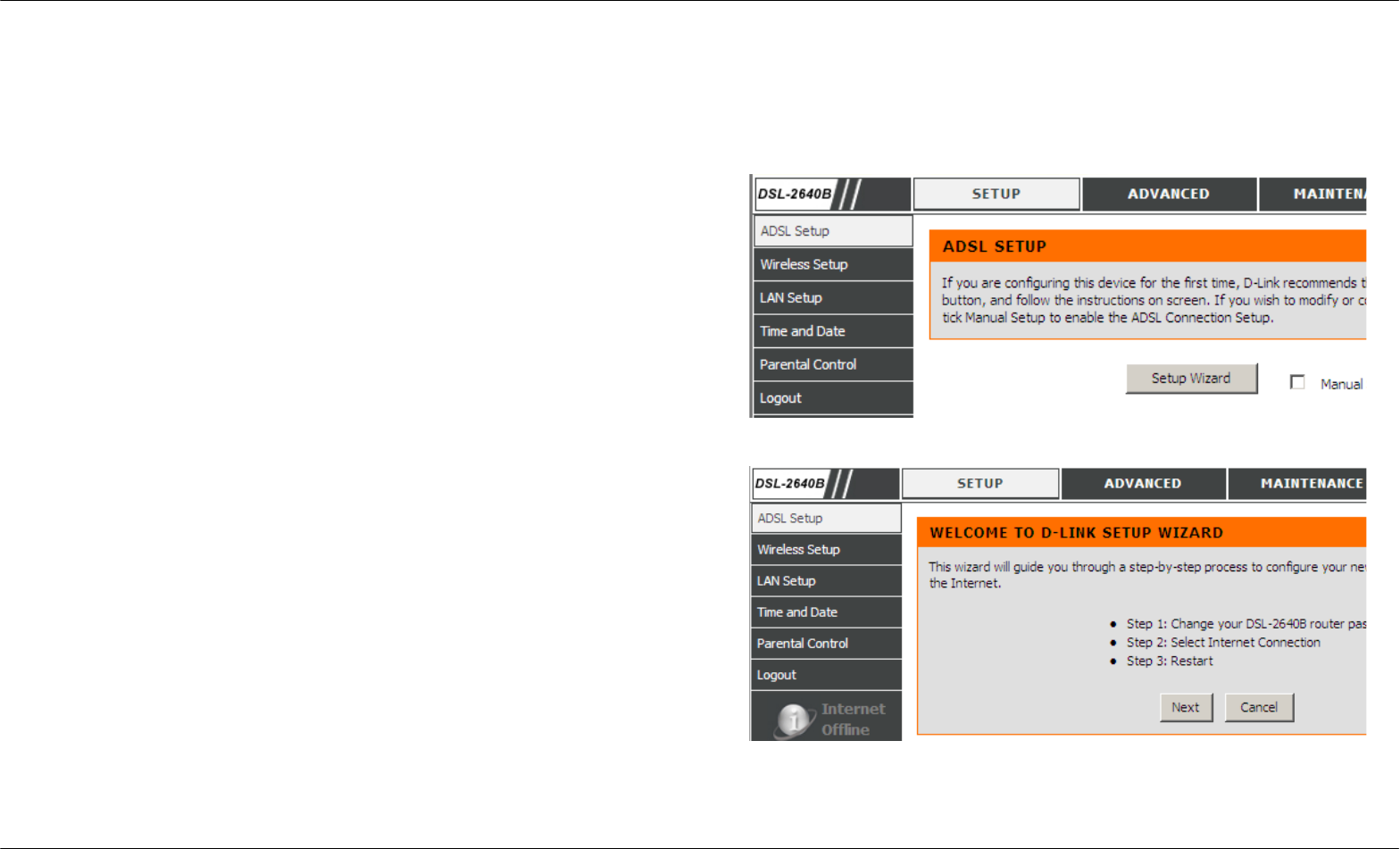
Section 4 - Troubleshooting
D-Link DSL-2640B User Manual 20
SETUP
This chapter is concerned with using your computer to configure the WAN connection. The following chapter describes the various windows used to
configure and monitor the Router including how to change IP settings and DHCP server setup.
WIZARD
ADSL SETUP
Click on the Setup Wizard button to launch the Setup Wizard.
WELCOME TO D-LINK SETUP WIZARD
There are three steps to configuring your router. Click on the Next to
continue.
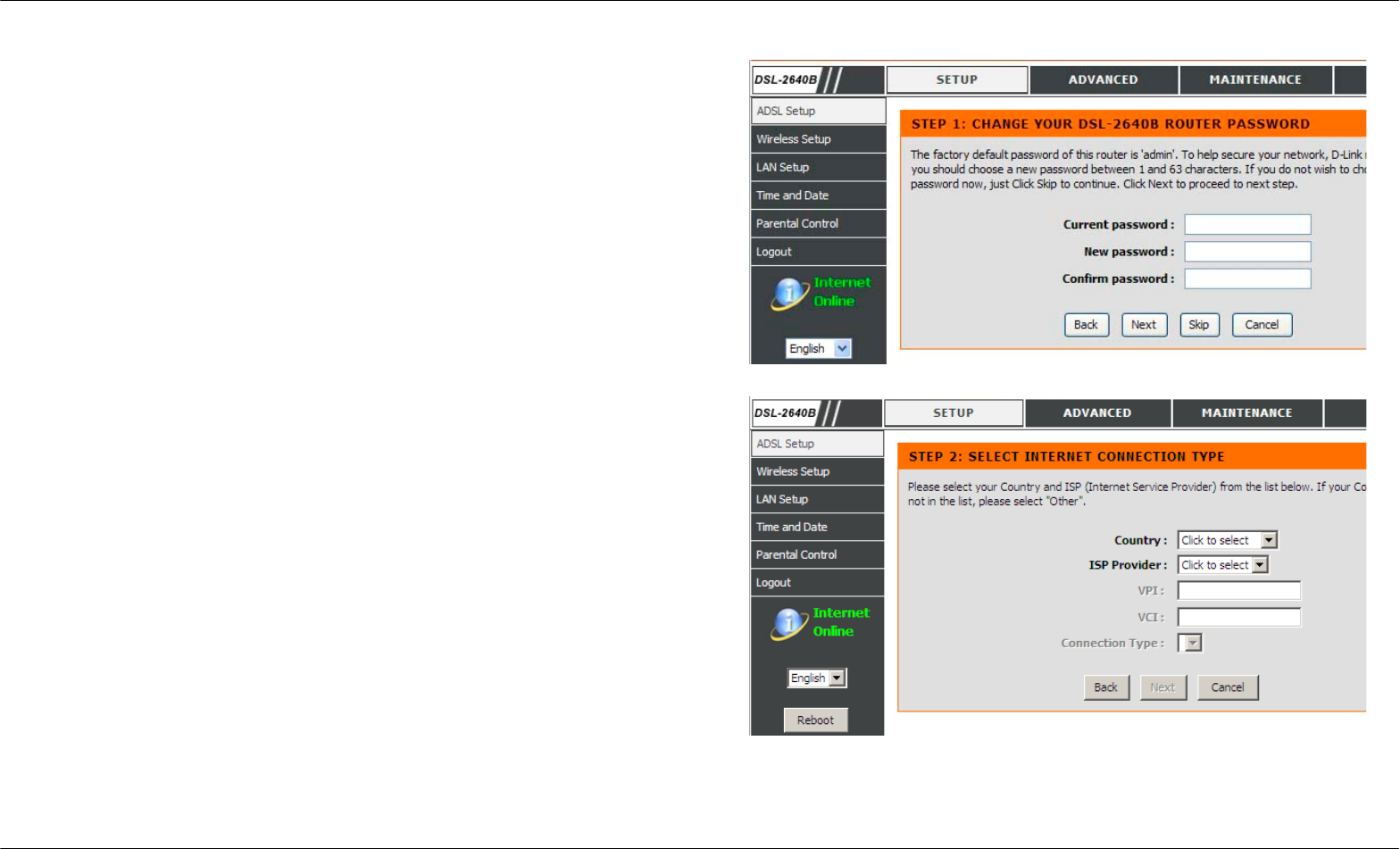
Section 4 - Troubleshooting
D-Link DSL-2640B User Manual 21
STEP 1: CHANGE YOUR DSL-2640B PASSWORD
The default password is "admin", in order to secure your network, please
modify the password. Note: Confirm Password must be same as "New
Password". Of course, you can click on the Skip to ignore the step.
STEP 2: SELECT INTERNET CONNECTION TYPE
Please select your Country and ISP, the VPI and VCI information Will display
Automatically. Of course, you can modify the information.
If, you can not find the country and ISP in the list below; you can select
"Others".
Click on the Next button to go to the next Setup Wizard window.
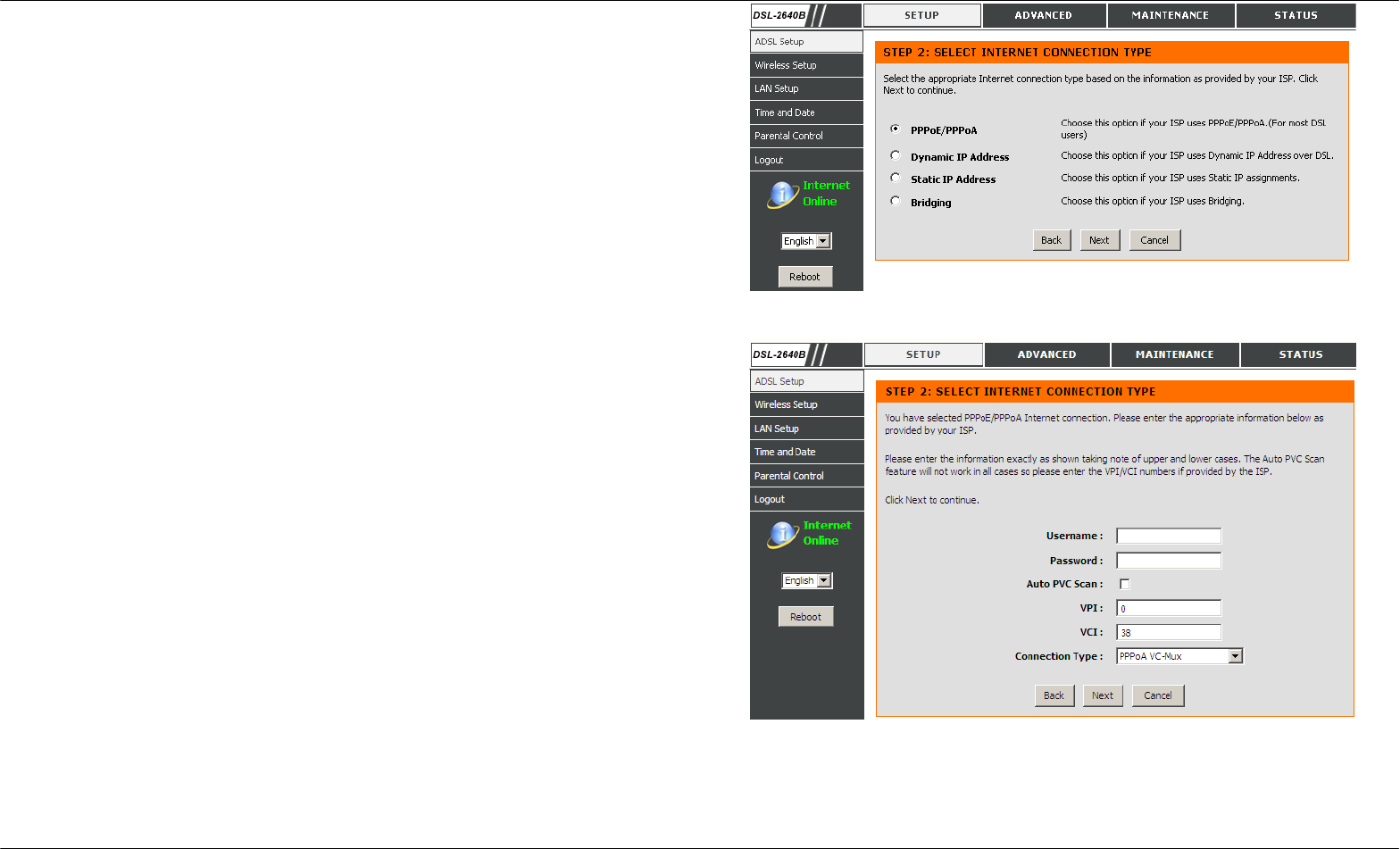
Section 4 - Troubleshooting
D-Link DSL-2640B User Manual 22
STEP 2: SELECT INTERNET CONNECTION TYPE
Select the appropriate Internet connection type based on the information
provided to you by your ISP.
Click on the Next button to go to the next Setup Wizard window.
Using the Setup Wizard - For PPPoE/PPPoA connection
Type in the Username and Password (and PPPoE Service Name, if required
by your ISP).
The Auto PVC Scan feature will not work in all cases so please enter the
VPI/VCI numbers if provided by the ISP.
Select the Connection Type that your ISP has informed you to use.
Click on the Next button to go to the next Setup Wizard window.
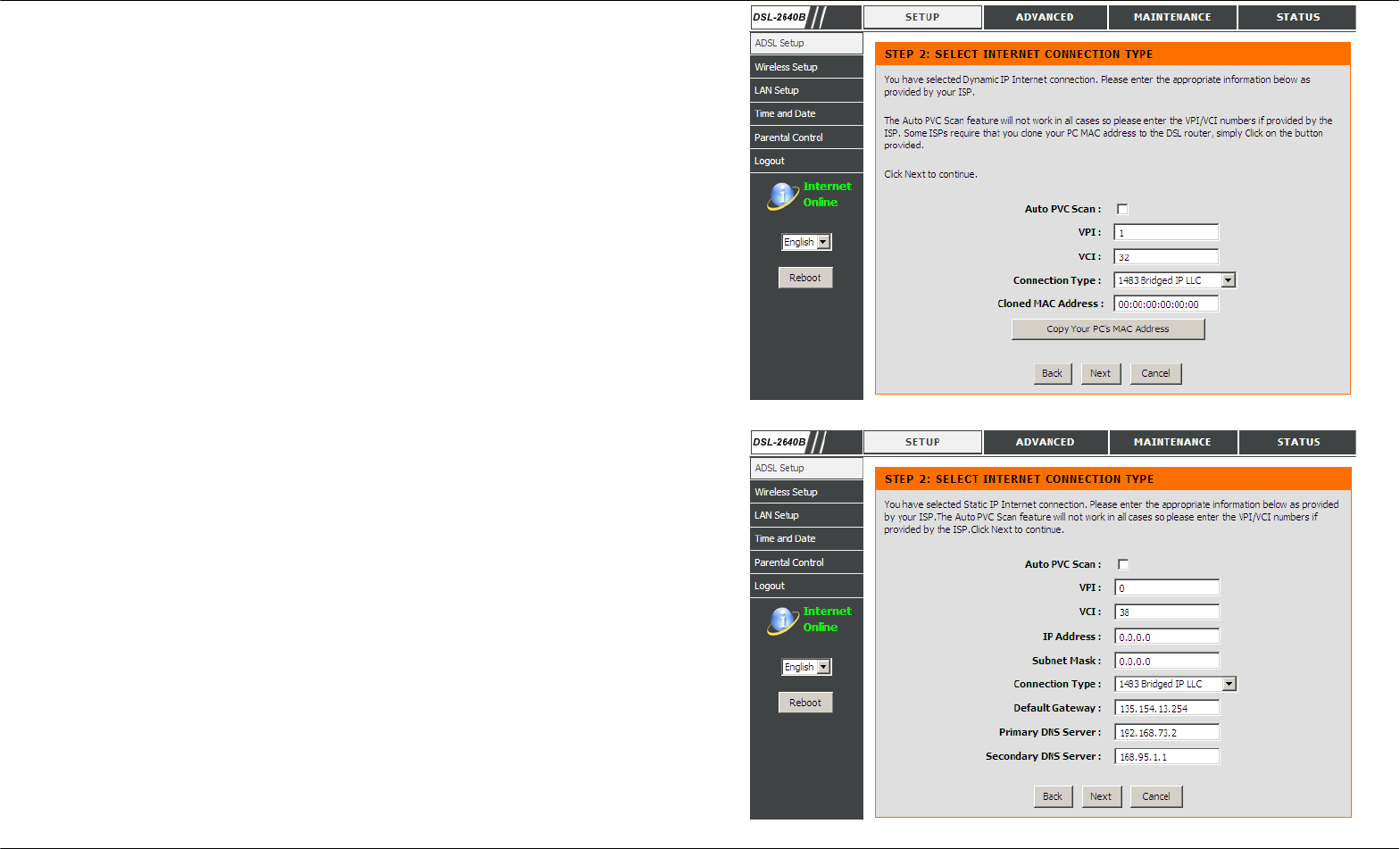
Section 4 - Troubleshooting
D-Link DSL-2640B User Manual 23
Using the Setup Wizard - For Dynamic IP Address connection
Please enter the appropriate information below as provided by your ISP. The
Auto PVC Scan feature will not work in all cases so please enter the VPI/VCI
numbers if provided by the ISP.
Click on the Next button to go to the next Setup Wizard window.
Using the Setup Wizard - For Static IP Address connection
Please enter the appropriate information below as provided by your ISP. The
Auto PVC Scan feature will not work in all cases so please enter the VPI/VCI
numbers if provided by the ISP.
Please input the correct IP address,Subnet Mask,Default Gateway and
DNS information. Note: Should you select to leave default Gateway and
DNS information blank, they should be automatically generated.
Click on the Next button to go to the next Setup Wizard window.
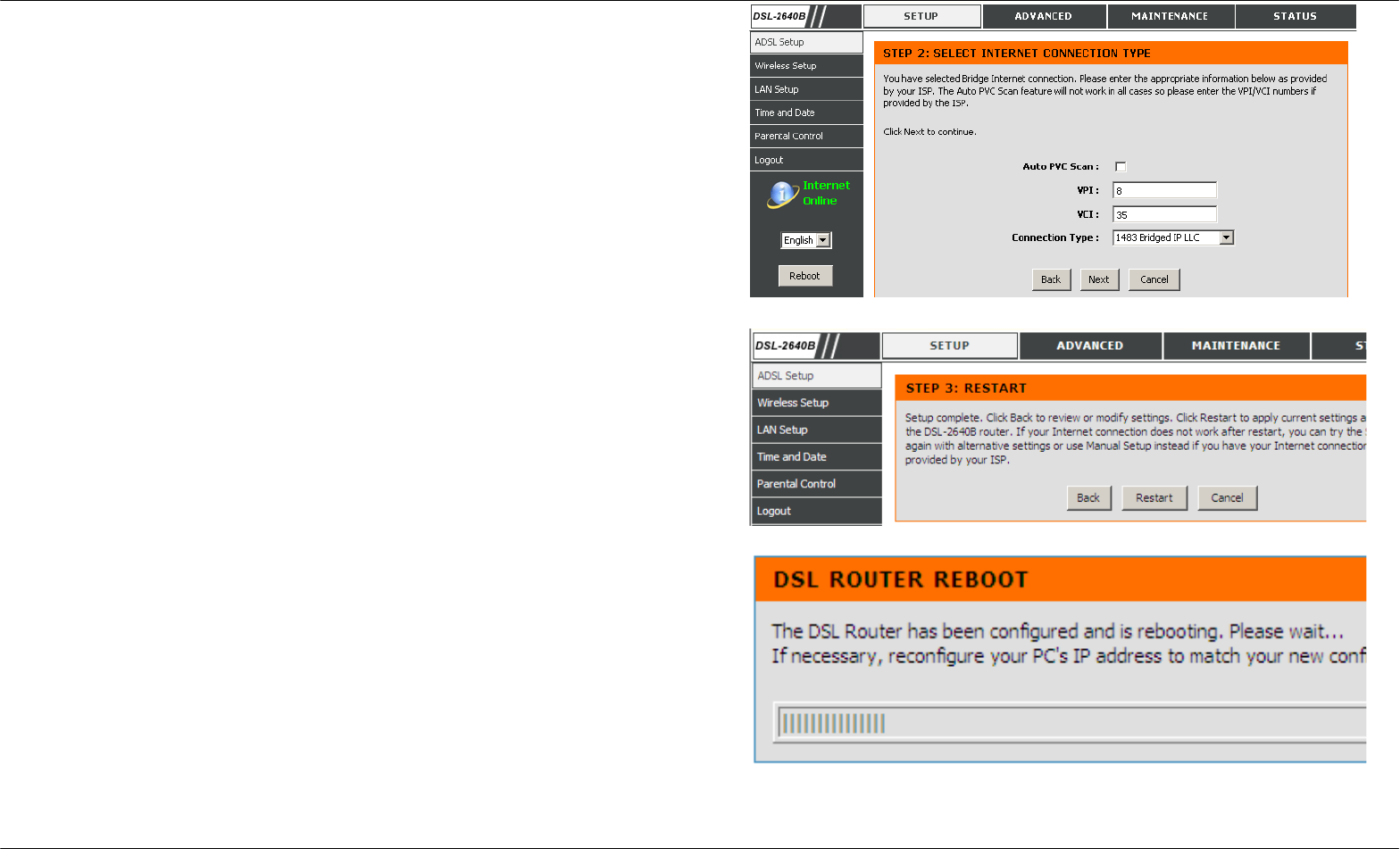
Section 4 - Troubleshooting
D-Link DSL-2640B User Manual 24
Using the Setup Wizard - For Bridging connection
Please enter the appropriate information below as provided by your ISP. The
Auto PVC Scan feature will not work in all cases so please enter the VPI/VCI
numbers if provided by the ISP.
STEP 3: RESTART
Click Back to review or modify settings. Click on Restart to apply current
settings and reboot the DSL-2640B router. If your Internet connection does
not work after the router restarts, you can try the Setup Wizard again with
alternative settings or use Manual Setup instead provided you have your
Internet connection details as provided to you by your ISP.
DSL ROUTER REBOOT
Please ensure you do not turn the Router off while it is rebooting. After
the Router has successfully rebooted, you can again configure the Router as
desired. You can also test the WAN connection by accessing the Internet with
your browser.
Close the DSL Router Configuration window and wait for 1 minute before
reopening your web browser. If necessary, please reconfigure your
computer’s IP address to match your new configuration.

Section 4 - Troubleshooting
D-Link DSL-2640B User Manual 25
ADSL SETUP
To access the ADSL SETUP (WAN) settings window, click on the ADSL Setup button in the SETUP directory and select the Manual Setup to
configure the MANUAL ADSL interface in this page:
ADSL SETUP
Check the Manual Setup item and configure the below messages as in
WIZARD.
Click on the Save Settings button to save your settings. You will be asked
to reboot by a pop-up window. Click on the OK to reboot the router.
Click on the Connect button to connect the router to the Internet with the
WAN interface.
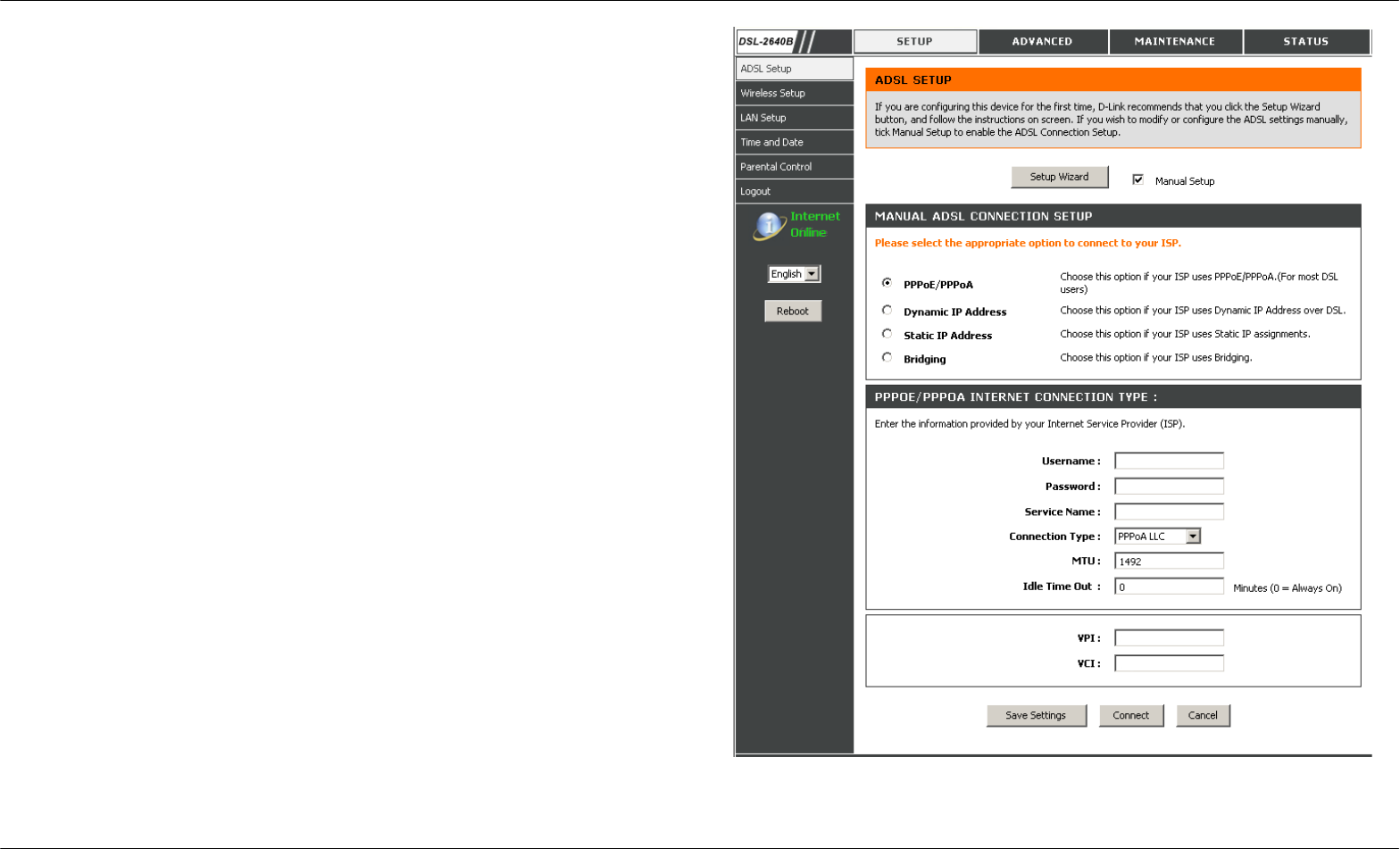
Section 4 - Troubleshooting
D-Link DSL-2640B User Manual 26
When the router is connected to the Internet, the Internet Online graphical
icon will be alit in colour. If it is in dark and you are having problems
browsing web pages, then there may be a problem with your internet
settings and you will need to revert to step 2.
Click on the Disconnect button to disconnect the router to the Internet and
the icon will be dark.

Section 4 - Troubleshooting
D-Link DSL-2640B User Manual 27
WIRELESS
Use this section to configure the wireless settings for your D-Link router. Please note that changes made in this section will also need to be
duplicated onto your wireless clients and PC.
To access the WIRELESS (WLAN) settings window, click on the Wireless Setup button in the SETUP directory.
WIRELESS NETWORK SETTINGS
Click on the Enable Wireless box to allow the router to operate in the
wireless environment.
The SSID identifies members of the Service Set. Accept the default
name or change it to something else. If the default SSID is changed, all
other devices on the wireless network must also use the same SSID.
Enable Auto Channel Scan so that the router can select the best
possible channel for your wireless network to operate on.
The Wireless Channel can let you select the channel of your access
point. Channel availability is different for different countries due to their
regulation.
Select 802.11 Mode to operate in b/g mode. Or select specified mode to
use.
Transmission Rate, suggest keeping the Best (automatic) selection.
Click on the Hide Wireless Network box to allow the router to stop
broadcasting its SSID.

Section 4 - Troubleshooting
D-Link DSL-2640B User Manual 28
WIRELESS SECURITY WIZARD
Click on the Secure My Wireless Network button to enter the SECURE
MY WIRELESS NETWORK window.
SECURE MY WIRELESS NETWORK
Input the SSID.
Select the Wireless Channel.
Select the Encryption type. WPA-PSK is more secure than
WEP 64 bit.
Click on the Apply Settings button to apply the settings
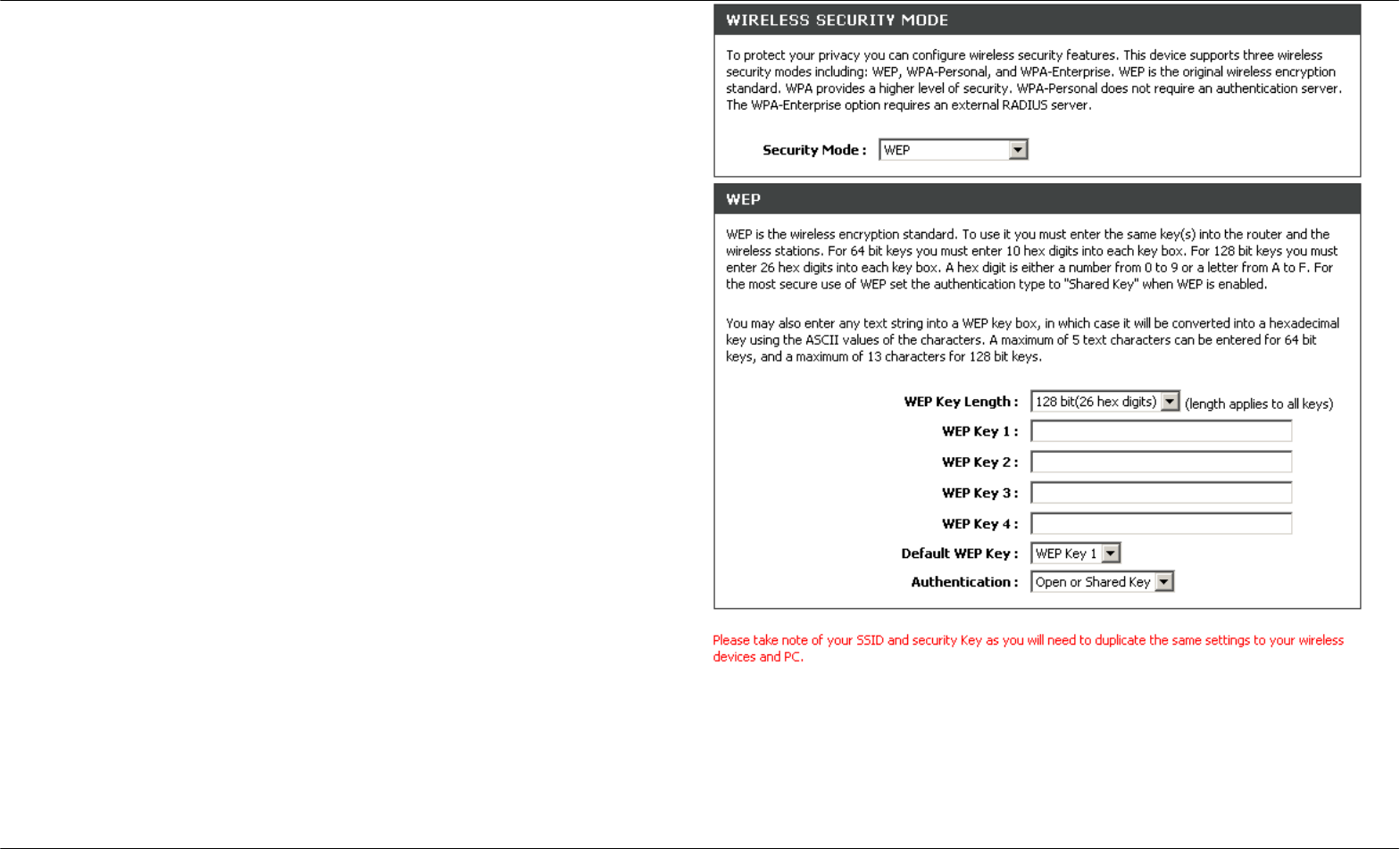
Section 4 - Troubleshooting
D-Link DSL-2640B User Manual 29
WIRELESS SECURITY MODE – WEP
WEP (Wireless Encryption Protocol) encryption can be enabled for
security and privacy. WEP encrypts the data portion of each frame
transmitted from the wireless adapter using one of the predefined keys.
The router offers 64 or 128 bit encryption with four keys available.
Select WEP Key Length from the drop-down menu. (128 bit is stronger
than 64 bit)
Enter the key into the WEP Key field 1~4. (Key length is outlined at the
bottom of the window.)
Specify the encryption key from the Default WEP Key drop-down menu.
Select Authentication type from the drop-down menu. (Shared is
better than Open)
Click on the Apply Settings button to apply settings.
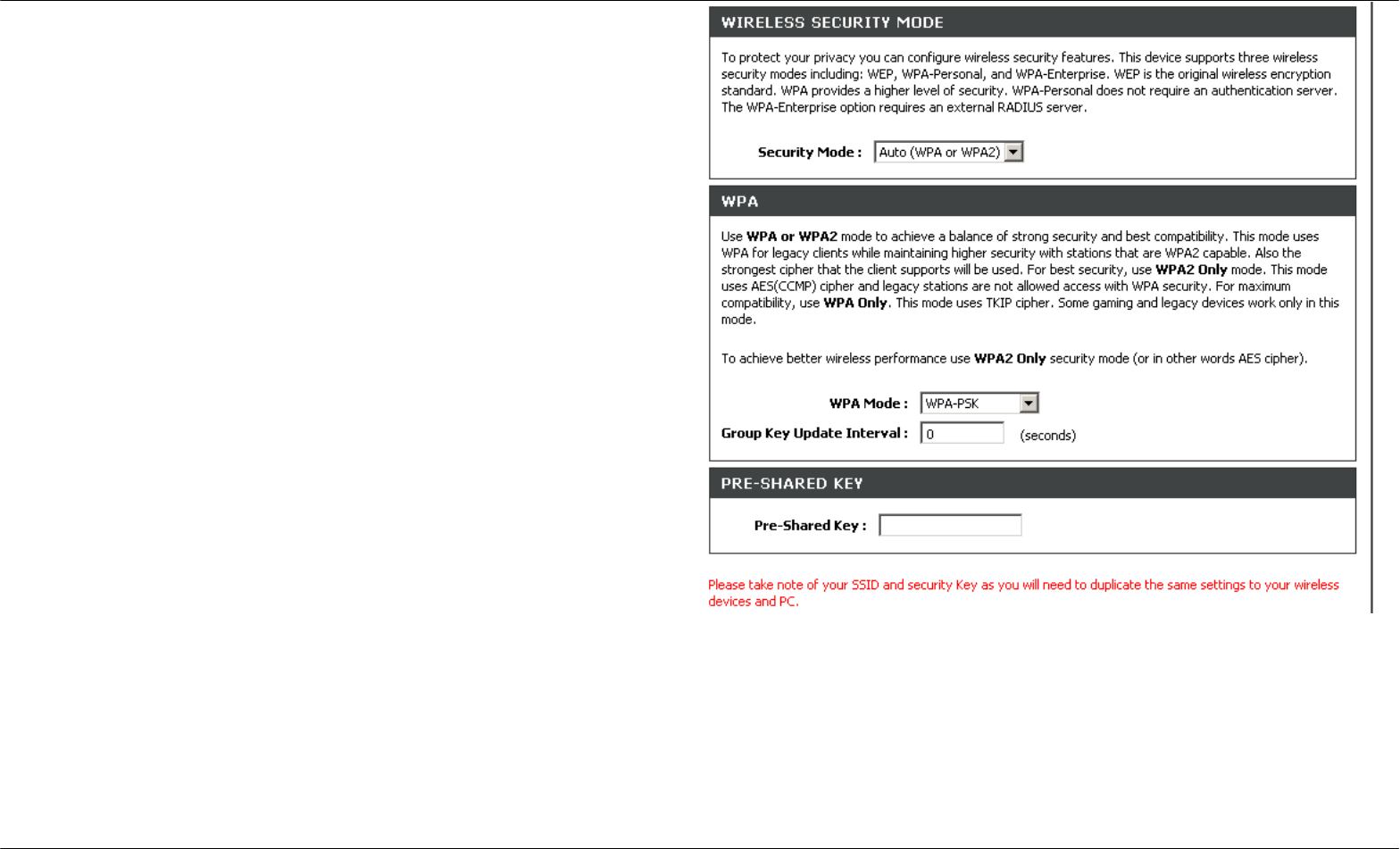
Section 4 - Troubleshooting
D-Link DSL-2640B User Manual 30
WIRELESS SECURITY MODE – WPA-Personal
WPA-PSK
WPA-PSK configuration is similar to WEP. The key length is between 8
to 63 ASCII codes.
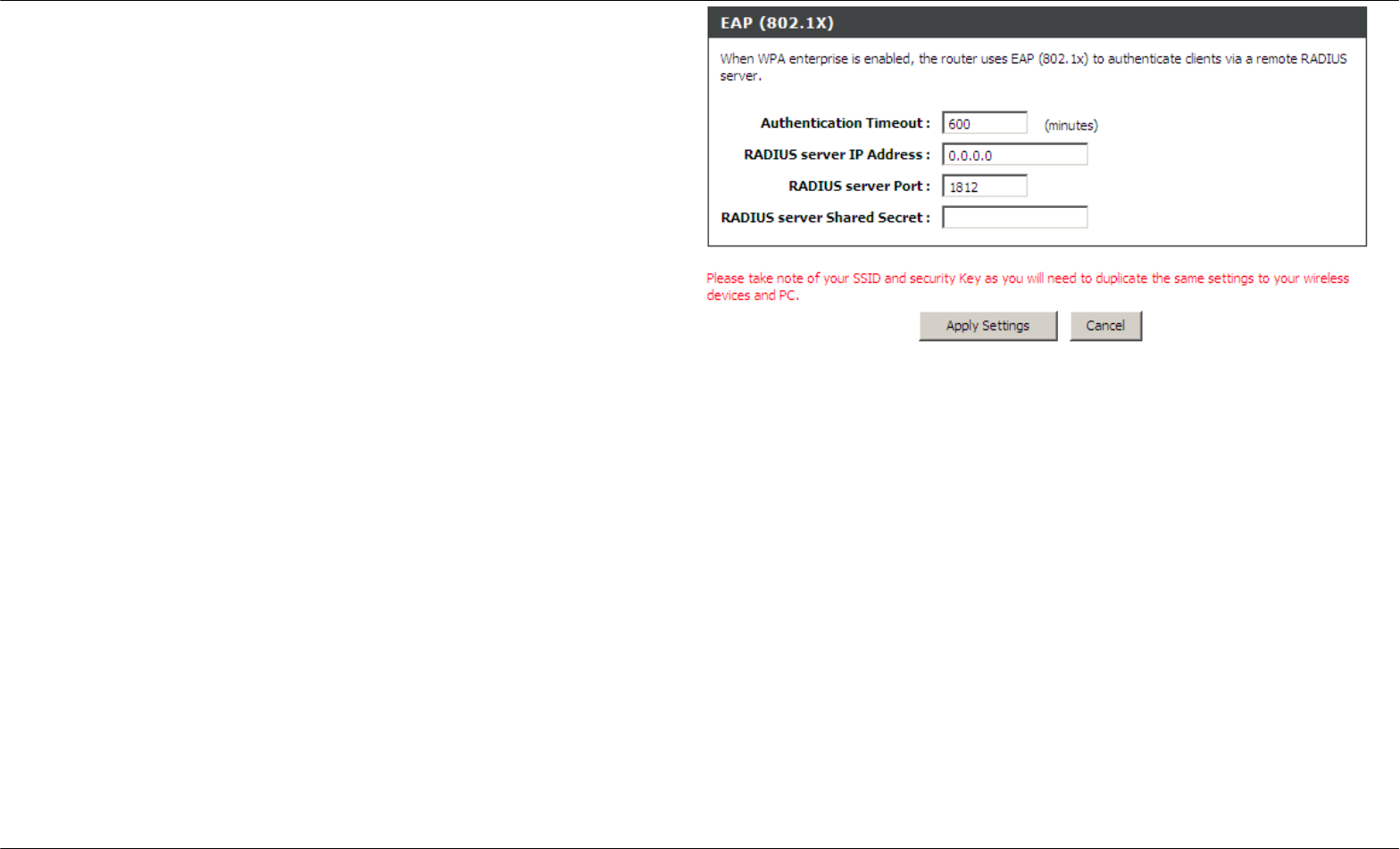
Section 4 - Troubleshooting
D-Link DSL-2640B User Manual 31
WIRELESS SECURITY MODE – WPA-Enterprise
802.1x
Some network-security experts now recommend that wireless networks
use 802.1X security measures to overcome some weaknesses in
standard WEP applications. A RADIUS server is used to authenticate all
potential users.
Enter your RADIUS server data: IP Address, Port, and Key.
Click on the Apply Settings button to apply settings.

Section 4 - Troubleshooting
D-Link DSL-2640B User Manual 32
LAN SETUP
You can configure the LAN IP address to suit your preference. Many users will find it convenient to use the default settings together with DHCP
service to manage the IP settings for their private network. The IP address of the Router is the base address used for DHCP. In order to use the
Router for DHCP on your LAN, the IP address pool used for DHCP must be compatible with the IP address of the Router. The IP addresses
available in the DHCP IP address pool will change automatically if you change the IP address of the Router.
To access the LAN SETUP setting window, click on the LAN Setup button in the SETUP directory.
ROUTER SETTINGS
To change the Router IP Address or Subnet Mask, type in the desired
values.
DHCP SERVER SETTINGS (OPTIONAL)
The Enable DHCP Server is selected by default for the Router’s Ethernet
LAN interface. DHCP service will supply IP settings to workstations
configured to automatically obtain IP settings that are connected to the
Router though the Ethernet port. When the Router is used for DHCP it
becomes the default gateway for DHCP client connected to it. Keep in
mind that if you change the IP address of the Router the range of IP
addresses in the pool used for DHCP on the LAN will also be changed.
The IP address pool can be up to 253 IP addresses.
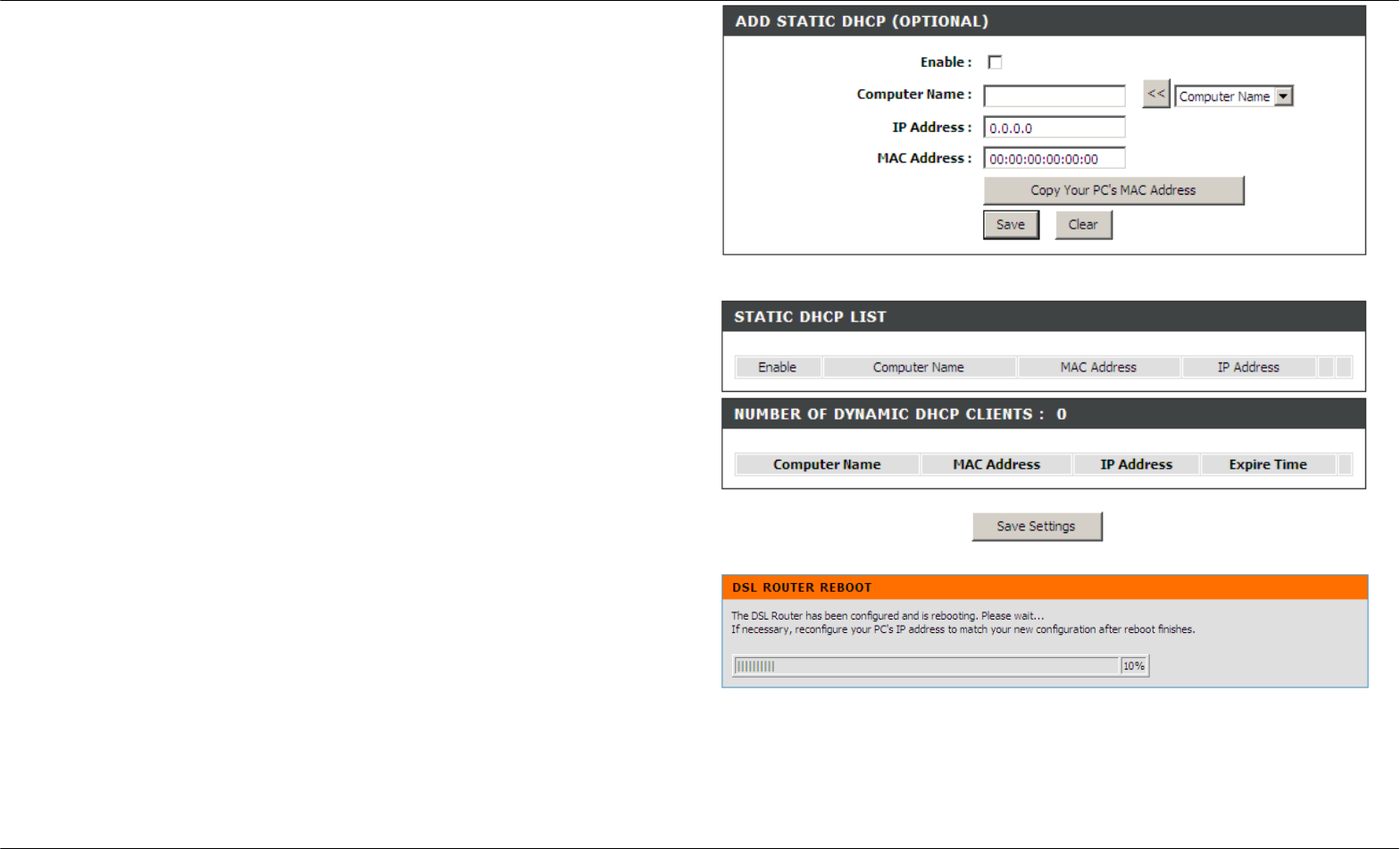
Section 4 - Troubleshooting
D-Link DSL-2640B User Manual 33
ADD STATIC DHCP (OPTIONAL)
Select Enable to let you reserve the IP Address for the designate PC with
the configured MAC Address.
The Computer Name can help you recognize the PC with the MAC
Address, such as “Father’s Laptop”.
Clicking on the Copy Your PC’s MAC Address button will help you get
the Mac address from the PC you are using now browsing this web page.
Click on the Save button to save the settings
STATIC DHCP LIST
After saved the DHCP reservation, the STATIC DHCP LIST will list the
configuration.
The NUMBER OF DYNAMIC DHCP CLIENTS shows how many DHCP
clients (PC or Laptop) connected to the router currently and detailed
information of the computer(s) connected.
Click on the Save Settings button. You will be asked to reboot by a
pop-up window. Click on the OK to reboot the router.
LAN SETUP
Do not turn the Router off while it is rebooting.
You might need to re-configure your PC NIC settings to enter the Router’s
web manager after reboot.
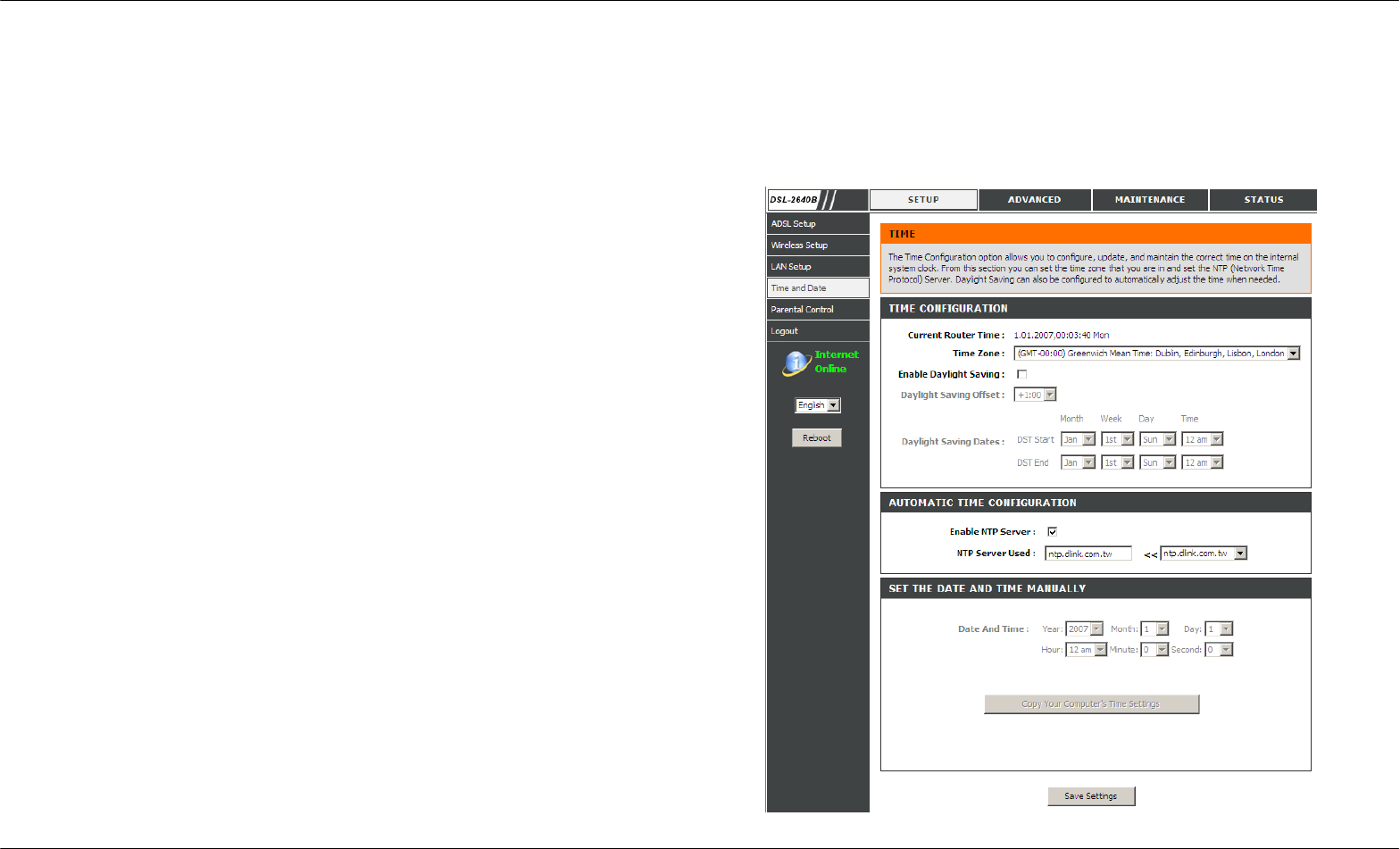
Section 4 - Troubleshooting
D-Link DSL-2640B User Manual 34
TIME
The TIME configuration option allows you to configure, update, and maintain the correct time on the internal system clock. From this section you
can set the time zone that you are in and set the NTP (Network Time Protocol) Server. Daylight Saving can also be configured to automatically
adjust the time when needed.
To access the TIME setting window, click on the Time and Date button in the SETUP directory
TIME
Check the Enable NTP Server.
Select specific time server to use from the NTP Server Used drop-down menu.
Select your operating time zone from the Time Zone drop-down menu.
Check the Enable Daylight Saving if needed and then select the proper
Daylight Saving Offset drop-down menu. Configure the Daylight Saving
Dates from start date to end.
Click on the Save Settings button to apply your settings.
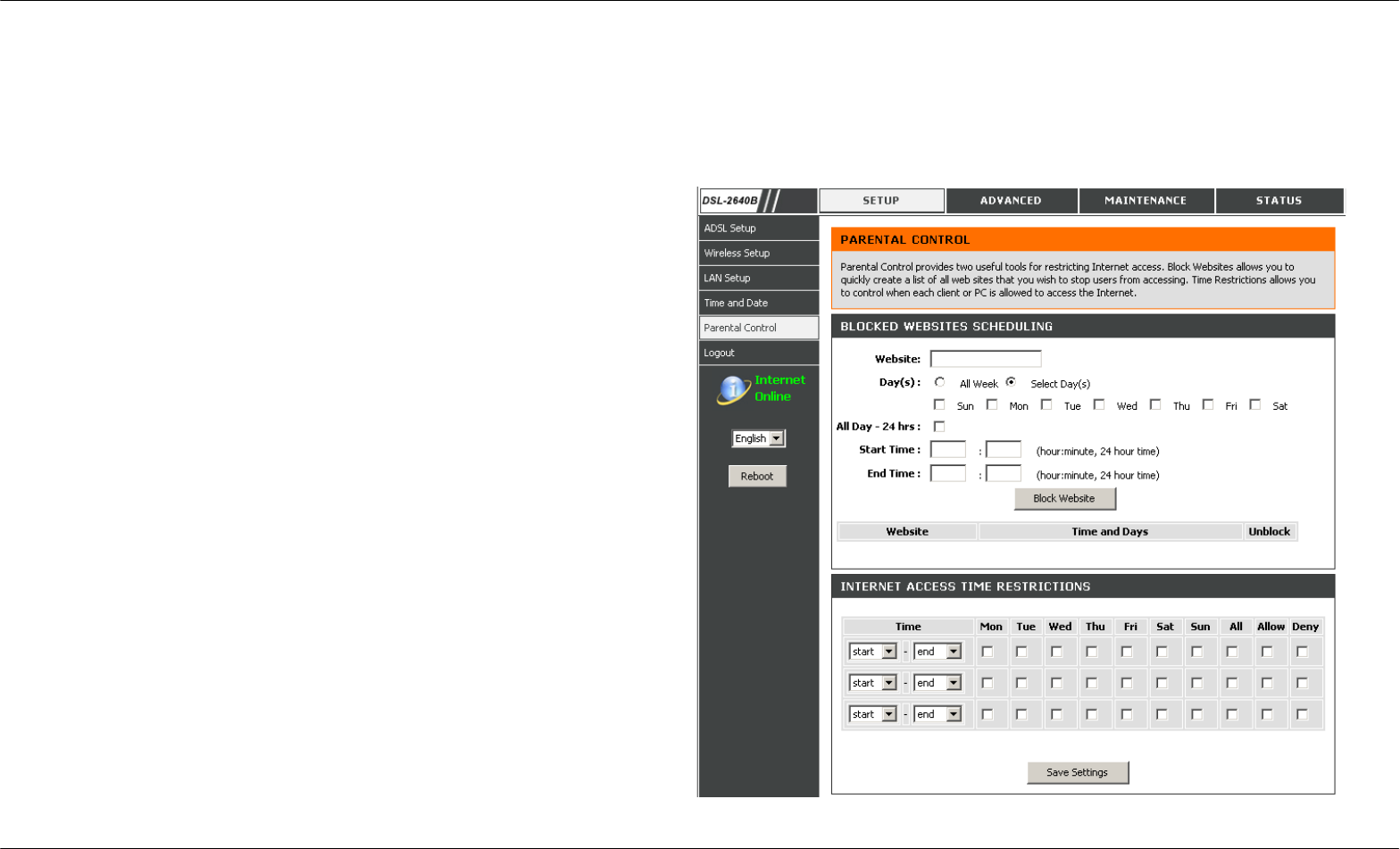
Section 4 - Troubleshooting
D-Link DSL-2640B User Manual 35
PARENTAL CONTROL
The PARENT CONTROL provides two useful tools for restricting Internet access. Block Websites allows you to quickly create a list of all web sites
that you wish to stop users from accessing. Time Restrictions allows you to control when clients or PCs connected to Router are allowed to access
the Internet.
To access the PARENT CONTROL setting window, click on the Parent Control button in the SETUP directory
BLOCKED WEBSITES SCHEDULING
Type the Website and select the corresponding time and days. Click on
the Block Website button to add to your blocked websites scheduling
configuration.
Check the Unblock field in the tail of the row, and then click on the
Unblock Website button. The checked items will be deleted from the
table.
INTERNET ACCESS TIME RESTRICTIONS
Select days and time frame to allow/deny this rule.
Click on the Save Settings button to apply settings.
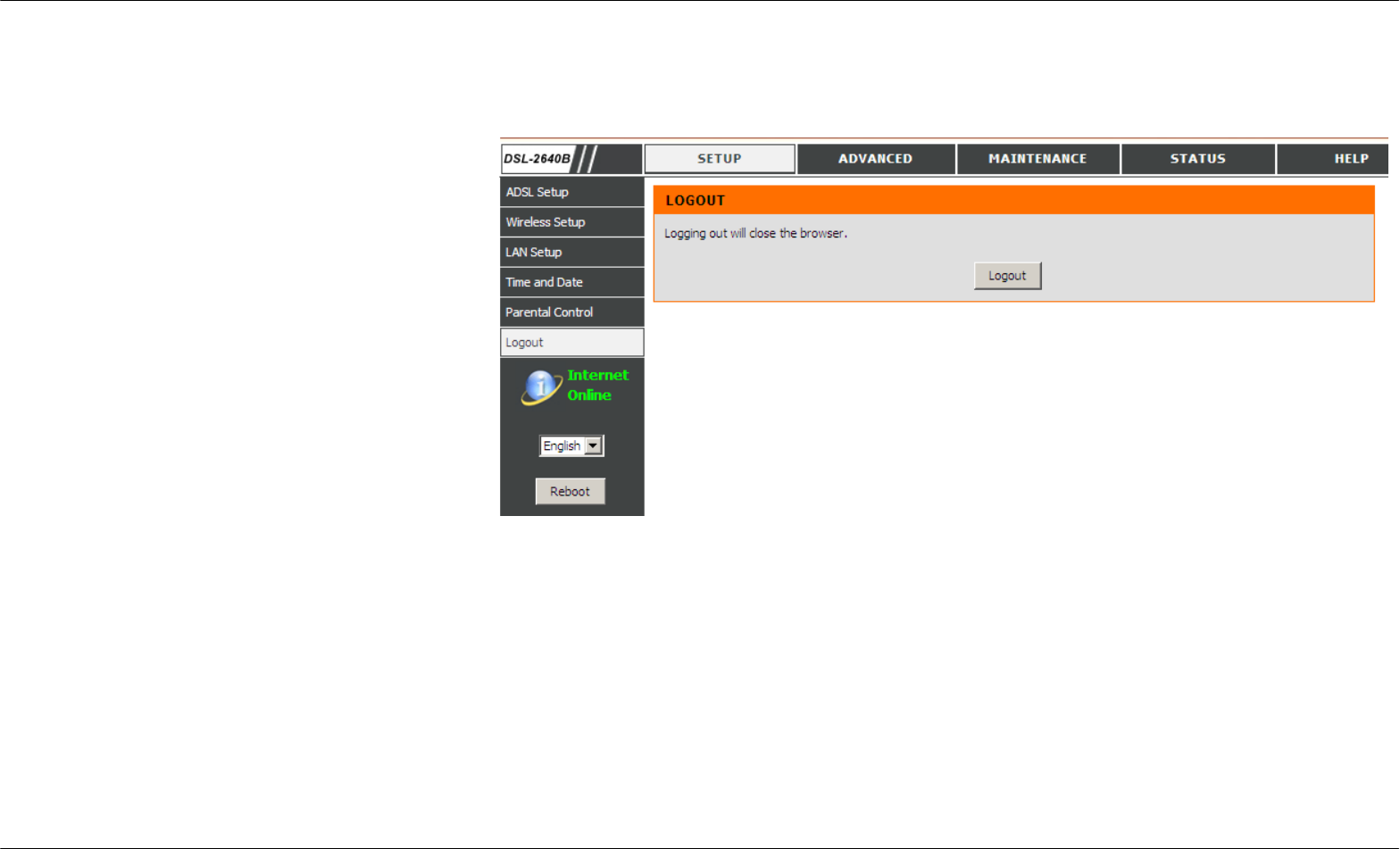
Section 4 - Troubleshooting
D-Link DSL-2640B User Manual 36
LOGOUT
The LOGOUT page enables you you to logout of your router configuration and close the browser.
To access the LOGOUT setting window, click on the Logout button in the SETUP directory
LOGOUT
Click on the Logout button to logout of the router
configuration settings and close the browser.

Section 4 - Troubleshooting
D-Link DSL-2640B User Manual 37
ADVANCED
This chapter include the more advanced features used for network management and security as well as administrative tools to manage the router,
view status and other information used to examine performance and for troubleshooting.
PORT FORWARDING
Use the PORT FORWARDING window to open ports in your router and re-direct data through those ports to a single PC on your network
(WAN-to-LAN traffic). The Port Forwarding function allows remote users to access services on your LAN such as FTP for file transfers or SMTP and
POP3 for e-mail. The DSL-2640B will accept remote requests for these services at your Global IP Address, using the specified TCP or UDP
protocol and port number, and then redirect these requests to the server on your LAN with the LAN IP address you specify. Remember that the
specified Private IP Address must be within the useable range of the subnet occupied by the Router.
To access the PORT FORWARDING settings window, click on the Port Forwarding button in the ADVANCED directory
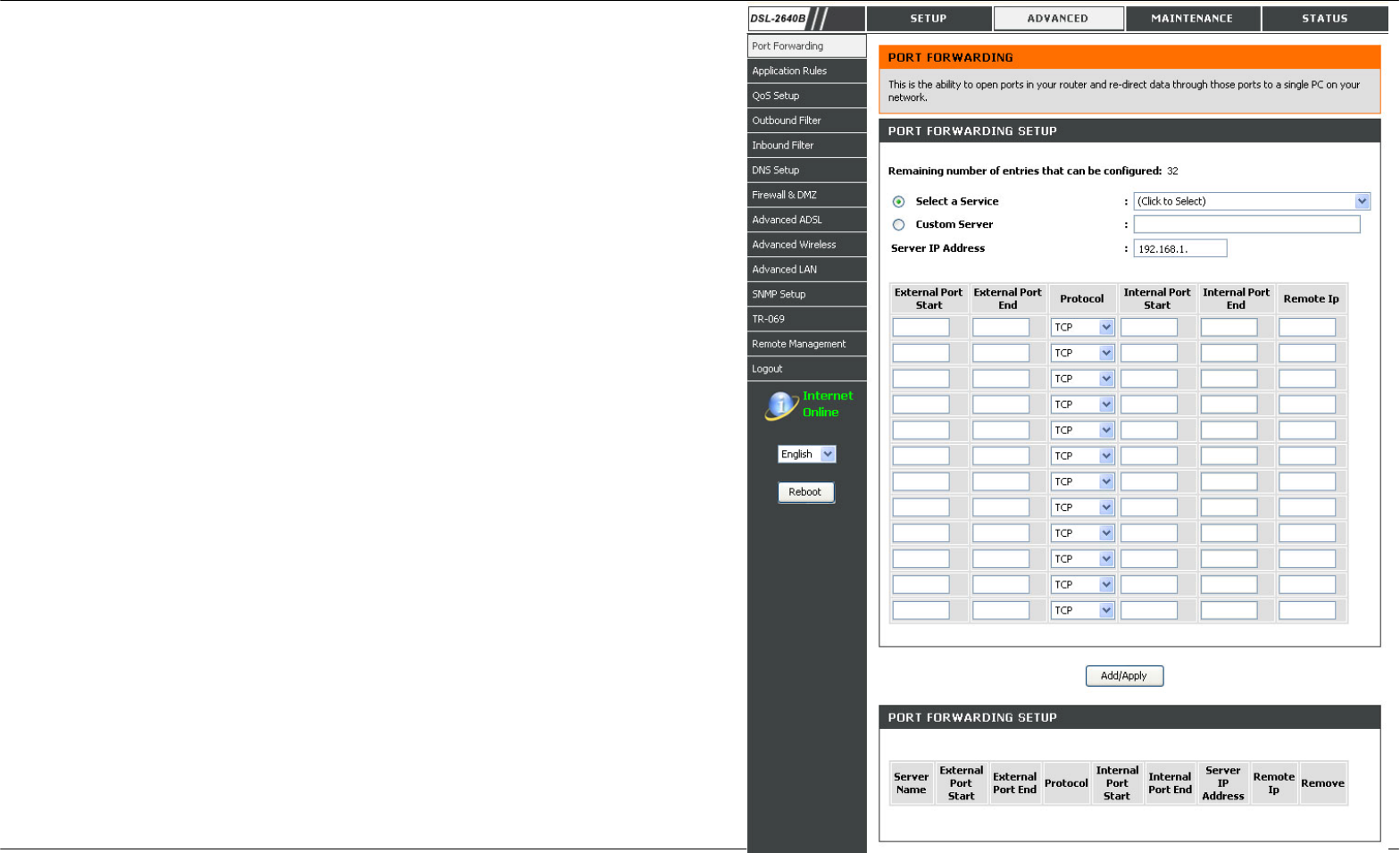
Section 4 - Troubleshooting
D-Link DSL-2640B User Manual 38
PORT FORWARDING RULES CONFIGURATION
Select a service from the Select a Service drop-down menu for a
pre-configured application or type a name in the Custom Server input box to
define your own application.
Type an IP address in the Server IP address input box to appoint the PC to
receive the forwarded packets.
The External Port Start and External Port End box shows the range of the
ports you want to open on the router. The TCP/UDP means the protocol type
of the opened ports. The Internal Port Start and Internal Port End box
shows the range of the ports in your PC to receive the forwarded packets
Click on the Add/Apply button to apply settings.

Section 4 - Troubleshooting
D-Link DSL-2640B User Manual 39
APPLICATION RULES
Some applications require that specific ports in the Router's firewall be opened for access by the remote parties. Application rules dynamically open
up the Open Start/End ports when an application on the LAN initiates a TCP/UDP connection to a remote party using the Trigger Start/End ports.
The router allows the remote party from the WAN side to establish new connections back to the application on the LAN side using the Open
Start/End ports. A maximum of 32 entries can be configured.
To access the APPLICATION RULES setting window, click on the Application Rules button in the ADVANCED directory.

Section 4 - Troubleshooting
D-Link DSL-2640B User Manual 40
APPLICATION RULES CONFIGURATION
Select a name from the Select an Application drop-down menu
for pre-configured application or type a name in the Custom
Application input box to define your own rules.
Enter your Trigger Port Start,Trigger Port End and the Trigger
Protocol. Enter values for Open Port Start and Open Port End,
and select the Open Protocol to be used.
Click on the Add/Apply button to apply settings.

Section 4 - Troubleshooting
D-Link DSL-2640B User Manual 41
QoS SETUP
QoS or Quality of service allows your Router to help prioritize the data packet flow in your router and network. This is very important for time
sensitive applications such as VoIP where it may help prevent dropped calls. Large amounts of non-critical data can be scaled so as not to affect
these prioritised sensitive real-time programs. D-Link has pre-setup some often used rules for the QoS. VoIP and H.323 are often used for Internet
calls.
To access the QoS SETUP setting window, click on the QoS Setup button in the ADVANCED directory.

Section 4 - Troubleshooting
D-Link DSL-2640B User Manual 42
QoS SETUP
Check the service type and configure the port range if need.
Click on the Save Settings button to apply settings
WMM(WI-FI MULTIMEDIA) SETTINGS
Enable or Disable WMM for Wi-fi Multimedia QoS settings. (Enabling
this will enable Wireless QoS button)
ADVANCED QoS SETUP
Click on the Advanced QoS button to enter the QUALITY OF
SERVICE SETUP window.
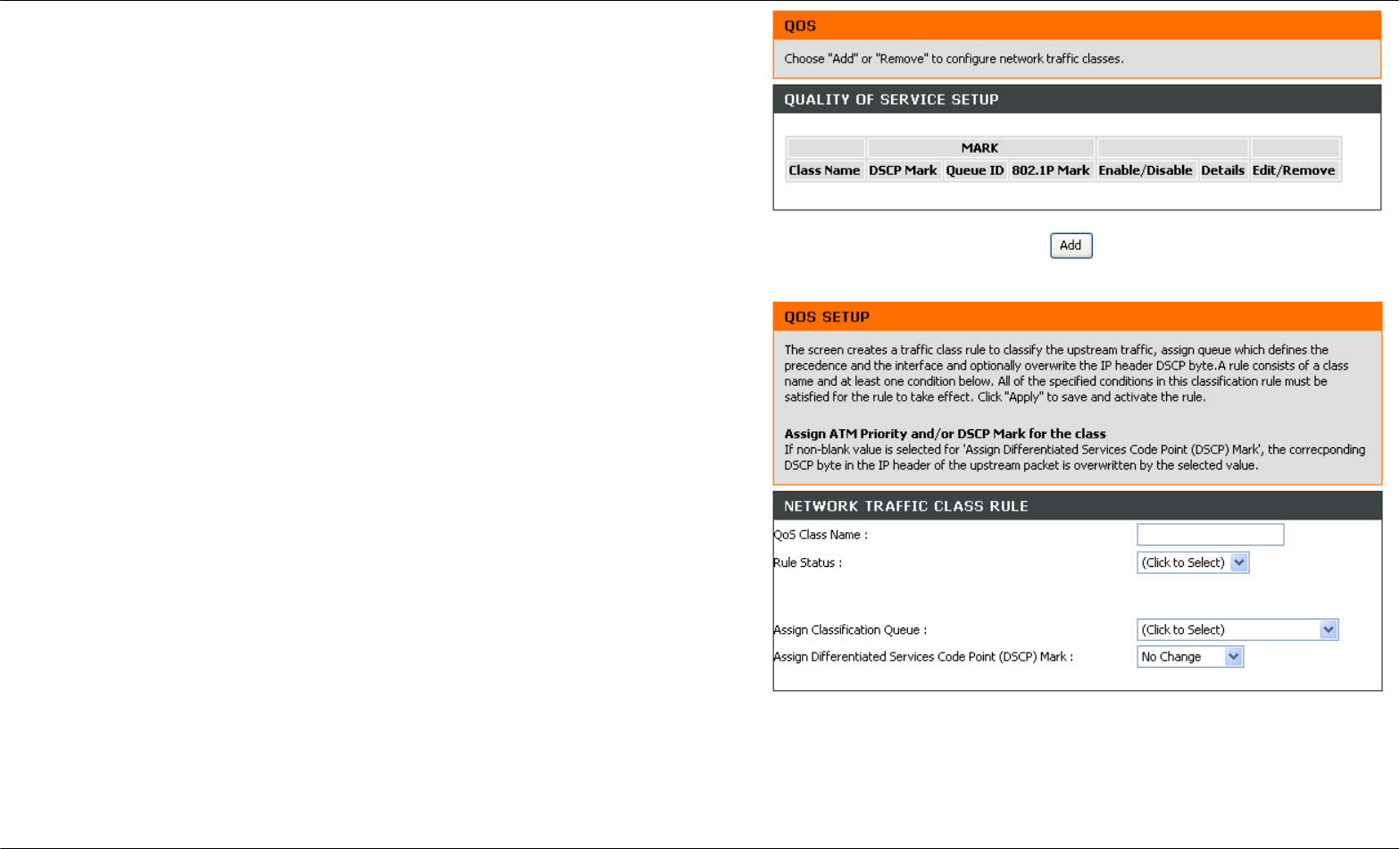
Section 4 - Troubleshooting
D-Link DSL-2640B User Manual 43
QOS
The QUALITY OF SERVICE SETUP table shows the list of Quality of Service
Setup rules that have been added.
To add a new QoS rule, click on the Add button
QOS SETUP
Enter the QoS Class Name and specify the Rule Status.
Assign a Classification Queue to where the QoS will be used and its
Differentiated Services Code Point (DSCP) Mark.
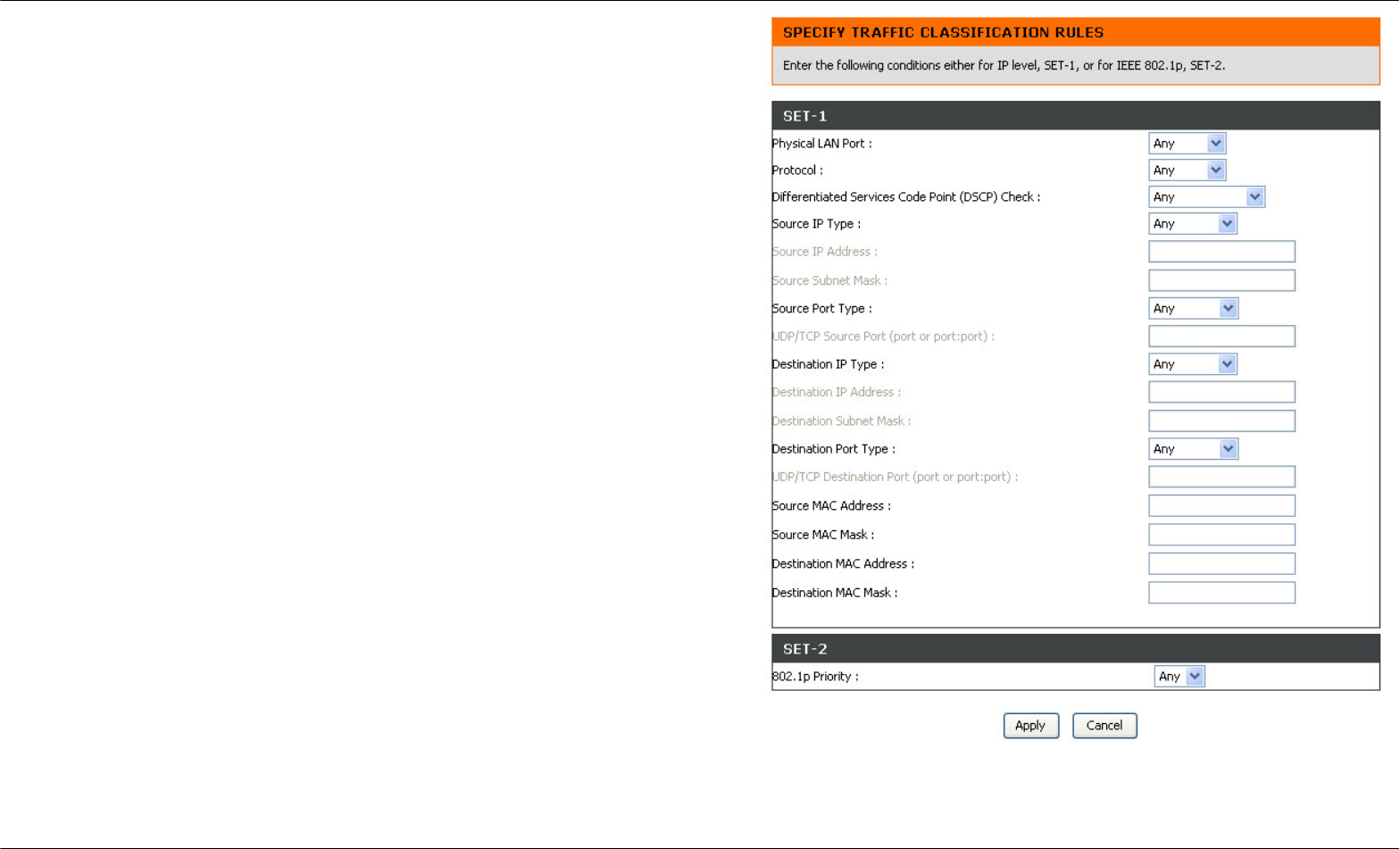
Section 4 - Troubleshooting
D-Link DSL-2640B User Manual 44
SPECIFY TRAFFIC CLASSIFICATION RULES
Define the set of conditions for SET-1 by specifying the Physical LAN Port,
Protocol, Differentiated Services Code Point Check,Source and
Destination IP Types and MAC Address.
Choose the 802.1p Priority for SET-2 and click on the Apply button to add this
new rule.
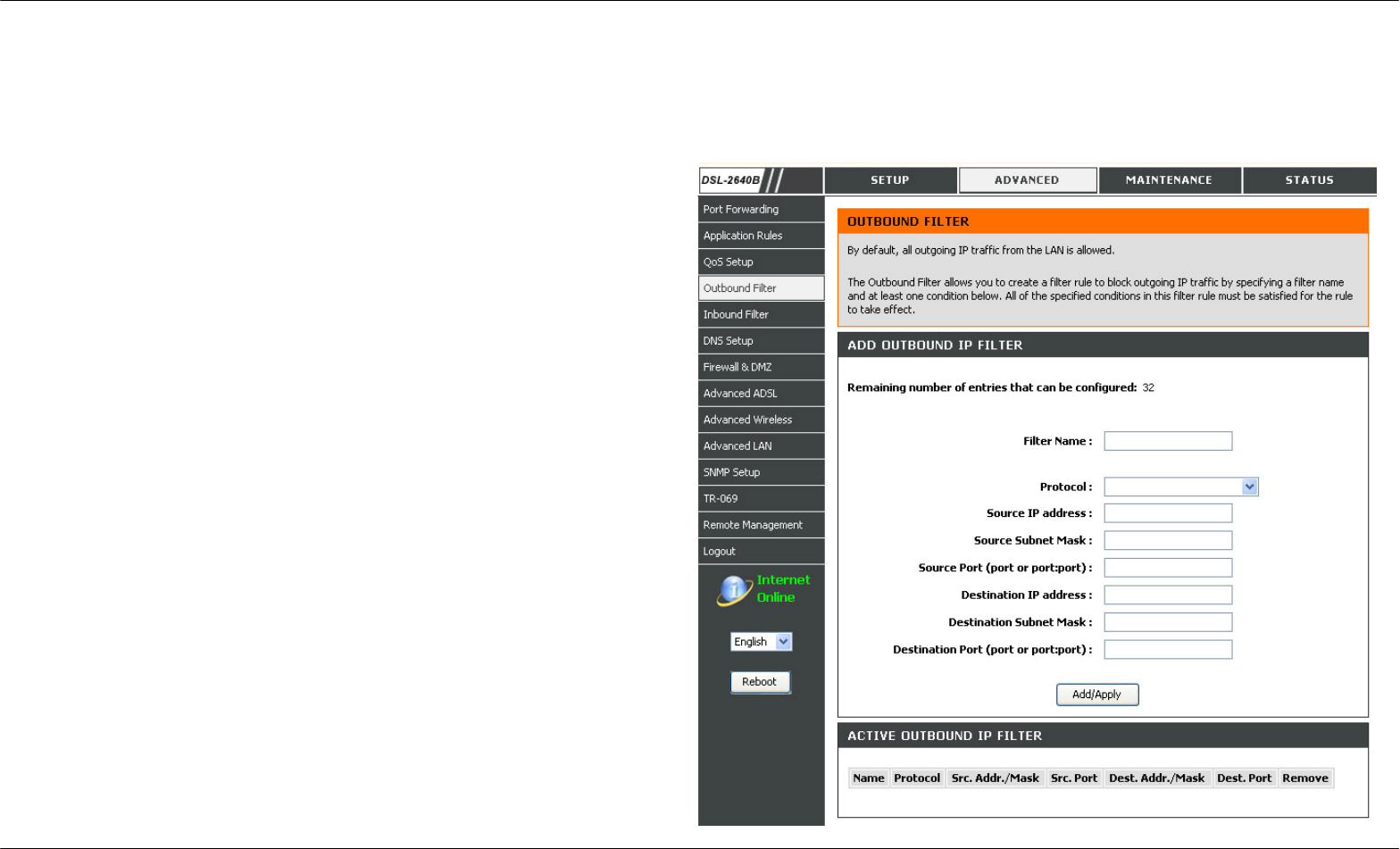
Section 4 - Troubleshooting
D-Link DSL-2640B User Manual 45
OUTBOUND IP FILTER
By default, all outgoing IP traffic from the LAN is allowed. The Outbound Filter allows you to create a filter rule to block outgoing IP traffic by
specifying a filter name and at least one condition below. All of the specified conditions in this filter rule must be satisfied for the rule to take effect.
To access the OUTBOUND IP FILTER setting window, click on the Outbound Filter button in the ADVANCED directory.
ADD OUTBOUND IP FILTER
Enter the Filter name and at least one of the following criteria:
Protocol,Source/Destination IP Address and Subnet Mask, and
Source/Destination Port.
Click on the Add/Apply button to add and apply settings.
The Active Outbound IP Filter shows detailed information about each
created outbound IP filter. To remove an IP filter, click on the Remove
button (only appears when there is an existing IP filter).
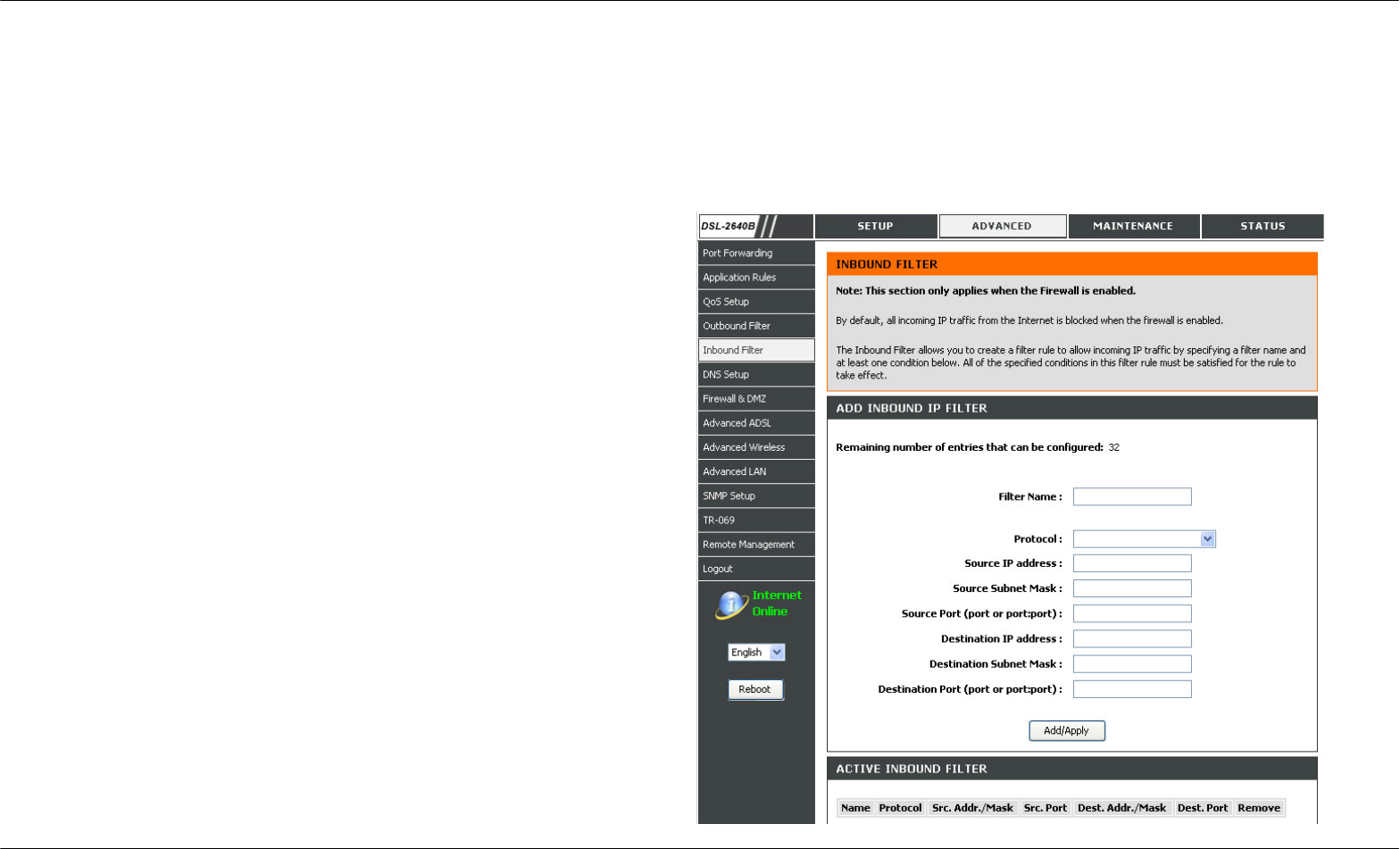
Section 4 - Troubleshooting
D-Link DSL-2640B User Manual 46
INBOUND IP FILTER
By default, all incoming IP traffic that does not originate from the internal network is blocked when the firewall is enabled. Normal outgoing Internet
requests created by web browsing, email and other software you run will work as usual as the requests originate from inside your internal network.
The Inbound Filter allows you to create a filter rule to allow incoming IP traffic by specifying a filter name and at least one condition below. All of the
specified conditions in this filter rule must be satisfied for the rule to take effect.
To access the INBOUND IP FILTER setting window, click on the Inbound Filter button in the ADVANCED directory.
ADD INBOUND IP FILTER
Enter the Filter name and at least one of the following criteria:
Protocol,Source/Destination IP Address and Subnet Mask, and
Source/Destination Port.
Click on the Add/Apply button to add and apply settings.
Note: This section only applies when the Firewall is enabled.
The Active Inbound IP Filter shows detailed information about each
created inbound IP filter. To remove an IP filter, click on the Remove
button (only appears when there is an existing IP filter).

Section 4 - Troubleshooting
D-Link DSL-2640B User Manual 47
DNS SETUP
The Router can be configured to relay DNS settings from your ISP or another available service to workstations on your LAN. When using DNS relay,
the Router will accept DNS requests from hosts on the LAN and forward them to the ISP’s, or alternative DNS servers. DNS relay can use auto
discovery or the DNS IP address can be manually entered by the user. Alternatively, you may also disable the DNS relay and configure hosts on
your LAN to use DNS servers directly. Most users, who are using the Router for DHCP service on the LAN and are using DNS servers on the ISP’s
network, should check Obtain DNS server address automatically box.
The Router supports DDNS (Dynamic Domain Name Service). The Dynamic DNS service allows a dynamic public IP address to be associated with
a static host name in any of the many domains, allowing access to a specified host from various locations on the Internet. This is enabled to allow
remote access to a host by clicking on a hyperlinked URL in the form hostname.dyndns.org, Many ISPs assign public IP addresses using DHCP,
and this can make it difficult to locate a specific host on the LAN using standard DNS. If for example you are running a public web server or VPN
server on your LAN, this ensures that the host can be located from the Internet if the public IP address changes. DDNS requires that an account be
setup with one of the supported DDNS service providers (DyndDNS.org or dlinkddns.com).
To access the DNS SETUP setting window, click on the DNS Setup button in the ADVANCED directory.

Section 4 - Troubleshooting
D-Link DSL-2640B User Manual 48
DNS SERVER CONFIGURATION
If you are using the Router for DHCP service on the LAN and
are using DNS servers on the ISP’s network, check Obtain
DNS server address automatically box.
If you have DNS IP addresses provided by your ISP, enter
these IP addresses in the available entry fields for the
Preferred DNS Server and the Alternate DNS Server.
DDNS CONFIGURATION
Check the Enable Dynamic DNS box.
Select DDNS Service provider from the Server Address
drop-down menu and enter your account data.
After configure the DNS settings as desired, click on the Apply
Settings button to apply settings.
Server
Address:
Select one of the DDNS registration
organizations form those listed in the
pull-down menu. Available servers include
DynDns.org and dlinkddns.com.
Host Name: Enter the Host Name that you registered
with your DDNS service provider.
Username or
Key:
Enter the Username for your DDNS
account.
Password or
Key:
Enter the Password for your DDNS account.

Section 4 - Troubleshooting
D-Link DSL-2640B User Manual 49
FIREWALL & DMZ
The Firewall & DMZ window allows the Router to enforce specific predefined policies intended to protect against certain common types of attacks.
There are two general types of protection (DoS, Port Scan) that can be enabled on the Router, as well as filtering for specific packet types
sometimes used by hackers.
Since some applications are not compatible with NAT, the Router supports use of a DMZ IP address for a single host on the LAN. This IP address is
not protected by NAT and will therefore be visible to agents on the Internet with the right type of software. Keep in mind that any client PC in the
DMZ will be exposed to various types of security risks. If you use the DMZ, take measures (such as client-based virus protection) to protect the
remaining client PCs on your LAN from possible contamination through the DMZ.
To access the FIREWALL & DMZ setting window, click on the Firewall & DMZ button under the ADVANCED tab.

Section 4 - Troubleshooting
D-Link DSL-2640B User Manual 50
FIREWALL SETTINGS
DoS and Port
Scan
Protection:
A DoS (denial-of-service) attack is characterized by
an explicit attempt by attackers to prevent legitimate
users of a service from using that service.
Examples include: attempts to "flood" a network,
thereby preventing legitimate network traffic,
attempts to disrupt connections between two
machines, thereby preventing access to a service,
attempts to prevent a particular individual from
accessing a service, or, attempts to disrupt service
to a specific system or person.
Port scan protection is designed to block attempts
to discover vulnerable ports or services that might
be exploited in an attack from the WAN.
DMZ SETTING
Check the Enable DMZ box and type the IP Address of the
server or device on your LAN in the DMZ IP Address box.

Section 4 - Troubleshooting
D-Link DSL-2640B User Manual 51
APPLICATION LEVEL GATEWAY (ALG) CONFIGURATION
Check the relevant ALG options as required.
Click on the Apply Settings button to apply settings.
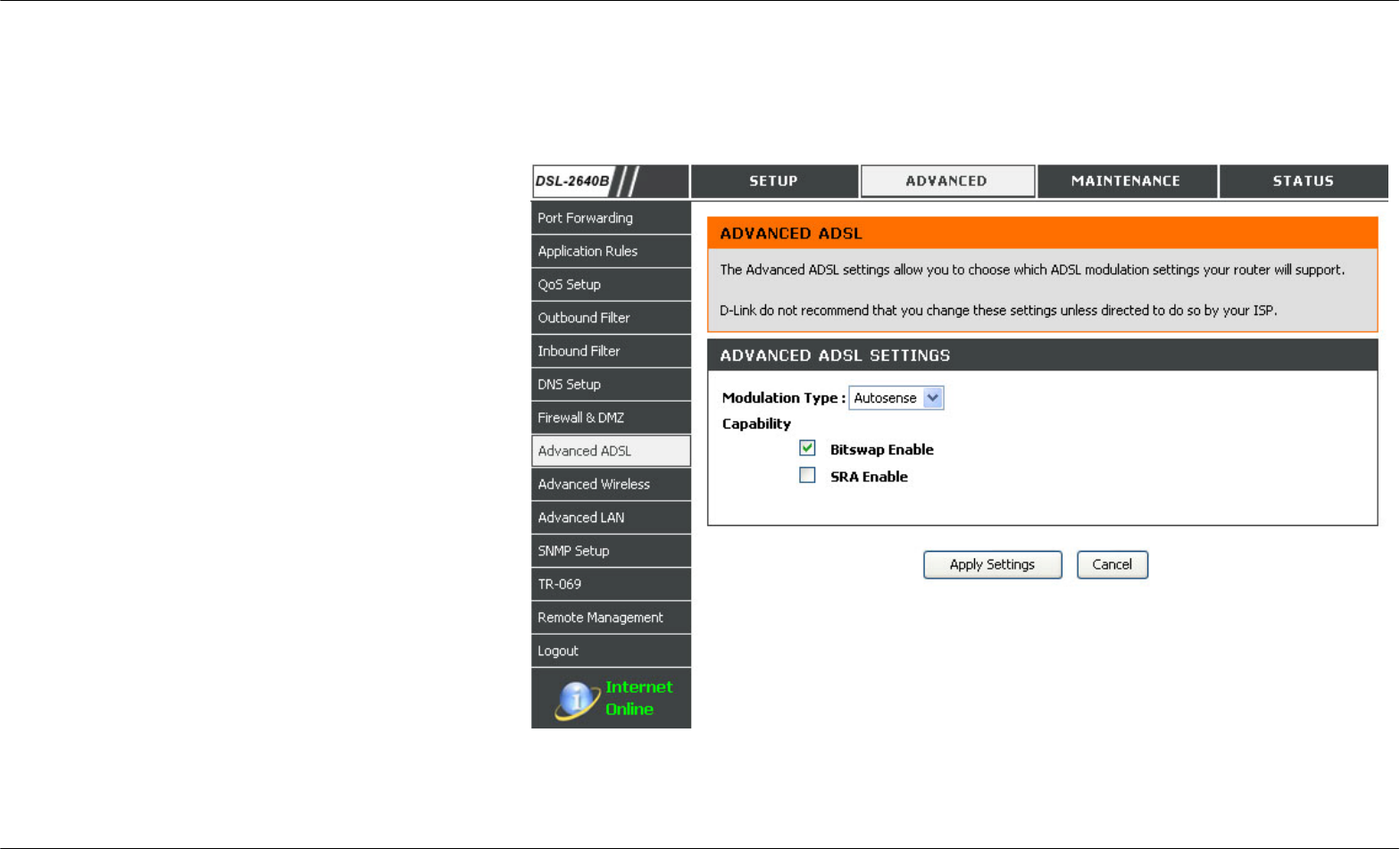
Section 4 - Troubleshooting
D-Link DSL-2640B User Manual 52
ADVANCED ADSL
The ADVANCED ADSL settings allow you to choose which ADSL modulation settings your modem router will support.
D-Link does not recommend changing these settings unless directed to do so by your ISP.
To access the ADVANCED ADSL setting window, click on the Advanced ADSL button in the ADVANCED directory.
ADVANCED ADSL SETTINGS
The Modulation Type drop-down menu allows the
user to select the configuration for ADSL protocols.
For most ADSL accounts the default settings (Auto
sense) will work. This configuration works with all
ADSL implementations. Do not change any settings
unless you have been instructed.
To make ADSL settings, select the desired items and
click on the Apply Settings button to apply the
settings.
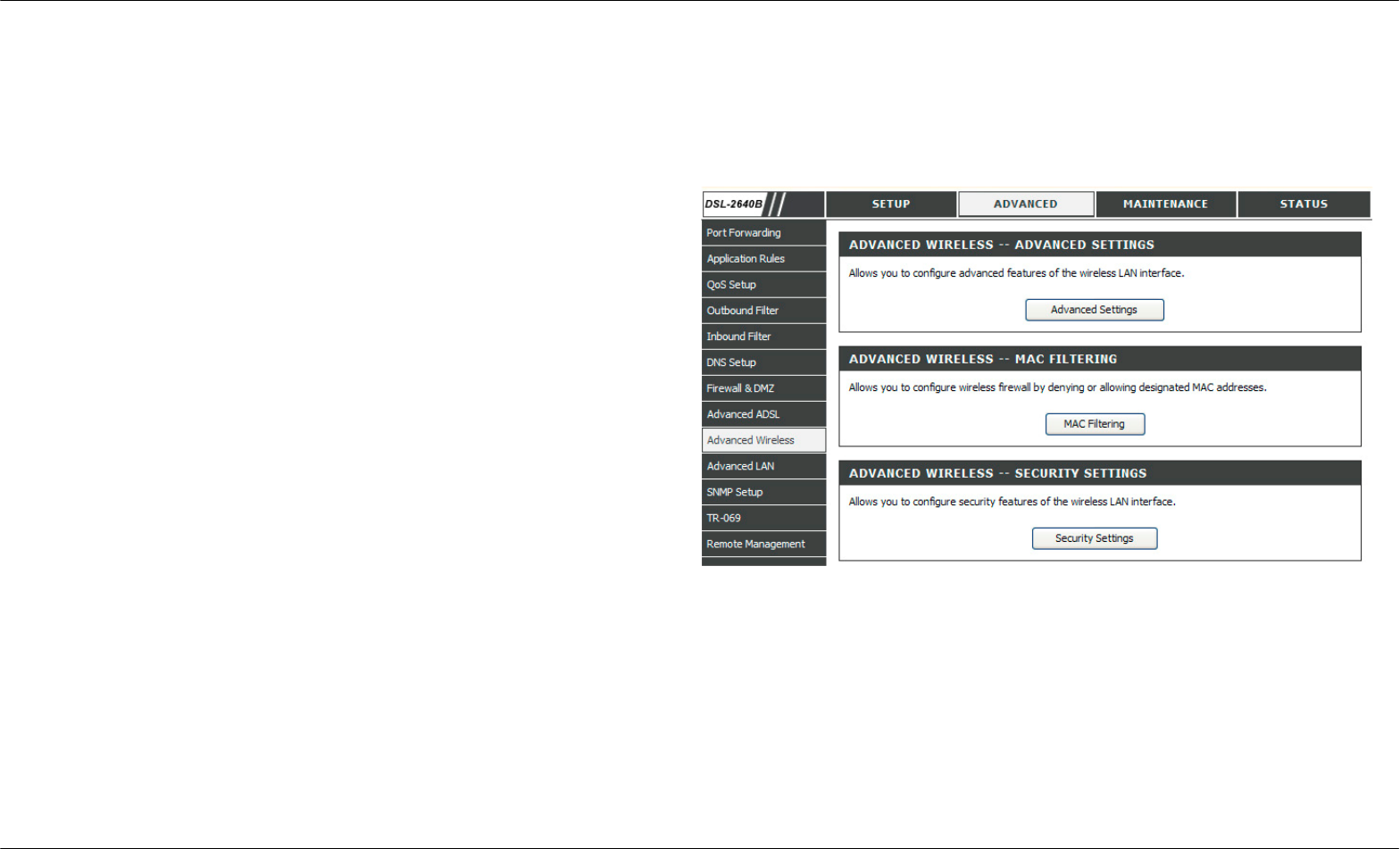
Section 4 - Troubleshooting
D-Link DSL-2640B User Manual 53
ADVANCED WIRELESS
These options are for users that wish to change the behavior of their 802.11g wireless radio from the standard setting. D-Link does not recommend
changing these settings from the factory default. Incorrect settings may impair the performance of your wireless radio. The default settings should
provide the best wireless radio performance in most environments.
To access the ADVANCED WIRELESS setting window, click on the Advanced Wireless button in the ADVANCED directory.
ADVANCED WIRELESS SETTINGS
This page allows you 3 options.
Advanced Settings to change advanced wireless settings
MAC Filtering to configure wireless firewall by denying or allowing
designated MAC addresses
Security Settings to configure Wireless LAN security.

Section 4 - Troubleshooting
D-Link DSL-2640B User Manual 54
ADVANCED SETTINGS – ADVANCED WIRELESS SETTINGS
Transmission Rate: The wireless link rate for the transmit/receive of your wireless
network
Multicast Rate: Rate in which a message is sent to a group of recipients
Transmit Power: The percentage of power transmitted from your wireless network.
Beacon Period: This value indicates the frequency interval of the beacon. Where
the value is between 20 to 65535 milliseconds.
RTS Threshold: (Request to Send Threshold) is used to determine the packet
size of a wireless packet to help control traffic flow.
Fragmentation
Threshold:
Maximum frame size. Frame larger than the threshold are
fragmented into multiple packets and transmitted. The range is
256~2346 bytes.
DTIM Interval: Sets the Wake-up interval in power-saving mode. The range is
1~255 milliseconds,
Preamble Type: This is the length of the CRC (Cyclic Redundancy Check) block
for communication between the router and wireless clients. High
network traffic areas should select Short preamble type
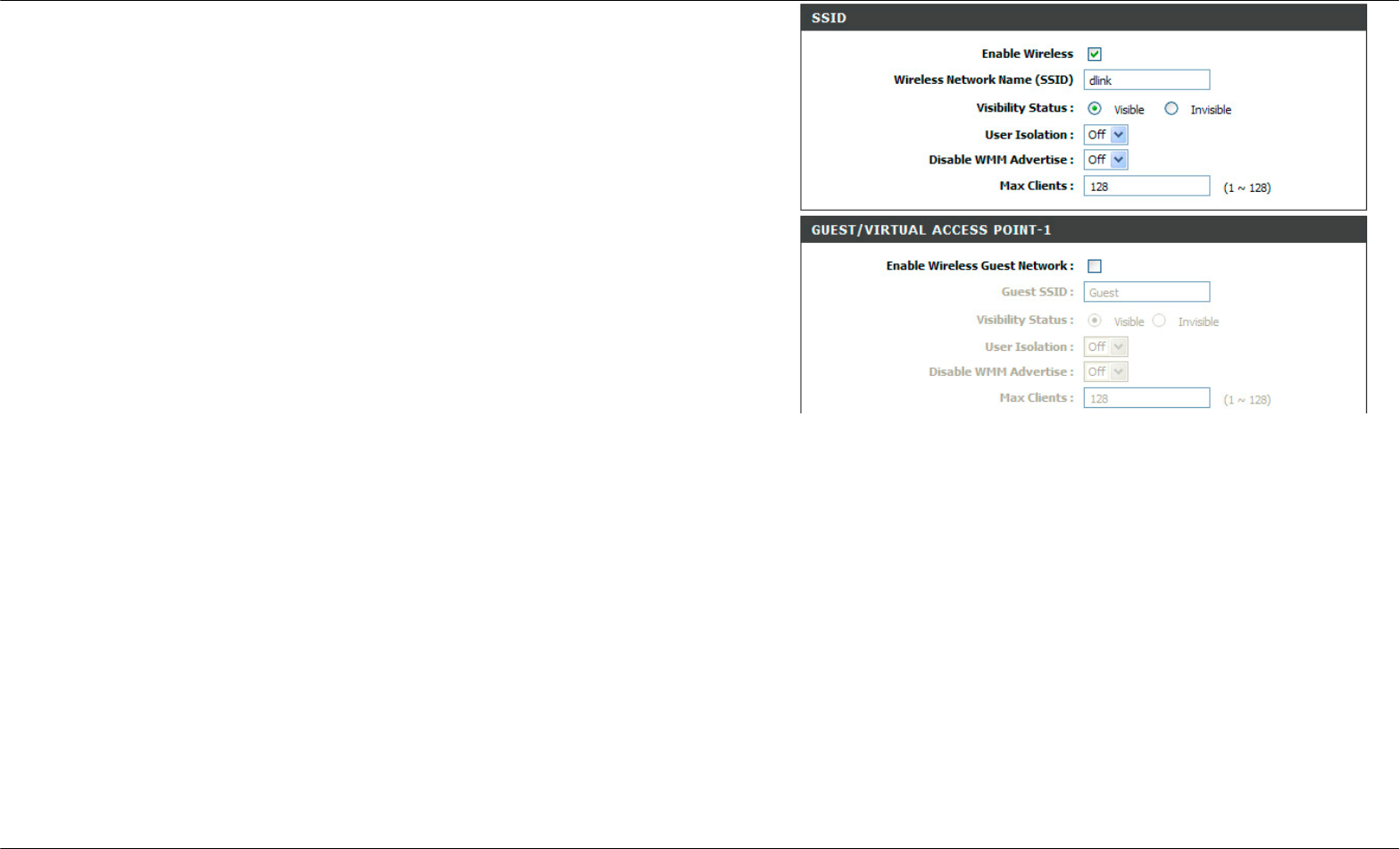
Section 4 - Troubleshooting
D-Link DSL-2640B User Manual 55
ADVANCED SETTINGS – ADVANCED WIRELESS SETTINGS
SSID, GUEST/VIRTUAL ACCESS POINT- 1,2 & 3
The router allows 1 SSID and 3 Virtual Access Points to be configured.
To enable the setting for a SSID or Virtual Access Points, check the Enable
Wireless or Enable Wireless Guest Network checkbox.
Specify the Wireless Network Name or Guest SSID and determine its Visibility
Status to be Visible or Invisible.
Choose if you want to turn on User Isolation and Disable WMM Advertise.
Specify the Max Client value between a range of 1to 128 for that SSID or Guest
Network.
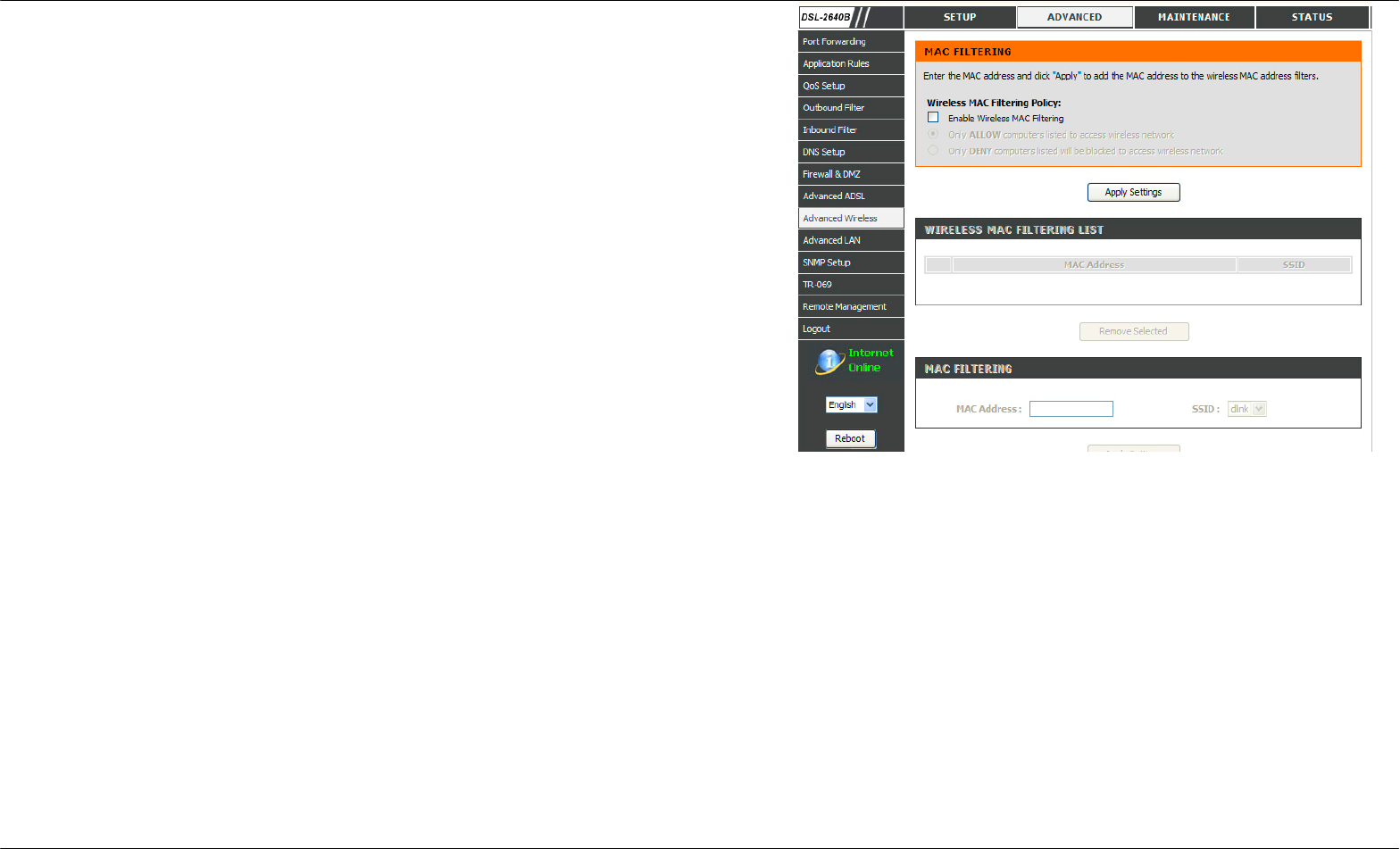
Section 4 - Troubleshooting
D-Link DSL-2640B User Manual 56
ADVANCED SETTINGS – MAC FILTERING
Tick the Enable Wireless MAC Filtering checkbox to enable Wireless MAC
filtering. Then choose if you want to Allow or Deny the wireless clients with the
MAC address in the WIRELESS MAC FILTERING LIST.
To add a new MAC address. Enter the MAC Address. Specify the SSID and click
on the Apply Settings button.

Section 4 - Troubleshooting
D-Link DSL-2640B User Manual 57
ADVANCED SETTINGS – SECURITY SETTINGS
The security settings in Advanced Settings allows you to set security settings by
SSID.
Please consult how to configure security settings in the SETUP tab for configuring
security for your wireless security.

Section 4 - Troubleshooting
D-Link DSL-2640B User Manual 58
ADVANCED LAN
The ADVANCED LAN options are for users that wish to change the LAN settings. D-Link does not recommend changing these settings from factory
default. Changing these settings may affect the behavior of your network.
UPnP is used for much popular Audio Visual software. It allows the auto discovery of your device on the network. If you feel that UPnP is a security
concern we provide you with the option to disable it here. Block ICMP Ping should be enabled so that the router does not respond to malicious
Internet requests. Multicast streams are used by advance network functions like IPTV and distributed by your ISP.
To access the ADVANCED LAN setting window, click on the Advanced LAN button in the ADVANCED directory.

Section 4 - Troubleshooting
D-Link DSL-2640B User Manual 59
UPNP
Check the Enable UPnP box to enable the UPnP function.
MULTICAST STREAMS
Check the Enable Multicast Streams box to allow the
multicast packets received from WAN to LAN.
Click on the Apply Settings button to apply settings.
ROUTING – RIP CONFIGURATION
Check the Enable Global RIP Mode to enable RIP
configuration to be applied globally
Select which Interface RIP packets are to be used and select
the RIP Version 1,2 or both. Choose if the Operation is
Active or Passive and check the Enabled checkbox to
enable the selected Interface for RIP protocol

Section 4 - Troubleshooting
D-Link DSL-2640B User Manual 60
STATIC ROUTE AND ROUTING ADD
Click on the Add button to Add a Static Route and Delete
button to remove a Static route
To add a Static Route, enter a value in Destination Network
Address and the Subnet Mask to be used and select Use
Gateway IP Address or Use Interface where the static
route would be used.
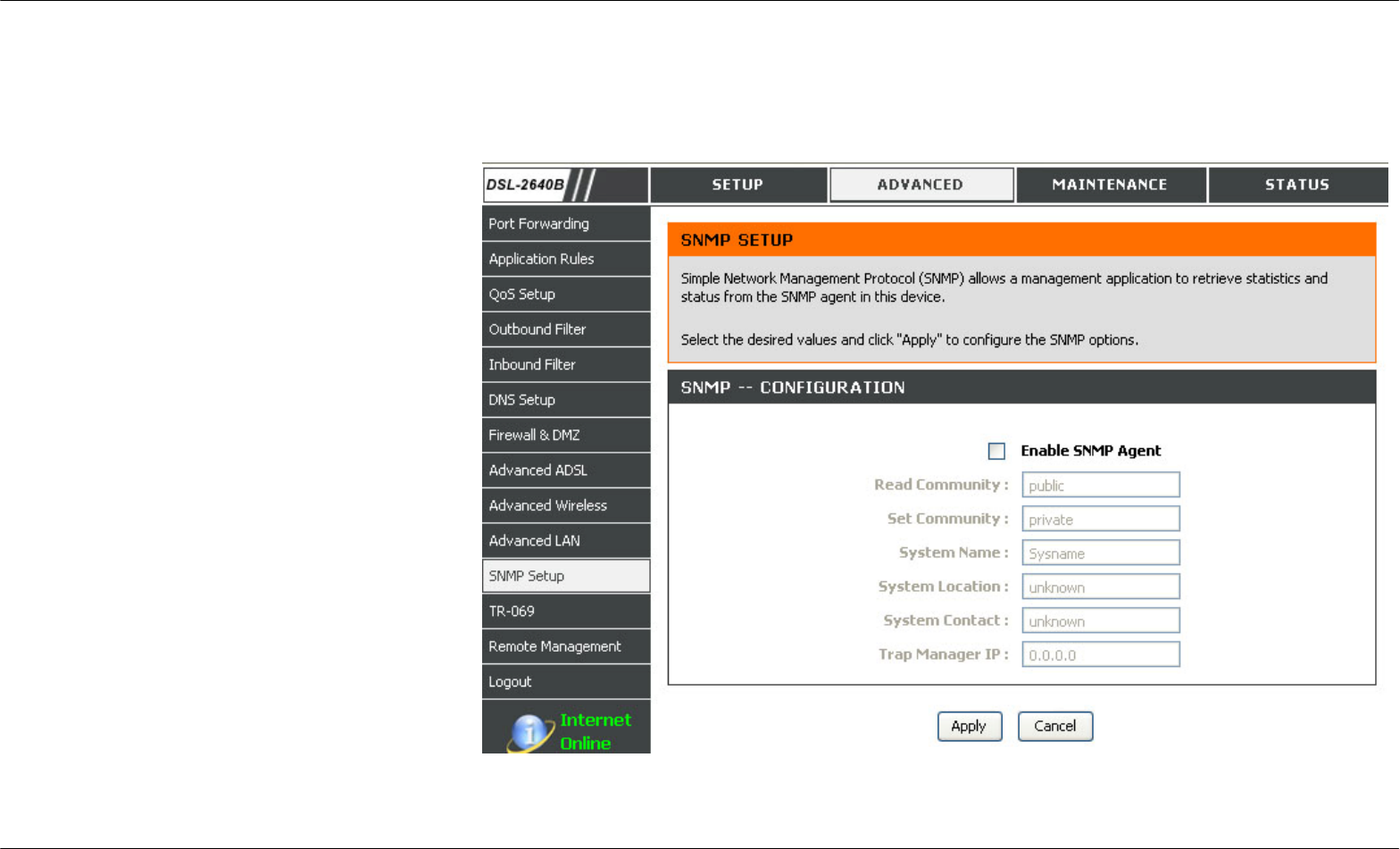
Section 4 - Troubleshooting
D-Link DSL-2640B User Manual 61
SNMP SETUP
Simple Network Management Protocol (SNMP) allows a management application to retrieve statistics and status from the SNMP agent in this
device.
To access the SNMP SETUP setting window, click on the SNMP SETUP button in the ADVANCED directory.
SNMP CONFIGURATION
Check the Enable SNMP Agent checkbox to
allow the device’s SNMP agent to work.
Specify the Read Community, Set Community,
System Name, System Location, System
Contact and the Trap Manager IP to allow
SNMP agent to work properly.
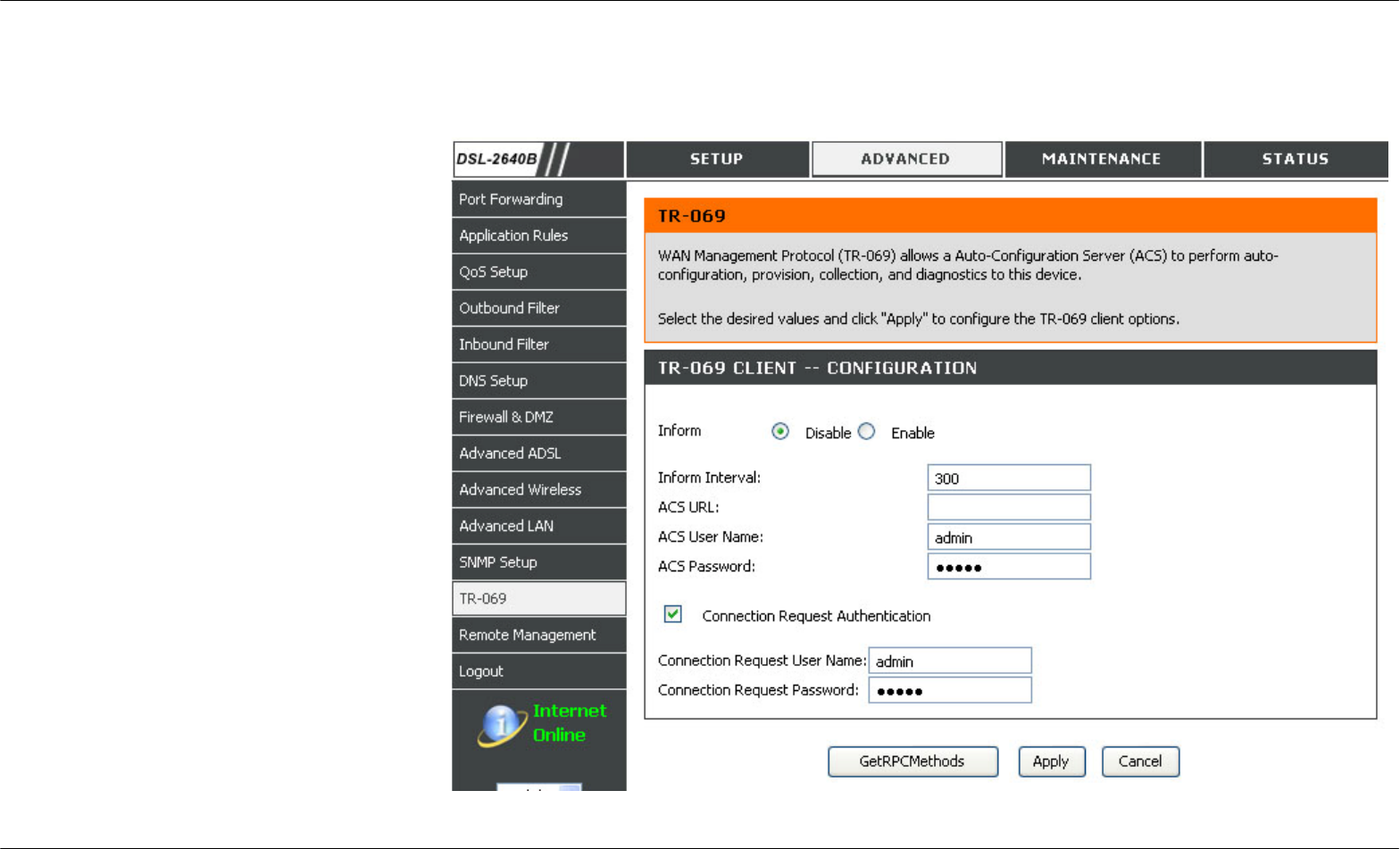
Section 4 - Troubleshooting
D-Link DSL-2640B User Manual 62
TR-069
TR-069 allows an Auto Configuration Server (ACS) to manage this device remotely.
To access the TR-069 setting window, click on the TR-069 button in the ADVANCED directory.
TR-069
Choose to enable or disable the Inform
feature of TR-069 client
Specify the Inform Interval, ACS URL, ACS
User Name, and the ACS Password to allow
TR-069 agent to work properly.
Tick on the Connection Request
Authentication if you want to enable
authentication before the router could be
managed. Specify the Connection Request
User Name and Connection Request
Password.
Click on the Apply button for changes to take
effect.
Click on the GetRPCMethods button to get
RPC methods of the ACS server.
Note: Choose to change this option if only
specified by your ISP.

Section 4 - Troubleshooting
D-Link DSL-2640B User Manual 63
REMOTE MANAGEMENT
This section allows you to enable/disable remote access to the router from the Internet. Remote access control allows you to configure access via
specific services. Most users will not need to change any of these settings.
To access the REMOTE MANAGEMENT setting window, click on the Remote Management button under the ADVANCED tab.
REMOTE MANAGEMENT SETTINGS
Check the Enable Remote Management box to enable the
remote management.
Input the Remote Admin Port listened by the web UI for the
remote PC to browse.
Select the Remote Admin Inbound Filter to filter the remote PCs
who want to use remote management.
REMOTE ACCESS CONTROL
Select the management services which you want to
enable/disable on your LAN/WAN interface.
Click on the Apply Settings button to apply settings.
Notice If you disable HTTP service, you’ll not be able to access
the router’s configuration window permanently.

Section 4 - Troubleshooting
D-Link DSL-2640B User Manual 64
MAINTENANCE
Click on the MAINTENANCE tab to reveal the window buttons for various functions located in this directory. The PASSWORD window is the first
item in the MAINTENANCE directory.
PASSWORD
The factory default password of this router is 'admin'. To help secure your network, D-Link recommends that you should choose a new password.
Please make sure to choose a password you can remember or write it down and keep in a safe and separate location for future reference. If you
forget your device password, the only solution is to reset your router to factory default settings and you will loose all your device configuration
settings.
To access the PASSWORD setting window, click on the Password button under the MAINTENANCE tab.
SET PASSWORD (OPTIONAL)
To change password, enter the old/new password.
Click on the Apply Settings button to apply settings.
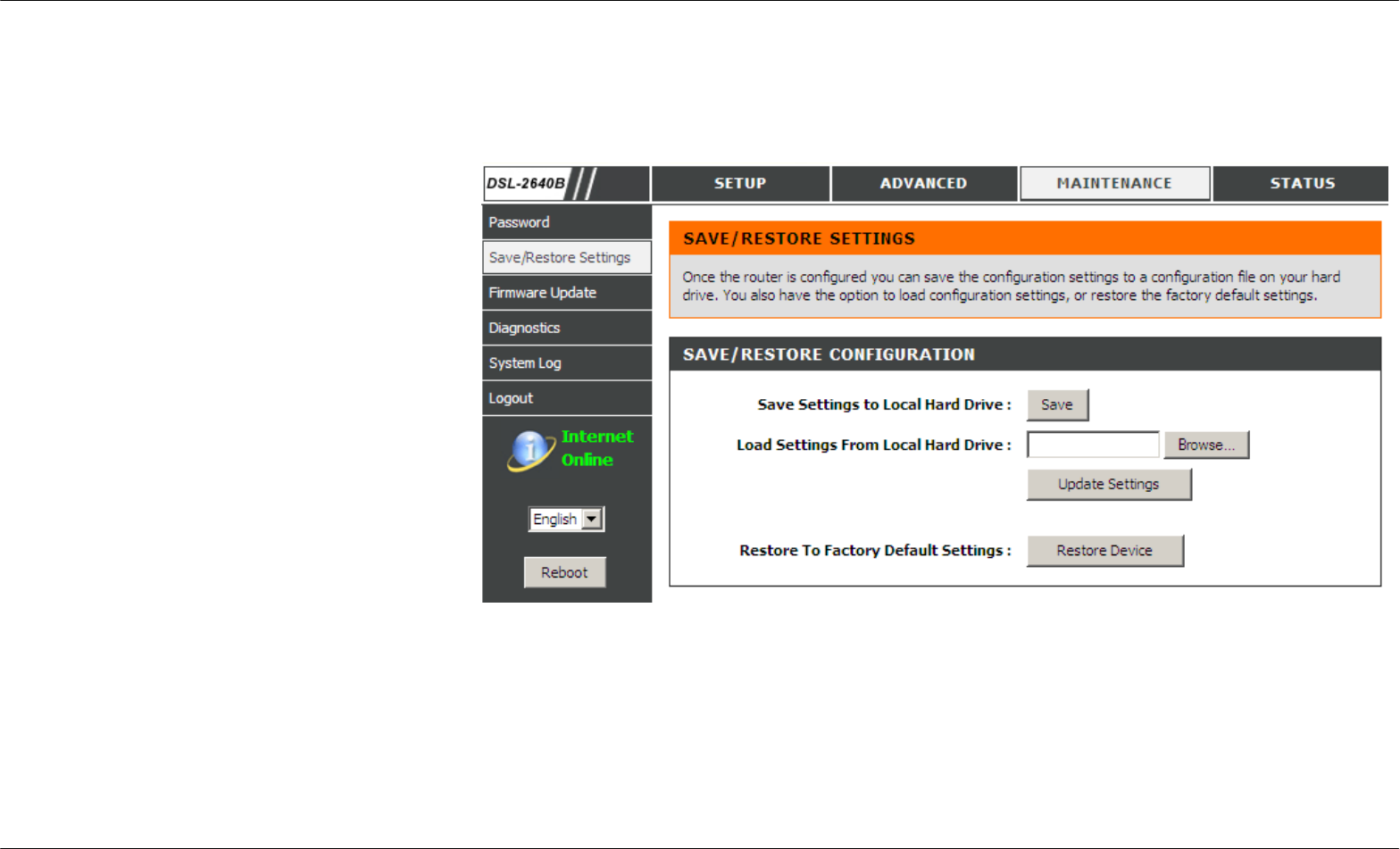
Section 4 - Troubleshooting
D-Link DSL-2640B User Manual 65
SAVE/RESTORE SETTINGS
Once the router is configured you can save the configuration settings to a configuration file on your hard drive. You also have the option to load
configuration settings, or restore the factory default settings.
To access the SAVE/RESTORE SETTINGS setting window, click on the Save/Restore Settings button under the MAINTENANCE tab.
SAVE/RESTORE CONFIGURATION
Click on the Save button to Save Settings to
Local Hard Drive. You will be prompted to select
a location on your computer to put the file. You
may name the configuration file anything you
like.
Click on the Browse button to browse to the
configuration file in the PC and click on the
Update Settings button to load settings from
local hard drive. Confirm that you want to load
the file when prompted and the process will
complete automatically. The Router will reboot
and begin operating with the configuration
settings that have just been loaded.
To reset the Router to its factory default settings,
click on the Restore Device button. You will be
prompted to confirm your decision to reset the
Router. The Router will reboot with the factory
default settings including IP settings
(192.168.1.1) and Administrator password
(admin).
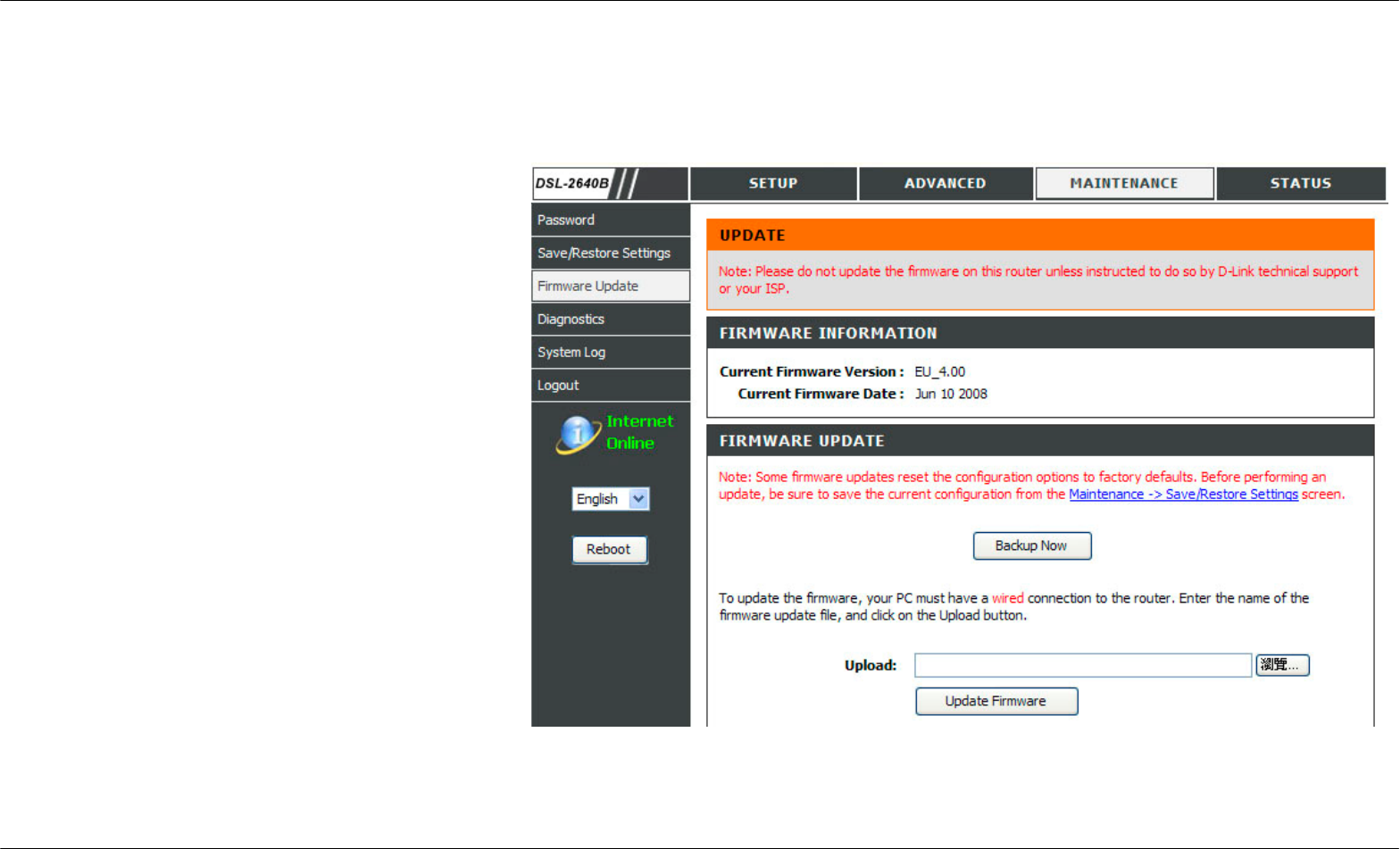
Section 4 - Troubleshooting
D-Link DSL-2640B User Manual 66
FIRMWARE UPDATE
Use the FIRMWARE UPDATE window to load the latest firmware for the device. Note that the device configuration settings may return to the factory
default settings, so make sure you first save the configuration settings with the SAVE/RESTORE SETTINGS window described above.
To access the FIRMWARE UPDATE setting window, click on the Firmware Update button under the MAINTENANCE tab.
FIRMWARE UPDATE
To update firmware, click on the Browse… button to
search for the file and then click on the Update
Firmware button to begin copying the file. The Router
will load the file and restart automatically.
Notice Performing a Firmware Upgrade can
sometimes change the configuration settings. Be sure
to back-up the Router’s configuration settings before
upgrading the firmware.
**The current firmware version in the screenshot may not be the
same as the one in the current product.**
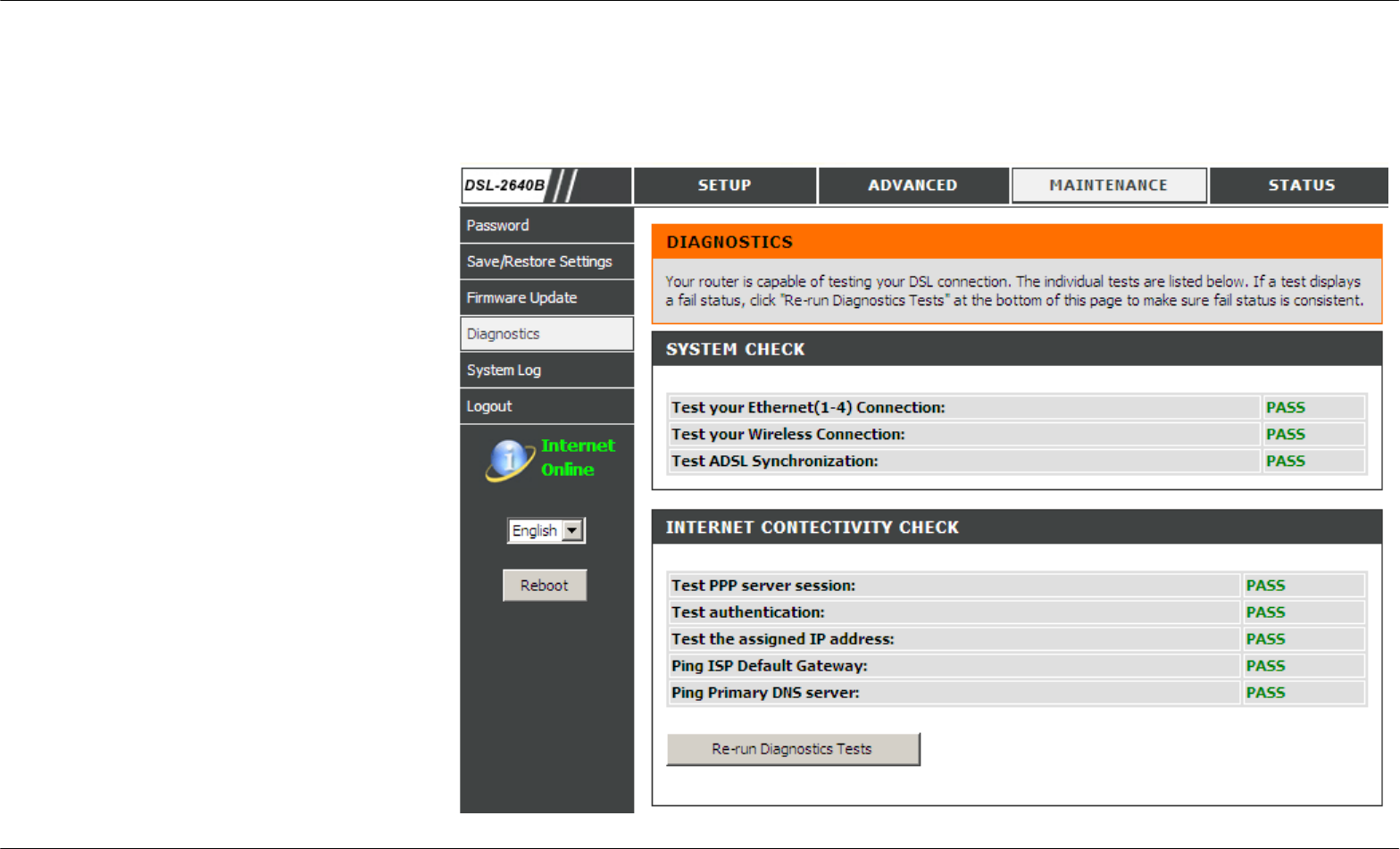
Section 4 - Troubleshooting
D-Link DSL-2640B User Manual 67
Diagnostics
This page shows the result of your router’s self diagnostic and connection test results. The Internet connectivity status will only show PASS if you
have correctly configured your Internet connection and your router is currently online.
To access the DIAGNOSTICS setting window, click on the Diagnostics button under the MAINTENANCE tab.
INTERNET CONNECTIVITY CHECK
Click on the Re-run Diagnostics Tests button
to run the diagnostics again.
Notice: The Diagnostic Test window is used
to test connectivity of the Router. A Ping test
may be done through the local or external
interface to test connectivity to known IP
addresses. The diagnostics feature executes
a series of test on your system software and
hardware connections. Use this window when
working with your ISP to troubleshoot
problems.
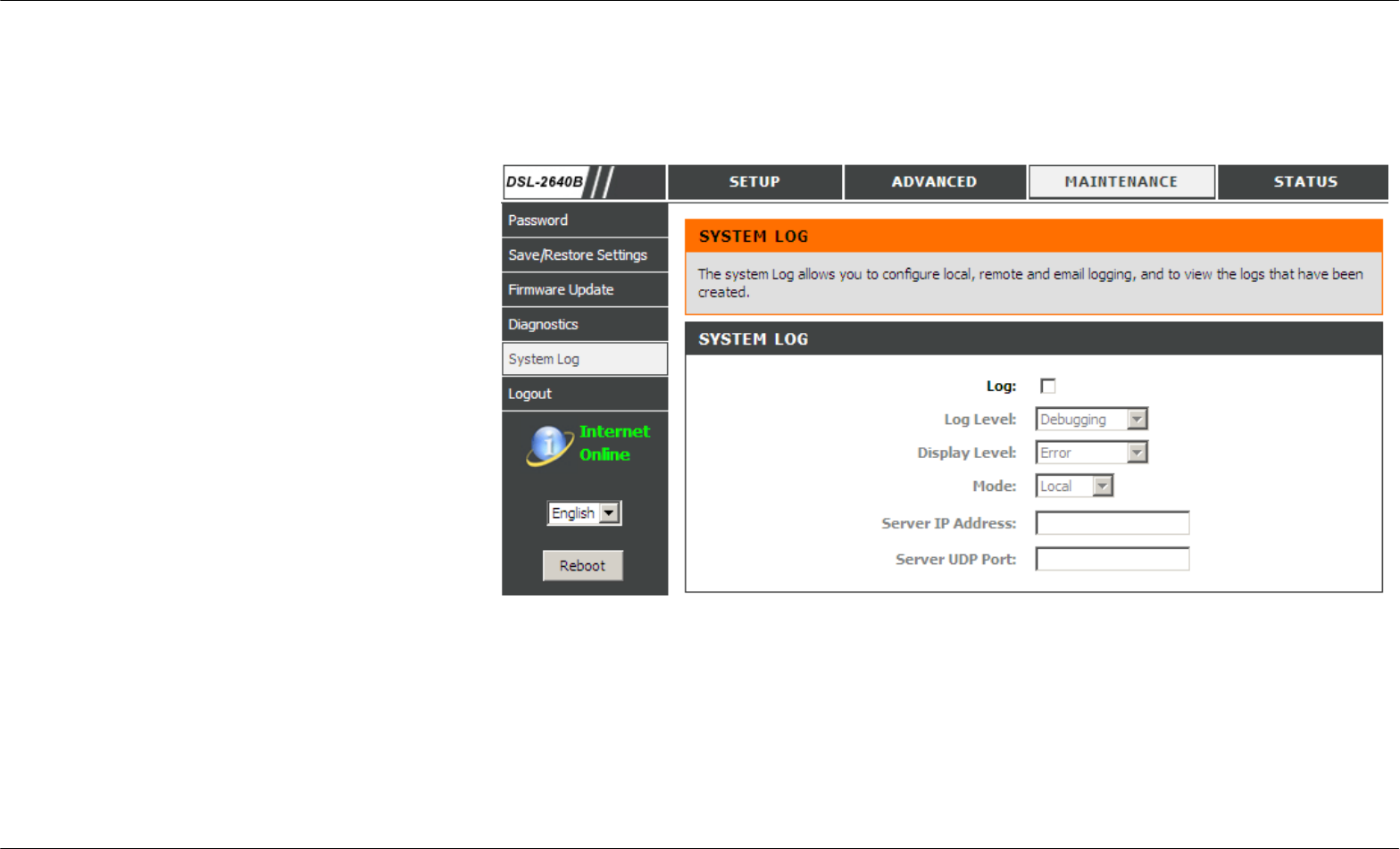
Section 4 - Troubleshooting
D-Link DSL-2640B User Manual 68
SYSTEM LOG
The system log displays chronological event log data. The event log can be read from local host or sent to a System Log server. The available event
severity levels are: Emergency, Alert, Critical, Error, Warning, Notice, Informational and Debugging.
To access the SYSTEM LOG setting window, click on the System Log button under the MAINTENANCE tab.
SYSTEM LOG
Click on the Log checkbox and select Log/Display
Level from the drop-down menu.
Select display mode from the Mode drop-down
menu, enter the Server IP Address and Server
UDP Port number if Both/Remote Mode is
selected.
Log Level: All events above or equal to the
selected level will be logged.
Display
Level:
All logged events above or equal
to the selected level will be
displayed.
Display mode of system log.
Local: Display on local host only
Remote: Send log file to remote
system log server only
Mode:
Server IP
Address:
IP address of the remote system
log server
Server UDP
Port:
UDP port number of the remote
system log server
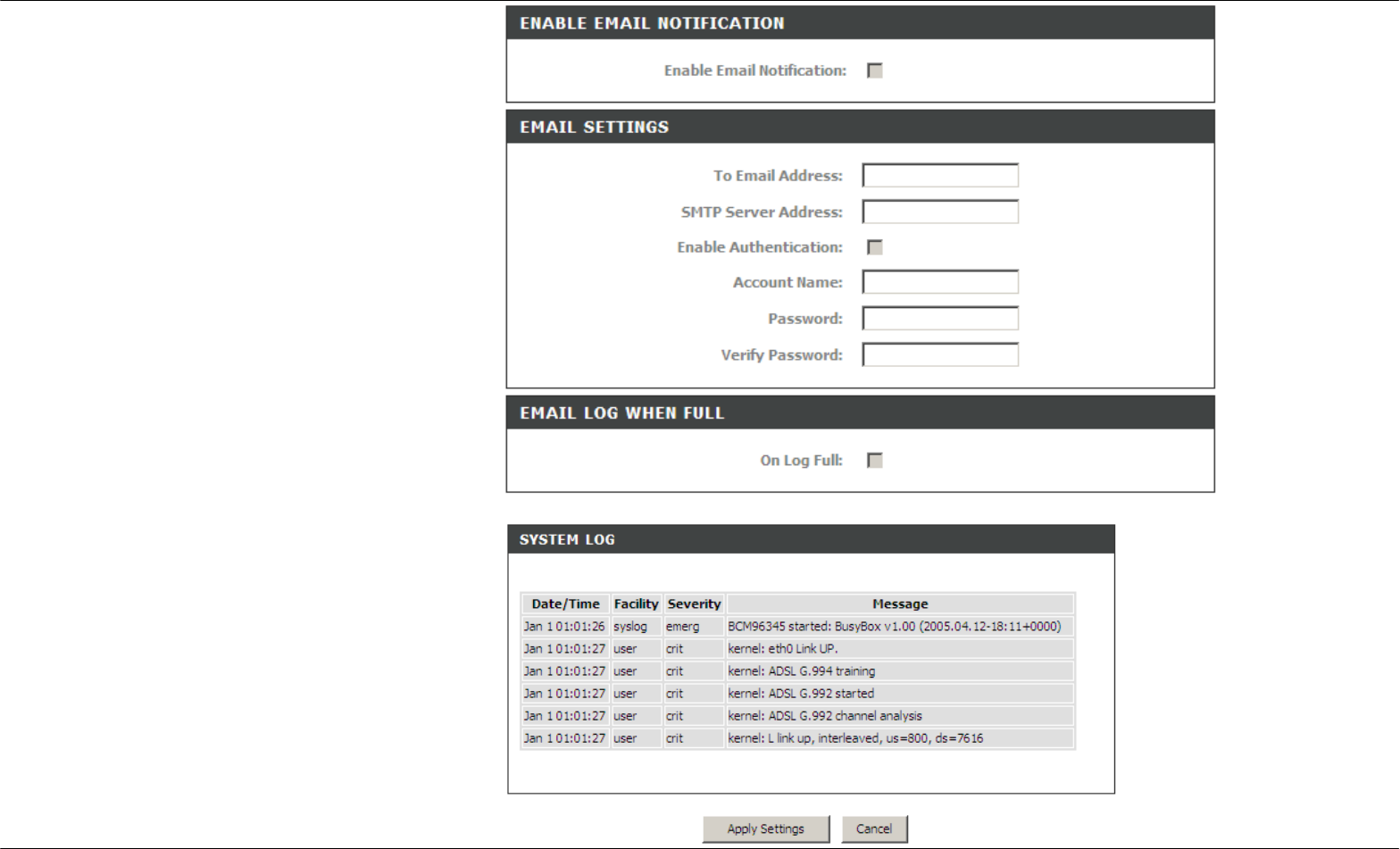
Section 4 - Troubleshooting
D-Link DSL-2640B User Manual 69
ENABLE EMAIL NOTIFICATION
Click on the Enable EMAIL Notification
check-box to enable the E-mail alarm system log.
EMAIL SETTINGS
Set the E-mail address messages to receive the
E-mail alarm system log.
EMAIL LOG WHEN FULL
Click on the On Log Full check-box to let the
system send the E-mail alarm message when the
local log is full.
VIEW SYSTEM LOG
The table lists the system log.
Click on the Apply Settings button to apply
your settings.

Section 4 - Troubleshooting
D-Link DSL-2640B User Manual 70
STATUS
Click on the STATUS tab to reveal the window buttons for various functions located in this directory. The DEVICE INFO window is the first item in
the STATUS directory. Use these windows to view system information and monitor performance.
DEVICE INFO
The Device Info page displays a summary overview of your router status, including: Device software version and summary of your Internet
configuration (both wireless and Ethernet status).
To access the DEVICE INFO setting window, click on the Device Info button in the STATUS directory.
GENERAL
This window displays current system time
and the firmware version.
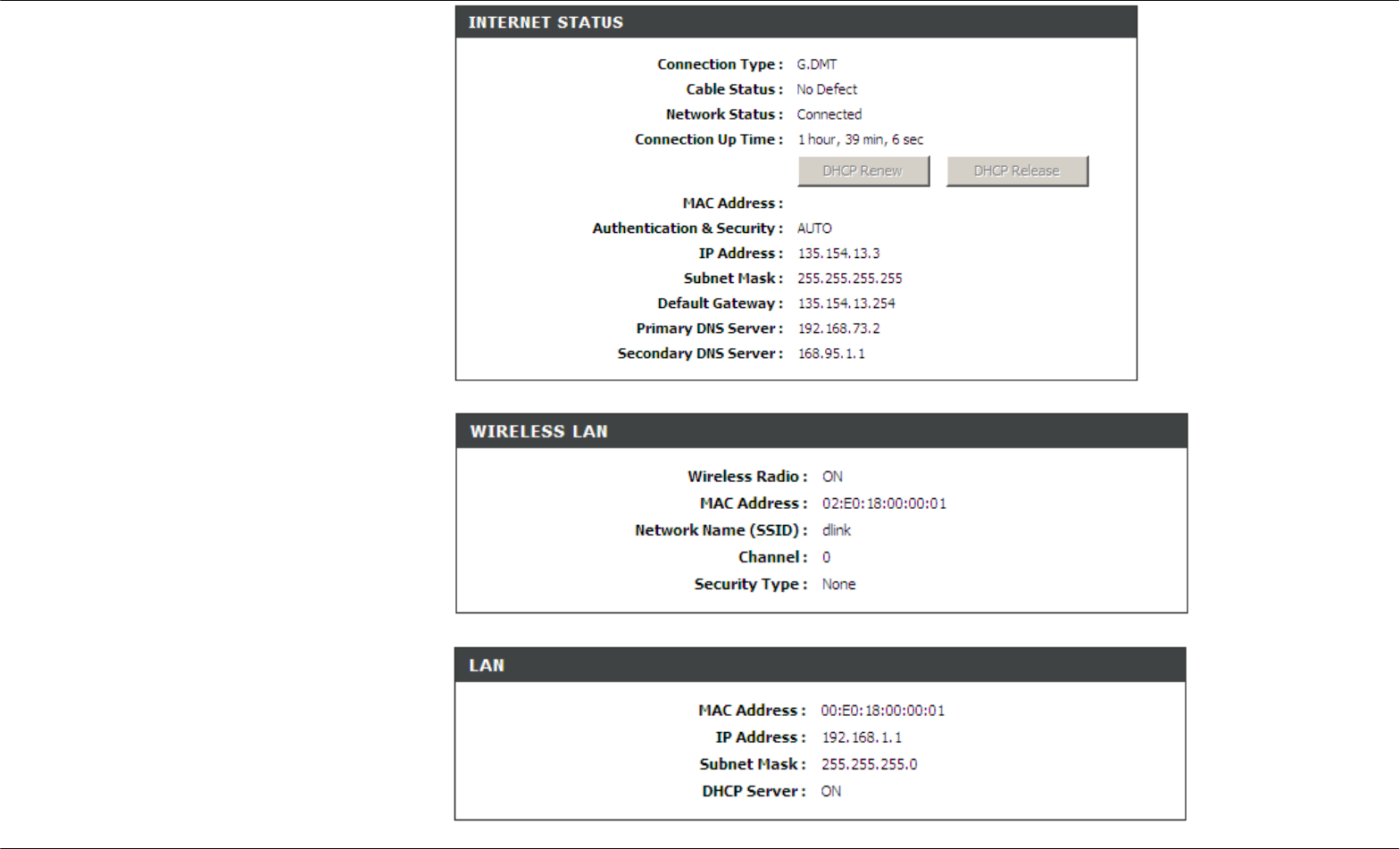
Section 4 - Troubleshooting
D-Link DSL-2640B User Manual 71
INTERNET STATUS
This window displays WAN information
including IP address, Mask, Default Gateway,
Primary/Secondary DNS Server.
WIRELESS LAN
This window displays authenticated wireless
stations and their status.
LAN
This window displays LAN information
including IP address, Subnet Mask, and
DHCP Server.
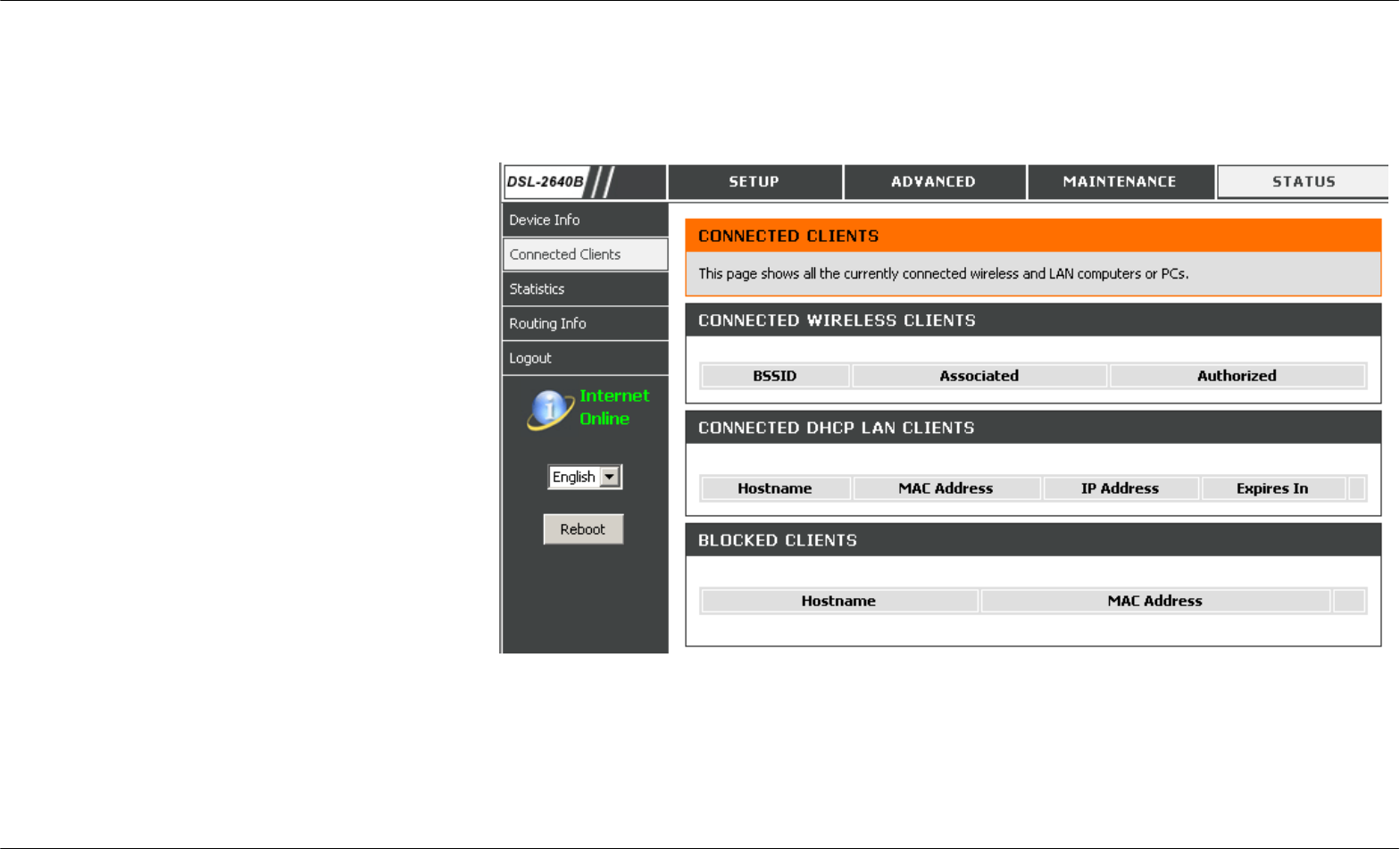
Section 4 - Troubleshooting
D-Link DSL-2640B User Manual 72
CONNECTED CLIENTS
This page shows all the currently connected wireless and LAN computers or PCs.
To access the CONNECTED CLIENTS setting window, click on the Connected Clients button in the STATUS directory.
CONNECTED WIRELESS CLIENTS
This window displays authenticated wireless
stations and their status.
CONNECTED DHCP LAN CLIENTS
This window displays all the client devices which
have obtained IP addresses from the router.
BLOCKED CLIENTS
This window displays the list of clients that are
blocked from having access to the router and the
Internet.
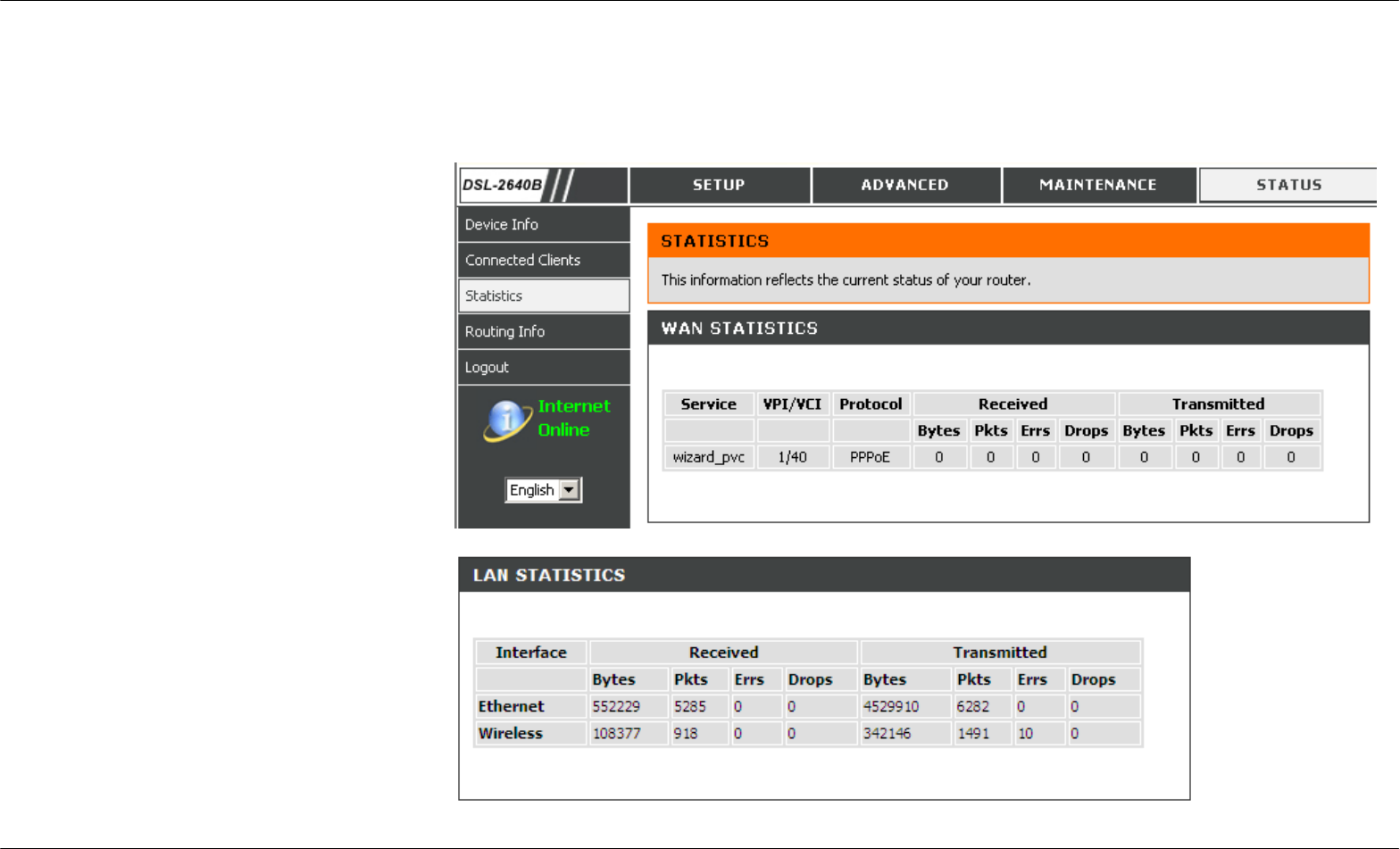
Section 4 - Troubleshooting
D-Link DSL-2640B User Manual 73
STATISTICS
This page displays your router network and data transfer statistics and is helpful for D-Link technicians to assist you in identifying if your router is
functioning properly. The information provided is primarily informative and does not affect the function of your router.
To access the STATISTICS setting window, click on the Statistics button in the STATUS directory.
WAN STATISTICS
This window displays WAN information
LAN STATISTICS
This window displays LAN information.

Section 4 - Troubleshooting
D-Link DSL-2640B User Manual 74
ADSL STATISTICS
This window displays ADSL information
including Link Rate, SNR, and some Error
Counters.
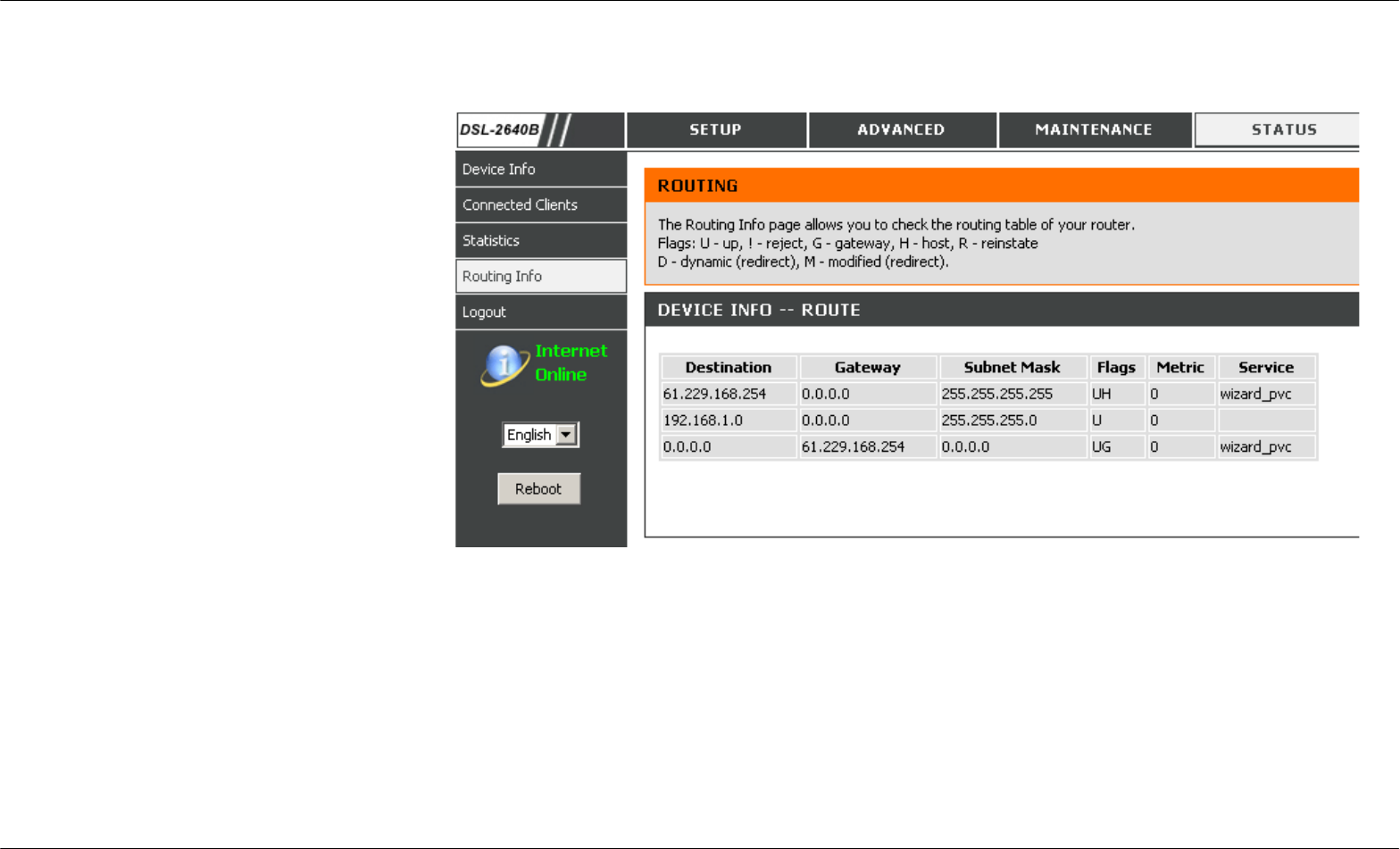
Section 4 - Troubleshooting
D-Link DSL-2640B User Manual 75
ROUTING INFO
This page displays the routing table of your router
To access the ROUTING INFO setting window, click on the ROUTING INFO button in the STATUS directory.
DEVICE INFO -- ROUTE
This window displays a table containing the
routing information of the router

Section 4 - Troubleshooting
D-Link DSL-2640B User Manual 76
Troubleshooting
This chapter provides solutions to problems that can occur during the installation and operation of the DSL-2640B. Read the following descriptions
if you are having problems. (The examples below are illustrated in Windows® XP. If you have a different operating system, the screenshots on your
computer will look similar to the following examples.)
1. Why can’t I access the web-based configuration utility?
When entering the IP address of the D-Link router (192.168.1.1 for example), you are not connecting to a website on the Internet or have to be
connected to the Internet. The device has the utility built-in to a ROM chip in the device itself.
Your computer must be on the same IP subnet to connect to the web-based utility.
x Make sure you have an updated Java-enabled web browser. We recommend the following:
x Internet Explorer 6.0 or higher
x Firefox 1.5 or higher
x Verify physical connectivity by checking for solid link lights on the device. If you do not get a solid link light, try using a different cable or connect
to a different port on the device if possible. If the computer is turned off, the link light may not be on.
x Disable any internet security software running on the computer. Software firewalls such as Zone Alarm, Black Ice, Sygate, Norton Personal
Firewall, and Windows® XP firewall may block access to the configuration pages. Check the help files included with your firewall software for
more information on disabling or configuring it.

Section 4 - Troubleshooting
D-Link DSL-2640B User Manual 77
x Configure your Internet settings:
x Go to Start > Settings > Control Panel. Double-click on the Internet Options Icon. From the Security tab, click on the button to restore
the settings to their defaults.
x Click on the Connection tab and set the dial-up option to Never Dial a Connection. Click on the LAN Settings button. Make sure nothing is
checked. Click on the OK.
x Go to the Advanced tab and click on the button to restore these settings to their defaults. Click on the OK button three times.
x Close your web browser (if open) and open it.
x Access the web management. Open your web browser and enter the IP address of your D-Link router in the address bar. This should open the
login page for the web management.
x If you still cannot access the configuration, unplug the power to the router for 10 seconds and plug back in. Wait about 30 seconds and try
accessing the configuration. If you have multiple computers, try connecting using a different computer.
2. What can I do if I forgot my password?
If you forgot your password, you must reset your router. Unfortunately this process will change all your settings back to the factory defaults.
To reset the router, locate the reset button (hole) on the rear panel of the unit. With the router powered on, use a paperclip to hold the button down
for 5-7 seconds. Release the button and the router will go through its reboot process.
Wait about 30 seconds to access the router. The default IP address is 192.168.1.1. When logging in, type in the default User Name “admin,” and the
default Password “admin” then click on the OK button to access the web-based manager.

Appendix A - Wireless Basics
D-Link DSL-2640B User Manual 78
Wireless Basics
D-Link wireless products are based on industry standards to provide easy-to-use and compatible high-speed wireless connectivity within your home,
business or public access wireless networks. Strictly adhering to the IEEE standard, the D-Link wireless family of products will allow you to securely
access the data you want, when and where you want it. You will be able to enjoy the freedom that wireless networking delivers.
A wireless local area network (WLAN) is a cellular computer network that transmits and receives data with radio signals instead of wires. Wireless
LANs are used increasingly in both home and office environments, and public areas such as airports, coffee shops and universities. Innovative
ways to utilize WLAN technology are helping people to work and communicate more efficiently. Increased mobility and the absence of cabling and
other fixed infrastructure have proven to be beneficial for many users.
Wireless users can use the same applications they use on a wired network. Wireless adapter cards used on laptop and desktop systems support
the same protocols as Ethernet adapter cards.
Under many circumstances, it may be desirable for mobile network devices to link to a conventional Ethernet LAN in order to use servers, printers
or an Internet connection supplied through the wired LAN. A Wireless Router is a device used to provide this link.
What is Wireless?
Wireless or Wi-Fi technology is another way of connecting your computer to the network without using wires. Wi-Fi uses radio frequency to connect
wirelessly, so you have the freedom to connect computers anywhere in your home or office network.
Why D-Link Wireless?
D-Link is the worldwide leader and award winning designer, developer, and manufacturer of networking products. D-Link delivers the performance
you need at a price you can afford. D-Link has all the products you need to build your network.
How does wireless work?
Wireless works similar to how cordless phone work, through radio signals to transmit data from one point A to point B. But wireless technology has
restrictions as to how you can access the network. You must be within the wireless network range area to be able to connect your computer. There
are two different types of wireless networks Wireless Local Area Network (WLAN), and Wireless Personal Area Network (WPAN).

Appendix A - Wireless Basics
D-Link DSL-2640B User Manual 79
Wireless Local Area Network (WLAN)
In a wireless local area network, a device called an Access Point (AP) connects computers to the network. The access point has a small antenna
attached to it, which allows it to transmit data back and forth over radio signals. With an indoor access point as seen in the picture, the signal can
travel up to 300 feet. With an outdoor access point the signal can reach out up to 30 miles to serve places like manufacturing plants, industrial
locations, college and high school campuses, airports, golf courses, and many other outdoor venues.
Wireless Personal Area Network (WPAN)
Bluetooth is the industry standard wireless technology used for WPAN. Bluetooth devices in WPAN operate in a range up to 30 feet away.
Compared to WLAN the speed and wireless operation range are both less than WLAN, but in return it doesn’t use nearly as much power which
makes it ideal for personal devices, such as mobile phones, PDAs, headphones, laptops, speakers, and other devices that operate on batteries.
Who uses wireless?
Wireless technology as become so popular in recent years that almost everyone is using it, whether it’s for home, office, business, D-Link has a
wireless solution for it.
Home
x Gives everyone at home broadband access
x Surf the web, check email, instant message, download multimedia files.
x Gets rid of the cables around the house
x Simple and easy to use
Small Office and Home Office
x Stay on top of everything at home as you would at the office
x Remotely access your office network from home
x Share the Internet connection and printer with multiple computers
x No need to dedicate office space
Where is wireless used?
Wireless technology is expanding everywhere not just at home or office. People like the freedom of mobility and it’s becoming so popular that more
and more public facilities now provide wireless access to attract people. The wireless connection in public places is usually called “hotspots”.

Appendix A - Wireless Basics
D-Link DSL-2640B User Manual 80
Using a D-Link Cardbus Adapter with your laptop, you can access the hotspot to connect to Internet from remote locations like: Airports, Hotels,
Coffee Shops, Libraries, Restaurants, and Convention Centers.
Wireless network is easy to setup, but if you’re installing it for the first time it could be quite a task not knowing where to start. That’s why we’ve put
together a few setup steps and tips to help you through the process of setting up a wireless network.
Tips
Here are a few things to keep in mind, when you install a wireless network.
Centralize your router or Access Point
Make sure you place the router/access point in a centralized location within your network for the best performance. Try to place the router/access
point as high as possible in the room, so the signal gets dispersed throughout your home. If you have a two-story home, you may need a repeater to
boost the signal to extend the range.
Eliminate Interference
Place home appliances such as cordless telephones, microwaves, and televisions as far away as possible from the router/access point. This would
significantly reduce any interference that the appliances might cause since they operate on same frequency.
Security
Don’t let you next-door neighbors or intruders connect to your wireless network. Secure your wireless network by turning on the WPA security
feature on the router. Refer to product manual for detail information on how to set it up.
Wireless Modes
There are basically two modes of networking:
xInfrastructure – All wireless clients will connect to an access point or wireless router.
xAd-Hoc – Directly connecting to another computer, for peer-to-peer communication, using wireless network adapters on each computer,
such as two or more D-Link wireless network adapters.
An Infrastructure network contains an Access Point or wireless router. All the wireless devices, or clients, will connect to the wireless router or
access point.
An Ad-Hoc network contains only clients, such as laptops with wireless cardbus adapters. All the adapters must be in Ad-Hoc mode to
communicate.
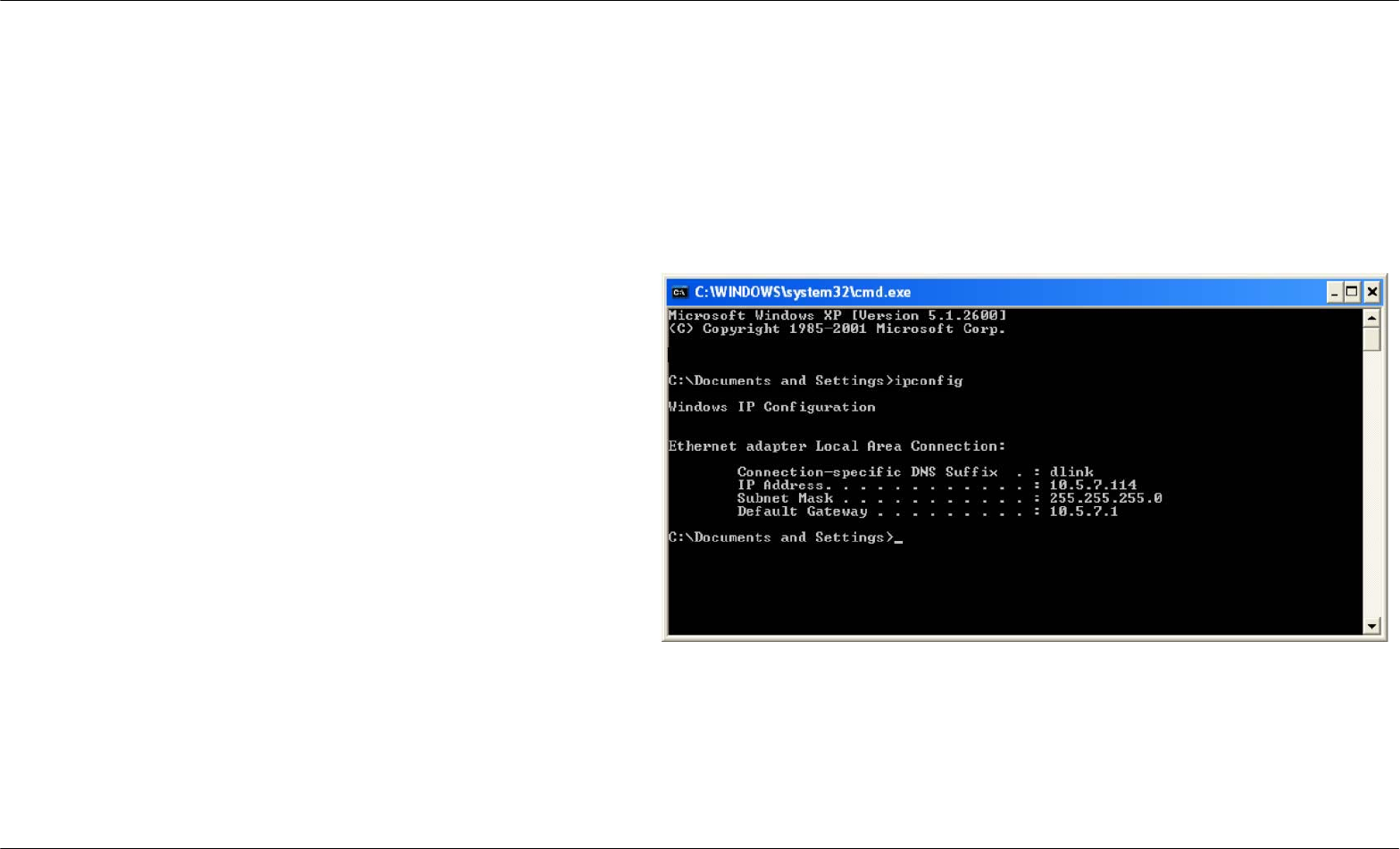
Appendix B - Networking Basics
D-Link DSL-2640B User Manual 81
Networking Basics
Check your IP address
After you install your new D-Link adapter, by default, the TCP/IP settings should be set to obtain an IP address from a DHCP server (i.e. wireless
router) automatically. To verify your IP address, please follow the steps below.
Click on Start >Run. In the run box type cmd and click on the OK.
At the prompt, type ipconfig and press Enter.
This will display the IP address, subnet mask, and the default
gateway of your adapter.
If the address is 0.0.0.0, check your adapter installation, security
settings, and the settings on your router. Some firewall software
programs may block a DHCP request on newly installed adapters.
If you are connecting to a wireless network at a hotspot (e.g. hotel,
coffee shop, airport), please contact an employee or administrator
to verify their wireless network settings.
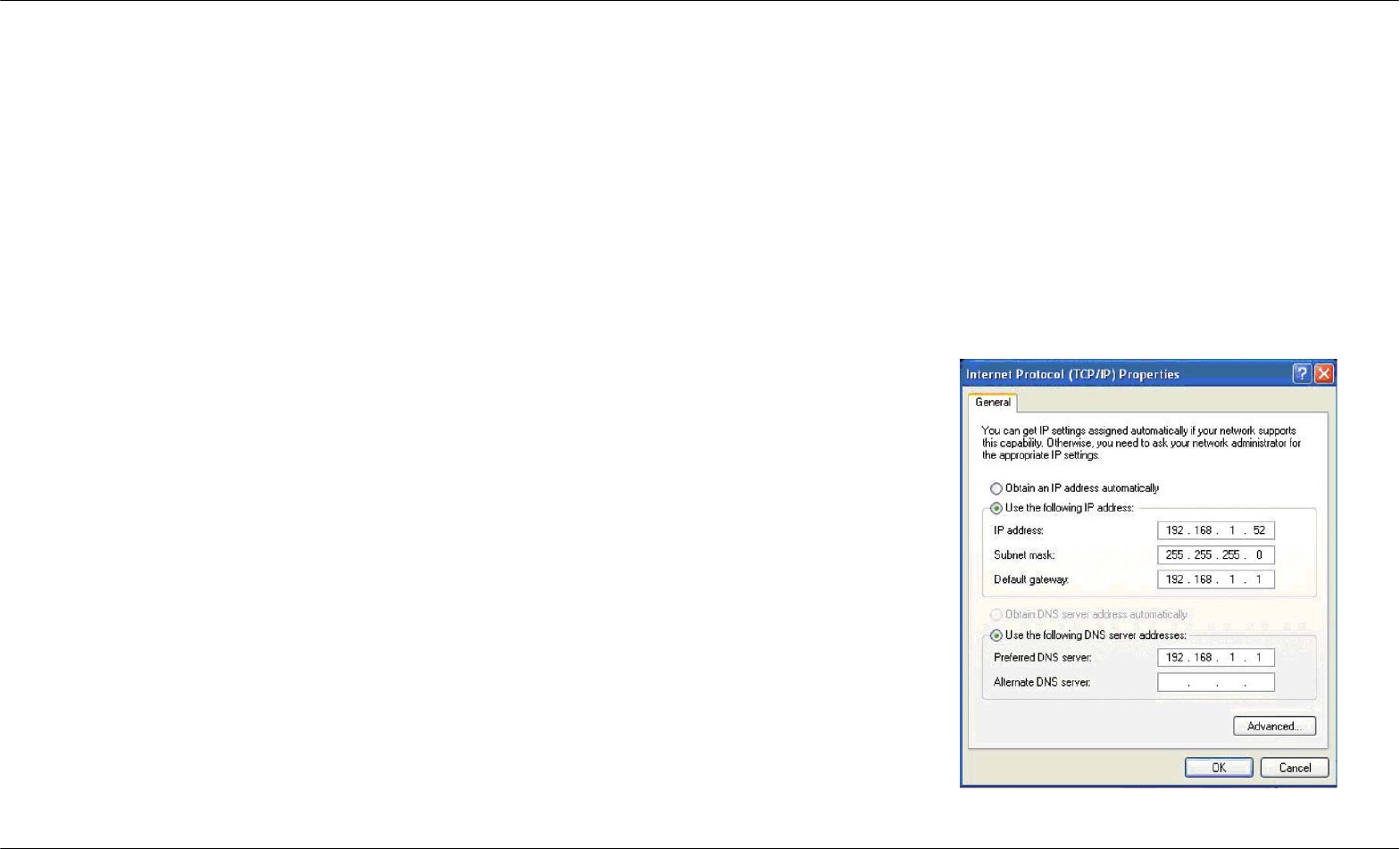
Appendix B - Networking Basics
D-Link DSL-2640B User Manual 82
Statically Assign an IP address
If you are not using a DHCP capable gateway/router, or you need to assign a static IP address, please follow the steps below:
Step 1
Windows¯ XP - Click on Start >Control Panel >Network Connections.
Windows¯ 2000 - From the desktop, right-click on the My Network Places >Properties.
Step 2
Right-click on the Local Area Connection which represents your D-Link network adapter and select Properties.
Step 3
Highlight Internet Protocol (TCP/IP) and click on the Properties.
Step 4
Click on the Use the following IP address and enter an IP address that is on the same subnet as
your network or the LAN IP address on your router.
Example: If the router’s LAN IP address is 192.168.1.1, make your IP address 192.168.1.X where X
is a number between 2 and 99. Make sure that the number you choose is not in use on the network.
Set Default Gateway the same as the LAN IP address of your router (192.168.1.1).
Set Primary DNS the same as the LAN IP address of your router (192.168.1.1). The Secondary
DNS is not needed or you may enter a DNS server from your ISP.
Step 5
Click on the OK twice to save your settings.

Appendix C – Technical Specification
D-Link DSL-2640B User Manual 83
Technical Specifications
ADSL Standards
x ANSI T1.413 Issue 2
x ITU G.992.1 (G.dmt) AnnexA
x ITU G.992.2 (G.lite) Annex A
x ITU G.994.1 (G.hs)
x ITU G.992.5 Annex A
ADSL2 Standards
x ITU G.992.3 (G.dmt.bis) Annex A
x ITU G.992.4 (G.lite.bis) Annex A
Protocols
x IEEE 802.1d Spanning
Tree
x TCP/UDP
x ARP
x RARP
x ICMP
x RFC1058 RIP v1
x RFC1213 SNMP v1 & v2c
x RFC1334 PAP
x RFC1389 RIP v2
x RFC1483/2684
Multiprotocol
Encapsulation over ATM
Adaptation Layer 5 (AAL5)
x RFC1994 CHAP
x RFC2131 DHCP Client /
DHCP Server
x RFC2364 PPP over ATM
x RFC2516 PPP over
Ethernet
Data Transfer Rate
x G.dmt full rate downstream: up to 8 Mbps / upstream: up to 1
Mbps
x G.lite: ADSL downstream up to 1.5 Mbps / upstream up to 512
Kbps
x G.dmt.bis full rate downstream: up to 12 Mbps / upstream: up to
12 Mbps
x ADSL full rate downstream: up to 24 Mbps / upstream: up to 1
Mbps
Media Interface
x ADSL interface: RJ-11 connector for connection to 24/26 AWG
twisted pair telephone line
x LAN interface: RJ-45 port for 10/100BASE-T Ethernet
connection
WIRELESS LAN
x 802.11b/g standards
x Wireless speed: up to
54Mbps (802.11G)
x Frequency range: 2.4 GHz
to 2.484G Hz
x Antenna: 1 detachable
dipole antenna.
x WEP data encryption
x WPA/WPA2 (Wi-Fi
Protected Access) security
x Multiple SSID
x 802.11e Wireless QoS
(WMM/WME)
x MAC address-based
access control
* Maximum wireless signal rate derived from IEEE Standard 802.11g specifications. Actual data throughput will vary. Network conditions and environmental factors, including
volume of network traffic, building materials and construction, and network overhead, lower actual data throughput rate. Environmental factors will adversely affect wireless
signal range.

Appendix D –Contacting Technical Support
D-Link DSL-2640B User Manual 84
Contacting Technical Support
You can find software updates and user documentation on the D-Link websites.
If you require product support, we encourage you to browse our FAQ section on the Web Site before contacting the Support line.
We have many FAQ’s which we hope will provide you a speedy resolution for your problem.
For Customers within the United Kingdom & Ireland:
D-Link UK & Ireland Technical Support over the Internet:
http://www.dlink.co.uk
ftp://ftp.dlink.co.uk
D-Link UK & Ireland Technical Support over the Telephone:
08456 12 0003 (United Kingdom)
+1890 886 899 (Ireland)
Lines Open
8.00am-10.00pm Mon-Fri
10.00am-7.00pm Sat & Sun
For Customers within Canada:
D-Link Canada Technical Support over the Telephone:
1-800-361-5265 (Canada)
Mon. to Fri. 7:30AM to 9:00PM EST
D-Link Canada Technical Support over the Internet:
http://support.dlink.ca
email: support@dlink.ca

APPENDIX
FCC Warning Statement
This device complies with Part 15 of the FCC Rules. Operation is subject to the following
two conditions:
(1) this device may not cause harmful interference, and
(2) this device must accept any interference received, including interference that may
cause undesired operation.
This equipment has been tested and found to comply with the limits for a class B digital device,
pursuant to part 15 of the FCC Rules. These limits are designed to provide reasonable protection
against harmful interference in a residential installation.
This equipment generates, uses and can radiate radio frequency energy and, if not installed and
used in accordance with the instructions, may cause harmful interference to radio communications.
However, there is no guarantee that interference will not occur in a particular installation. If this
equipment does cause harmful interference to radio or television reception, which can be
determined by turning the equipment off and on, the user is encouraged to try to correct the
interference by one or more of the following measures:
-Reorient or relocate the receiving antenna.
-Increase the separation between the equipment and receiver.
-Connect the equipment into an outlet on a circuit different from that to which the receiver is
connected.
-Consult the dealer or an experienced radio/TV technician for help.
Any changes or modifications not expressly approved by the party responsible for
compliance could void the user’s authority to operate the equipment.
Prohibition of Co-location
This device and its antenna(s) must not be co-located or operating in conjunction with any other
antenna or transmitter
Safety Information
To maintain compliance with FCC’s RF exposure guidelines, this equipment should be installed and
operated with minimum distance 20cm between the radiator and your body. Use on the supplied
antenna. Use on the supplied antenna. Unauthorized antenna, modification, or attachments
could damage the transmitter and may violate FCC regulations.

APPENDIX
Declaration of Conformity for R&TTE directive 1999/5/EC
Essential requirements – Article 3
Protection requirements for health and safety – Article 3.1a
Testing for electric safety according to , EN50385 and EN 60950-1 has been conducted. These are
considered relevant and sufficient.
Protection requirements for electromagnetic compatibility – Article 3.1b
Testing for electromagnetic compatibility according to EN 301 489-1 and EN 301 489-17 has been
conducted. These are considered relevant and sufficient.
Effective use of the radio spectrum – Article 3.2
Testing for radio test suites according to EN 300 328 has been conducted. These are considered
relevant and sufficient.
CE Mark Warning
This is a Class B product, in a domestic environment, this product may cause radio interference, in
which case the user may be required to take adequate measures.